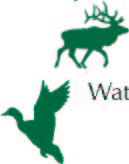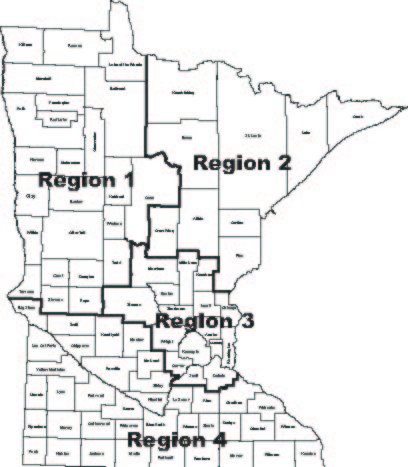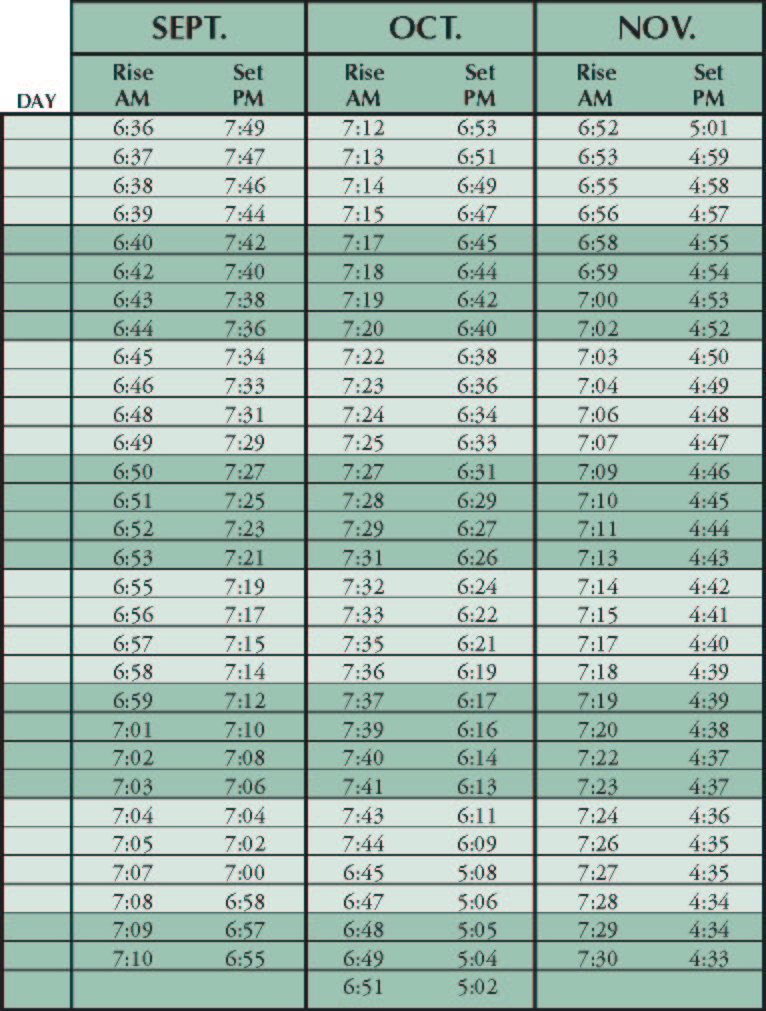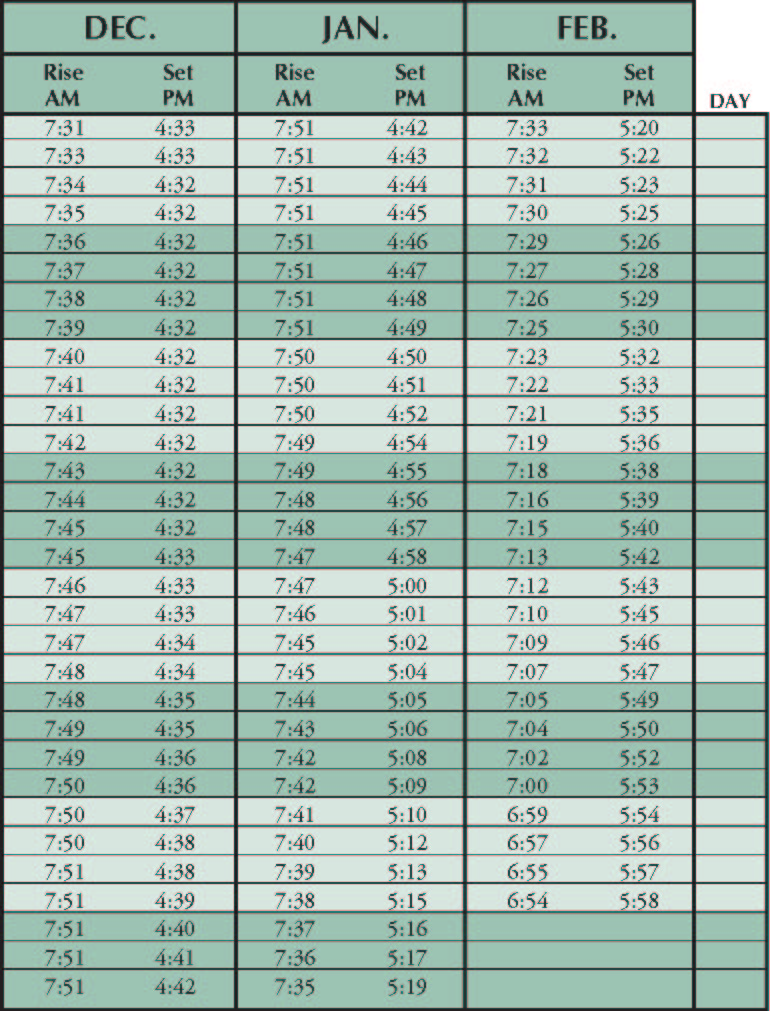QUESTIONS
Q. If I’m big game hunting in a state like Wisconsin, Colorado, Wyoming, Nebraska, or South Dakota where CWD has been found in free-ranging deer or elk, should I take any precautions in bringing back the carcass?
A. First of all, check and abide by all regulations for taking and trans-porting in the state where you take the animal. CWD endemic states may have specific regulations on how carcass parts can be transport ed out of endemic areas. Much remains unknown about CWD and how it is transmitted, and there may be additional regulations in the future. In the meantime, hunters taking animals from CWD positive states should consider only bringing the following carcass parts back into the state:
1) Meat that is boned out or that is cut and wrapped (either commercially or privately);
2) Quarters or other portions of meat with no part of the spinal column or head attached;
3) Hides;
4) Antlers or clean (no meat or tissue attached) skull plates with antlers attached;
5) Finished taxidermy mounts.
Q. If I see a field of Conservation Reserve Program (CRP) grassland that is not posted, do I need to get landowner permission to hunt there?
A. Yes. The 2001 Minnesota Legislature clarified that planted native or introduced grassland or hayland, and short-rotation woody crops, are defined as agricultural land for purposes of the outdoor recreation trespass law. This means permission is necessary whether they are posted or not. Private property should be treated with respect. Ask first before entering private lands.
Q. When I bought my small game license, I did not answer “yes” to the question asking if I planned to hunt migratory birds. Can I still legally hunt waterfowl, woodcock, snipe, or rails?
A. No. But that can be fixed. To legally hunt migratory birds, including ducks, geese, coots, woodcock, snipe and rails, hunters must be certi fied for the Harvest Information Program (HIP) on their small game license. Certification is accomplished by answering “yes” to the ques tion at license purchase indicating that you intend to hunt migratory birds. If your license does not say “HIP Certified” then you need to register for the HIP program to legally hunt migratory birds. Contact any ELS license agent and they will sign you up for HIP certification at no charge. See page 89 for additional information.
8
2002 Minnesota Hunting Regulations

Trespass is the most frequent complaint landowners have against hunters. Trespassing is illegal and can ruin hunters’ and the DNR’s rela tions with private landowners. This could in turn hamper habitat pro-grams, cut off land access, and possibly eliminate the future of hunting in many areas of Minnesota.
Always ask permission before entering private land. Any entry onto the private property of another without permission is considered trespass. Certain types of trespass have criminal penalties as outlined below. Additionally, landowners may be able to pursue court action against trespassers whether the property is posted or not. If you are caught trespassing, you may be issued a citation and assessed a fine under civil penalties, and repeat violators can lose their license or registration. Or, if you are convicted of violating trespass laws under criminal proce dures, you may lose your hunting privileges for up to two years, lose hunting equipment, and be subject to fines and possibly a jail sentence. All DNR conservation officers and all other licensed peace officers en-force trespass laws and may issue a citation to a person who trespasses in violation of the law or who removes a sign without authorization. A sum mary of the Minnesota Trespass Law begins below.
RESTRICTIONS (See below for exceptions, definitions, and posting requirements)
• A person may not enter legally posted land for outdoor recreation purposes without permission.
• A person may not enter agricultural land for outdoor recreation pur poses without permission.
• A person may not remain on private land for outdoor recreation purposes after being told to leave.
• On another person’s private land or a public right-of-way, a person may not take a wild animal with a firearm within 500 feet of a build ing occupied by humans or livestock without written permission.
• A person may not take a wild animal with a firearm within 500 feet of a corral containing livestock without permission.
• A person may not take a wild animal on any land where the person is prohibited from lawfully entering by this law.
• A person may not wound or kill another person’s domestic animal, destroy private property, or pass through a closed gate without return ing it to the original position.
10
2002 Minnesota Hunting Regulations
Exceptions
• A person on foot may, without permission, enter land that is not posted to retrieve a wounded animal that was lawfully shot, but may not remain on the land after being told to leave.
• A person on foot may, without permission, enter private land without a firearm to retrieve a hunting dog. After retrieving the dog, the person must immediately leave the premises. This excep tion does not authorize the taking of the wild animal.
DEFINITIONS AND POSTING REQUIREMENTS
• “Outdoor Recreation” means any activity including hunting, fishing, trapping, boating, hiking, camping, and engaging in winter sports which is conducted primarily for the purposes of pleasure, rest or relaxation and is dependent on or derives its principal benefit from natural surroundings.
• “Agricultural land” is land that: 1) is plowed or tilled; 2) has standing crops or crop residues; 3) is within a maintained fence for enclosing domestic livestock; 4) is planted to native or introduced grassland or hay land; or 5) is planted to short-rotation woody crops (hybrid poplar and other woody plants that are harvested for their fiber within 15 years of planting).
☞ IMPORTANT NOTE: All planted grassland and hayland and all hybrid poplar and other woody plants that are harvested for their fiber within 15 years of planting meet this definition, including grasslands enrolled in the federal Conservation Reserve Program (CRP), Conservation Reserve Enhancement Program (CREP), or the state Reinvest In Minnesota (RIM) Reserve program. These lands do not need to be posted to prevent unauthorized trespass. However, land that is brush or trees, including CRP, CREP, and RIM Reserve that is brush or trees, (except short-rotation woody crops as defined above) does not meet this definition and must be posted or verbal notice given to trespassers for criminal enforcement to occur. Hunters and trappers: Always respect private lands. Ask first before entering lands not posted as being open to hunting and trapping. You will improve relationships between landowners and recreationists, and you will have a more enjoyable time in the field.
• To be legally posted, land must have signs:
—posted once each year that state “no trespassing” or similar terms either: 1) along the boundaries every 1,000 feet or less, or in wooded areas where boundaries are less clear, at intervals of 500 feet or less; or
2) at the primary corners of each parcel of land and at access roads and trails at points of entrance to each parcel, except corners only
Continued on next page.
12
Trespass Law
accessible through agricultural land need not be posted. —with lettering at least 2 inches high and the signature or the legible name and telephone number of the owner, occupant, lessee, or authorized manager. An unauthorized person may not post land with signs prohibiting outdoor recreation or trespass.
• Notification to stay off private land, authorization to remove a sign posted to prevent trespass, or legal permission to enter private land or to take wild animals near occupied buildings or corrals, may only be given by the owner, occupant, or lessee.
Penalties
• Violating the Minnesota Trespass Law can make you subject to either civil or criminal penalties:
• Civil penalties are: 1) $50 for the first violation; 2) $200 for the second violation in a 3-year period; 3) $500 and loss of every license and registration being used for a third or subsequent violation in a 3-year period; and 4) $50 for unauthorized removal of a sign posted under this law.
• Criminal penalties are at least a misdemeanor for violation of this law. In addition, it becomes a gross misdemeanor to: knowingly disregard signs prohibiting trespass, trespass after being told not to do so, or to violate the trespass law twice within a three-year period. Anyone convicted under criminal procedures of violating the trespass law while hunting, fishing, trapping, or snowmobiling will have the applicable license and registration for that activity revoked. Anyone convicted of a gross misdemeanor under this law will have all hunting privileges suspended for two years.
Rules of Thumb for Water Access and Recreational Use
These are simple rules of thumb and are not intended to address all water access and recreational use situations. If you have doubts about whether you may be trespassing on private land, we recommend that you ask the landowner for permission.
1.What is lawful access? A stream or lake is lawfully accessible if there is a public access, or if public land or a public road right-of-way abuts the surface of the water, or if you have permission to cross private land to reach the surface of the water.
2.What is recreational use? Recreational use includes boating, swimming, fishing, hunting, trapping, and similar activities. It includes walking in the water in connection with such activities regardless of who owns the land beneath the surface of the water.
13
2002 Minnesota Hunting Regulations
3.What waters are open to recreational use? A stream or lake is open to recreational use over its entire surface if it is capable of recreational use and if it is lawfully accessible. Any water that will float a canoe is capable of recreational use, but other waters may also qualify depending upon the circumstances.
Landowner Liability (Minn. Stat. 604A.23)
An owner who gives written or oral permission for the use of the land
for recreational purposes without charge does not, by that action:
• extend any assurance that the land is safe for any purpose,
• confer upon the person the legal status of an invitee or licensee to whom a duty of care is owed, or
• assume responsibility for or incur liability for any injury to the person or property caused by an act or omission of the person.
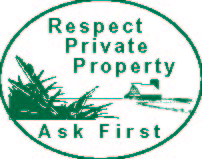

14
Ethics

“A peculiar virtue in wildlife ethics is that the hunter ordinarily has no gallery to applaud or disapprove of his conduct. Whatever his acts, they are dictated by his own conscience, rather than by a mob of onlookers. It is difficult to exaggerate the importance of this fact.” —Aldo Leopold
Written more than 50 years ago, the words of environmentalist and hunter Aldo Leopold still ring true today. Although ethics are a private matter, the unethical behavior of one individual can ruin hunting for others. Please act responsibly and help pass on an ethical hunting tradition.
ATVs, SNOWMOBILES, AND OTHER OFF-ROAD VEHICLES
The mixture of off-road motor vehicles and hunting on public lands has proven to be volatile. It presents one of the biggest challenges of how to responsibly use technology while maintaining a conservation ethic and mutual respect among users of the outdoors. A variety of regulations, as outlined below, are intended to address some of these issues, but the real key to attaining mutual respect and understanding is the behavior of each individual user of these vehicles and of others who share the woods and fields of Minnesota.
Each user of off-road motor vehicles and each hunter is responsible for knowing and obeying the laws and regulations. However, in addition to following the law, it is important for motorized users to show respect and consideration for other hunters and outdoor users, and for those not using motorized vehicles to recognize and respect that off-road vehicles, when used legally and responsibly, have a legitimate place in Minnesota’s outdoors. The challenge is to find ways to compatibly share our outdoor resources in ways that promote conservation and achieve mutual respect.
The summary below provides a simple guide to the existing off-road vehicle rules and regulations related to hunting and trapping found in this handbook:
• General restrictions on ATVs and snowmobiles: page 29
• Use of ATVs and snowmobiles during firearms deer season: page 57
• Use of ATVs, snowmobiles, and other vehicles in Wildlife Management Areas: pages 111-113
• Use of ATVs and motor vehicles on State Forests: page 119-120
• Use of motor vehicles on federal lands: pages 123
• Shooting at grouse near motor vehicles prohibited: page 37.
15
2002 Minnesota Hunting Regulations

These are general license requirements. For license requirements to take specific species, refer to the other sections of this booklet.
Continued on next page.
2002 Hunting and Trapping License Fees

* Available through lottery drawings only, except the No-Quota Bear License (see page 81).
** Includes a $4 surcharge used for wildlife land acquisition and management. 16
License Requirements

PURCHASE AND POSSESSION Electronic Licensing The Electronic Licensing System (ELS) enhances customer ser vice and improves natural resource and licensing management. The system uses a point of sale (ELS-POS) terminal at any of 1,800 ELS-POS license agent locations throughout Minnesota to issue all types of hunting, fishing, and trapping licenses and to take applications for hunting lotteries (such as antlerless deer, wild turkey, and so on). Instant licensing is also available by telephone and by internet (see page 19). Here are some key things you need to know about the ELS:
• ELS-POS license agents can be found at more than 1,800 locations throughout Minnesota. The names and locations of these agents are posted on the DNR web page (www.dnr.state.mn.us), or can be obtained from the DNR Information Center (see number on page 129).
• ELS special license agents are ELS-POS agents who have been authorized to handle special license types (such as disability,
17
2002 Minnesota Hunting Regulations
foreign exchange student, veterans, military, landowner, and firearms deer replacement licenses). Find ELS special license agents by checking the DNR web page or by calling the DNR Information Center.
☞ • Instant licensing is available 24 hours a day, 7 days a week via an ELS-Telephone System by calling 1-888-MNLICENse (1-888-665-4236) or via ELS-Internet at the DNR web page (www.dnr.state.mn.us). Instant licensing for licenses requiring a tag (such as deer or wild turkey) may be purchased via tele phone or internet, but a person may not hunt before receiving the license in the mail and having it in possession.
• Residents must meet legal residency requirements and must provide their MN Driver’s License, MN Public Safety ID, or MN Firearms Safety Certificate number, or provide a Snowmobile Safety Certificate or DNR number from a prior ELS license to obtain a license.
• Nonresidents must provide their nonresident driver’s license number, Minnesota DNR number from a prior ELS license, or social security number to obtain a license.
• The printed ELS licenses have a backing on the adhesive side that contains important information. After purchase, customers should fold the license without taking off the backing. The backing should be removed only when using the squares as carcass tags or shelter tags.
• Stamp validations (waterfowl, pheasant) printed on the license are valid for hunting for 30 days after issuance. The DNR will mail the pictorial stamp to the customer. At that time, the customer must sign the face of the pictorial stamp and carry both the signed pictorial stamp and the stamp validation when engaged in that license activity as required by law. Stamp vali dations for wild turkey are valid for hunting without a pictorial stamp (purchasers can request the optional pictorial stamp for an additional $2, but it is not needed for hunting).
• HIP Certification for legally taking migratory game birds must be printed on your license (see page 89).

18
License Requirements
• Public Record Notice. Most of the data that you supply when buying a license becomes a public record. If you do not wish to have this data made available for bulk mailings, contact the DNR at (651) 296-6157 (Twin Cities Metro Area), 1-888-646-6367 (toll free), or info@dnr.state.mn.us.
• Buy early: Customers are advised to avoid delays by buying early and far ahead of license or application deadlines.
License Possession
• All persons required to have a license (including stamps or stamp validations) must have it in their personal possession while hunting or trapping and while traveling from an area where they hunted or trapped.
• A person may not take, buy, sell, transport, or possess protected wild animals without a license, except as provided in this booklet.
License Year
Licenses are valid during legal seasons between March 1 and the end of February. New licenses are required beginning March 1 each year.
Purchase
Minnesota Small Game and Deer Hunting licenses, Special Canada goose permits, state Migratory Waterfowl Stamps, and Pheasant Stamps can be purchased from ELS license agents and the DNR License Center in St. Paul. Wild turkey, moose, antlerless deer, and most bear licenses are awarded through a statewide lottery. Appli cations are made through ELS license agents or the DNR License Center in St. Paul.


Border Waters On all border waters with adjacent states or provinces, persons acting under a Minnesota hunting or trapping license may only take wild animals on the Minnesota side of the border.
19
2002 Minnesota Hunting Regulations
Revocation of Hunting Privileges
• Small game hunting privileges may be revoked for one year for two or more convictions for a violation under a license to take small game within a three-year period.
• Big game hunting privileges may be revoked for three years for any of the following violations:
1. Two or more convictions of any violation relating to big game animals within a three-year period.
2. One conviction of any of the following: shining while in posses sion of a firearm or bow; knowingly transporting an illegally taken big game animal; hunting, taking, transporting or possessing big game without the required license; over limit of big game; hunting, taking or possessing big game in closed season; buying or selling big game animals (revocation of all privileges if sale is over $300).
• Big game and small game hunting privileges may be revoked for five years for hunting while under the influence of alcohol or a controlled substance.
• Violations of hunting laws in other states may affect your hunting privileges in Minnesota.
Lost License You may obtain a duplicate license at any ELS license agent or
from the DNR License Center in St. Paul. The fee is $5.75 for a
duplicate Big Game License and $2.50 for all others.
Replacement Firearms Deer Licenses A person who has purchased a firearms deer license (other than
an all-season deer license) and wishes to change a zone or season
option before November 9 may submit their original license and
obtain a replacement license for a different zone or season option.
There is a fee of $5 (plus a $1 issuing fee) for the replacement license,
plus any increase in cost for the new license. Replacement licenses are
available from any ELS special license agent.
FIREARMS SAFETY CERTIFICATES

20
License Requirements
• A Firearms Safety Certificate will not be issued to anyone under age 12.
• Anyone under age 14 must be accompanied by a parent or guardian to hunt or trap. “Guardian” means a legal guardian or someone age 18 or older selected by the parent or legal guardian to supervise the youth.
• A person on active duty who has successfully completed basic training in the U.S. Armed Forces, Reserves, or National Guard may purchase a license or obtain approval that authorizes hunting without possess ing a Firearms Safety Certificate.
• A duplicate of a lost or destroyed Minnesota Firearms Safety, Snowmobile, or ATV Safety Certificate can be obtained at any ELS license agent. A duplicate certificate is $3.50.
RESIDENTS
A Minnesota resident is defined as follows:
• A United States citizen or resident alien who has maintained a legal residence in the state for at least 60 consecutive days before purchasing a license, or
• A person in the U.S. Armed Forces who is stationed in the state, or
• A nonresident under age 21 whose parent is a Minnesota resident. Military Personnel
• Residents who have maintained legal residency in Minnesota and who are serving in the U.S. Military and stationed outside the state may hunt small game without a license while on leave. They do not need a Minnesota Waterfowl Stamp or Pheasant Stamp but must have a Federal Duck Stamp to hunt waterfowl. They may hunt deer, bear, and wild turkeys without charge after obtaining the appropriate licenses and tags from an ELS special license agent by presenting official leave papers, except they may not obtain moose, all-season buck, or multi-zone buck licenses or deer man agement permits. Such service personnel must carry official leave papers on their person while hunting.
• Residents discharged from the U.S. Armed Forces during or within 10 days before the Firearms Deer Season may purchase a Firearms Deer License during the season upon showing official discharge papers. The license is valid immediately after purchase.
• Resident veterans with proof of a 100 percent service-related dis ability may obtain a free Small Game License and a free Firearms or Archery Deer License from an ELS special license agent.

21
2002 Minnesota Hunting Regulations
Note: Military personnel who are issued firearms deer licenses under these provisions may take antlerless deer, but are restricted to bucks-only hunting in those anterless permit areas that have an anterless permit quota of zero, and during the Zone 3A season. To participate in special deer hunts, they must apply and be drawn (see page 71). To purchase deer management permits, they must apply for and receive antlerless permits and an authorization to purchase a management permit. See fold-out map between pages 66-67.
NONRESIDENTS General
• All nonresidents, regardless of age, must have an appropriate hunt ing license to hunt in Minnesota. A nonresident under age 16 may obtain a small game license at the resident fee if the nonresident possesses a firearms safety certificate or, if age 13 or under, is accompanied by a parent or guardian when purchasing the license. A nonresident age 13 or under must be accompanied by a parent or guardian to take small game.
• Applications allowing nonresidents to purchase licenses by mail are available from the DNR License Center or on the DNR website (addresses on page 129).
• Purchase hunting licenses by telephone or internet (after Oct. 1): Call 1-888-MNLicense (1-888-665-4236) or go to www.dnr.state.mn.us. See box on page 19 for additional information.
• Nonresidents may not trap in Minnesota.
• Nonresidents may not take raccoon, bobcat, gray fox, red fox, or coyote without first buying a nonresident Furbearer Hunting License and a nonresident Small Game License.
• Note to deer hunters: A Deer License issued after the opening day of the respective season (archery, regular firearms, or muzzleloader) is not valid until the second day after it is issued.
Students
• Nonresident, full-time students at a Minnesota educational insti tution who live in the state during the school year may purchase a resident Small Game, Deer, or Bear License with proof of student status.
• A full-time high school foreign exchange student who resides with Minnesota residents may buy a resident license to take deer or bear.
22
License Requirements
STAMPS Most hunters must possess the appropriate stamps to hunt pheasants
and waterfowl in Minnesota (see below). Stamp validations printed on
electronically issued licenses are valid for 30 days. The actual stamp
will be mailed to the hunter. For a stamp to be valid, hunters must
sign their name across its face. Federal stamps must be signed in ink.
o
Pheasant Stamp Resident hunters age 18 or over and under age 65, and all nonresi
dent hunters, must have a valid Minnesota Pheasant Stamp or valid
stamp validation (valid for 30 days after purchase only) in their pos
session when hunting or taking pheasants, except: a) residents hunting
on land they occupy as a principal residence, b) a person hunting on a
licensed commercial shooting preserve, or c) residents on military
leave.
Wild Turkey Stamp
See page 102.
State Migratory Waterfowl Stamp Resident hunters age 18 or over and under age 65, and all nonresi
dent hunters, must have a valid Minnesota Migratory Waterfowl Stamp
(State Duck Stamp) or valid stamp validation (valid for 30 days after
purchase only) in their possession while hunting or taking migratory
waterfowl (see definition, page 85), except: a) residents who are hunting
on their own property, b) persons taking only marked waterfowl released
on a commercial shooting preserve, or c) residents on military leave.
Federal Migratory Waterfowl Stamp Waterfowl hunters age 16 and over must have a valid Federal
Duck Stamp in their possession while hunting or taking migratory
waterfowl. Federal Duck Stamps can be purchased at post offices or
from many license agents.

23
2002 Minnesota Hunting Regulations
Resident Youth License and Safety Certificate Requirements
Must be accompanied by parent or legal guardian. ** Age 18 and up must have a regular Trapping License. ▲ Except persons hunting on their own land.
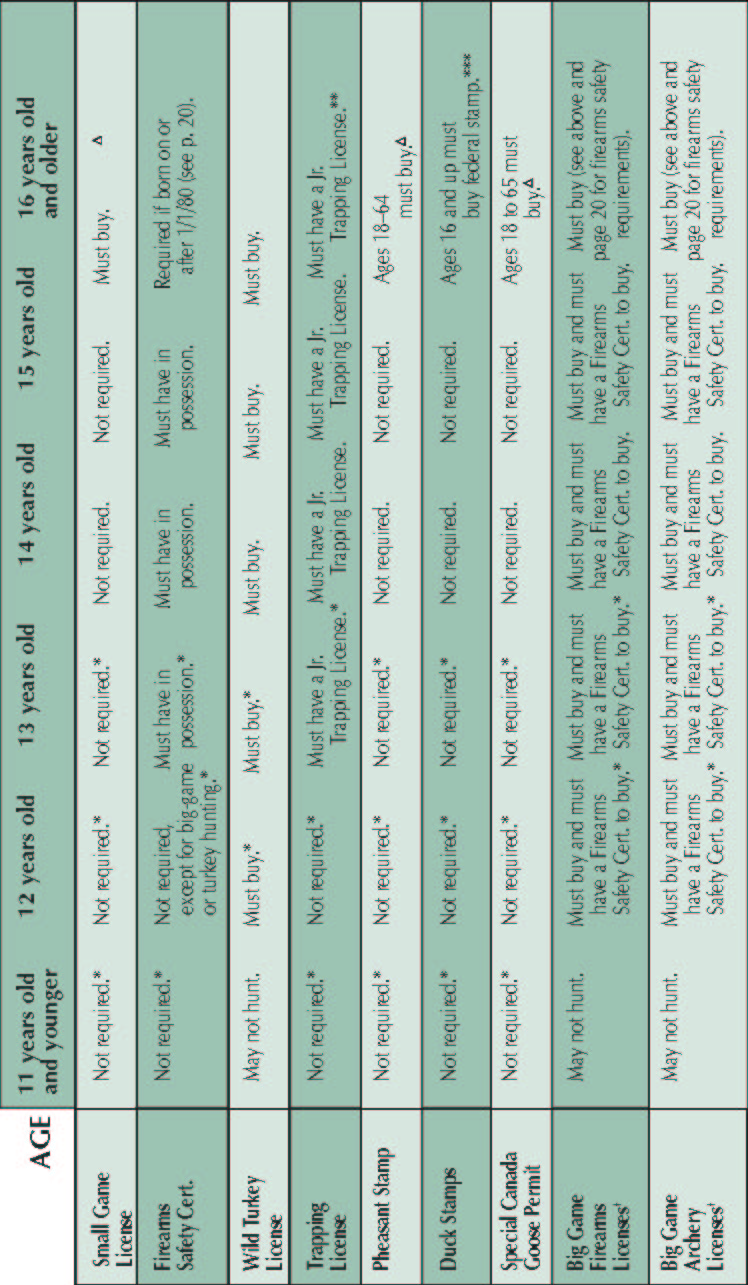
*
*** Age 18 and up must also buy a state stamp, except persons hunting on their own land.
Youth under age 16 may not hunt moose.
TYPE OF LICENSE
24
General Hunting Information

The following are general hunting regulations. Specific regulations for various game species are in the Big Game, Small Game, Trapping, Water-fowl, and Wild Turkey sections of this booklet.
BLAZE ORANGE REQUIREMENTS
A visible portion of at least one article of clothing above the waist must be blaze orange for anyone taking small game, except for those hunting wild turkeys, migratory birds, raccoons or predators, or when hunting with nontoxic shot or while trapping. This restriction does not apply to persons hunting by falconry. In addition, all hunters and trappers must wear blaze orange clothing in areas open under applicable laws and ordinances to firearms deer hunting, (including the Muzzle-loader Season), except for migratory waterfowl hunters on waters or in a stationary shooting location, or trappers on waters. See page 31-32 for additional details.
ARMS RESTRICTIONS Firearms Transportation
A person may not transport a firearm, including a handgun, in a motor vehicle unless the firearm is:
• unloaded* and cased,** or
• unloaded* and in the closed trunk of a motor vehicle.
Transportation of Bows
No person may transport an archery bow in a motor vehicle unless the bow is:
• unstrung, or
• completely contained in a case, or

* An “unloaded” firearm is defined as a firearm without ammunition in the barrels and magazine, if the magazine is in the firearm. A muzzle-loading firearm with a flintlock ignition is unloaded if it does not have priming powder in a pan. A muzzle-loading firearm with percussion ignition is unloaded if it does not have a percussion cap on a nipple.
** A “cased” firearm is defined as a firearm in a gun case expressly made to contain a firearm, when the case fully encloses the firearm by being zipped, snapped, buckled, tied, or otherwise fastened, with no portion of the firearm exposed. A holster is not a legal case.
25

2002 Minnesota Hunting Regulations
• in the closed trunk or rear-most enclosed portion of a motor vehicle that is not accessible from the passenger compartment.
Handguns Persons age 18 or older may carry a handgun in the woods and
fields or upon waters to hunt or target shoot. The carrying of hand-
guns elsewhere in the state or by persons under age 18 is subject to
special restrictions and may require a handgun permit. A person may
not carry a handgun while bowhunting except a person may take bear
by archery while in possession of a firearm. Questions regarding hand-
guns should be directed to local law enforcement authorities.
o
Crossbows A person may not hunt with a crossbow or possess a crossbow
outdoors or in a motor vehicle during the open season for any game
unless the crossbow is unstrung and in a case, or in the closed trunk
of a motor vehicle, except for disabled persons with a valid crossbow
permit (see page 50).
o
Explosive and Poisoned Arrows A person may not hunt with poisoned (drugged) or explosive-
tipped arrows.
o
Silencers A person may not own or possess a silencer for a firearm or a fire-
arm equipped to have a silencer attached.
o
Possession of Firearms Before, During, and
After the Firearms Deer Season (Note: This section does not apply to the Muzzleloader Season, see page 75, except that muzzleloaders legal for deer may be possessed only by persons with a muzzleloader or all-season buck license during that season.) No person may possess a firearm or ammunition outdoors during
the period beginning the fifth day before the open firearms season and
ending the second day after the close of the season within an area
where deer may be legally taken by firearms (see page 32), except: • A person who has a valid firearms big game license in possession may hunt big game during the open season with a firearm and ammunition authorized for big game.
• Possession is also legal under these conditions:
a) An unloaded firearm that is in a case or in a closed trunk of a motor vehicle.
b) A shotgun and shells containing No. 4 buckshot or smaller diameter lead shot or nontoxic shot.
Continued on next page.
26
General Hunting Information
c) A .22 caliber rimfire handgun or rifle with .22 caliber short, long, or long rifle cartridges.
d) Handguns possessed by a person with a handgun permit for the purpose authorized.
e) On an authorized target range.
“TAKING” DEFINED
“Taking” means pursuing, shooting, killing, capturing, trapping, snaring, angling, spearing, or netting wild animals; or placing, setting, drawing, or using a net, trap, or other device to take wild animals. Taking also includes attempting to take wild animals or assisting another person in taking wild animals.
“POSSESSION” DEFINED
Game animals are in a person’s possession whether on hand, in cold storage, in transport, or elsewhere.
PROTECTED ANIMALS
The following birds and mammals are protected in Minnesota by state or federal laws:
Protected Birds
• All birds for which seasons are established in these regulations are protected birds but may be taken as authorized.
• There is no open season on bobwhite quail, prairie chickens, cranes, swans, mourning doves, hawks, owls, eagles, herons, bitterns, cormorants, loons, grebes, or any other species of birds except unprotected birds.
Crows
• Crows may be taken without a license in season or at any time when they are doing or are about to do damage.
• Electronic calls or sounds may be used for crow hunting. During closed season, calls or decoys may not be used.
• Crows may be taken with a legal firearm (shotgun not larger than 10 gauge, rifle, or handgun), bow and arrow, or by falconry.
• Wildlife Management Areas are closed to crow hunting from March 1–August 31.
Protected Mammals
• All mammals for which seasons are established in these regulations are protected mammals, but may be taken as authorized.
• There is no open season on caribou, antelope, lynx, gray wolf, wolverine, cougar, or spotted skunk (“civet cat”).
27

2002 Minnesota Hunting Regulations
Taking Protected Species
• No protected species may be taken in any manner in any area of the state except in accordance with these regulations.
• All protected species must be killed before being removed from the site where taken.
UNPROTECTED ANIMALS
Residents are not required to have a license to take unprotected species.
Unprotected Mammals Weasels, coyotes, gophers, porcupines, striped skunks, and all
other mammals for which there are no closed seasons or other protec
tion are unprotected animals. They may be taken in any manner,
except with the aid of artificial lights or by using a motor vehicle to
drive, chase, run over, or kill the animal. Poisons may not be used
except in accordance with all label regulations of the state Dept. of
Agriculture and federal Environmental Protection Agency.
Unprotected Birds House sparrows, starlings, common pigeons, chukar partridge,
quail other than northern bobwhite, mute swans, and monk parakeets
are unprotected and may be taken at any time.
GENERAL RESTRICTIONS Motor Vehicles
 • No person may take a wild animal with a firearm or by archery from a motor vehicle except a disabled person with an appropriate permit. A disabled person with a permit to shoot from a stationary motor vehicle may take a deer of either sex without an antlerless permit except in the Zone 3A season and in those Antlerless Permit Areas where no permits are offered. Other members of the hunting party may not shoot antlerless deer for the disabled person.
• No person may take a wild animal with a firearm or by archery from a motor vehicle except a disabled person with an appropriate permit. A disabled person with a permit to shoot from a stationary motor vehicle may take a deer of either sex without an antlerless permit except in the Zone 3A season and in those Antlerless Permit Areas where no permits are offered. Other members of the hunting party may not shoot antlerless deer for the disabled person.
• Permits to shoot from a stationary motor vehicle may be issued to a person who obtains the required licenses and who has a perma nent physical disability that is more substantial than discomfort from walking. The permit recipient must: be unable to step from a vehicle without aid of a wheelchair, crutches, braces, or other mechanical support or prosthetic device; or be unable to walk any distance because of a permanent lung, heart, or other internal dis ease that requires the person to use supplemental oxygen to assist breathing. The permanent disability must be verified in writing by a licensed physician or chiropractor. In addition to providing the
28
General Hunting Information
medical evidence of permanent disability, the applicant must possess a valid disability parking certificate or license plates. Permit applications are available from any DNR regional office or by calling the information numbers on page 129.
• No person may use a motor vehicle to intentionally drive, chase, run over, or kill any wild animal. Road-killed animals may not be legally possessed, except by special permit from a DNR conserva tion officer.
• Shooting from a motor vehicle or cycle is unlawful. All-Terrain Vehicles (ATVs*) and Snowmobiles
• The use of all-terrain vehicles, cycles, and snowmobiles is forbid-den in many areas, including most Wildlife Management Areas. Also, their use is regulated in state forests. See pages 119-120 for details. The user is responsible for knowing and obeying all laws pertaining to ATV and snowmobile use.
• A person may not transport an uncased firearm on or shoot at a wild animal from an all-terrain vehicle or cycle.
• Additional restrictions apply during the grouse and deer seasons (see pages 37 and 57).

* ATV means all vehicles not requiring Minnesota Dept. of Trans portation licensing, including trail bikes, 3-wheelers, 4-wheelers, 6-wheelers, tracked vehicles, and other similarly manufactured or homemade vehicles.
Dog Training
A person may not train hunting dogs afield from April 16 to July 14, except by special permit. A person may obtain a special permit from a DNR conservation officer, without a fee, to train hunting dogs afield on land owned by the trainer or on other land with written per-mission of the owner. The written permission must be carried while training the dogs.
A person training a dog afield and carrying a firearm may only have blank cartridges and shells in possession when the season is not open for any game bird, except by permit. An organization or indi vidual may obtain a free permit to use firearms and live ammunition on domesticated birds or banded game birds from game farms for holding field trials and training hunting dogs.
Dogs Pursuing Big Game
No persons may allow their dog to chase or kill big game.
Between January 1 and July 14 a dog that is observed wounding, killing, or pursuing in a way that endangers big game may be killed
29
2002 Minnesota Hunting Regulations
by any person. A peace officer or conservation officer may kill a dog that endangers big game at any time of the year. The officer or person is not liable for damages for killing the dog.

Hunting While Under the Influence
A person may not take protected wild animals with a firearm or by archery while under the influence of alcohol or a controlled substance.
Wanton Waste
A person may not wantonly waste or destroy a usable part of a protected wild animal unless authorized.
Ferrets
A person may not take protected animals with the aid of a ferret.
Radios
• Using radio equipment to take big game or small game is unlawful.
• A DNR permit is required to take unprotected animals with the aid of radio equipment.
Lands Closed to Hunting
A person may not hunt within state Game Refuges, State Parks, Scientific and Natural Areas, or other lands closed to hunting, except as provided in these regulations.
o
English Language Required
All reports, forms, tags, or signs required by these regulations must be completed in the English language.
o
Multiple Applications
A person may not submit more than one application in a drawing for a permit or license.
o
Dates and Times Inclusive
All dates and times specified in these regulations are inclusive unless specified otherwise.
GIFTS
Lawfully taken wild animals may be transferred as a gift if accompa nied by a receipt containing: name and address of the owner; name and address of the recipient, date of transfer, description of the gift (for example: “Three 1-pound venison steaks”) and the license number under
30
☞
General Hunting Information
which the animal was taken. The receipt must remain with the gift.
GAME FOR CONSUMPTION AT FUND RAISING EVENTS
Nonprofit organizations may charge a fee for admission to fundraising events when lawfully taken and possessed big game and small game (excluding migratory game birds that cannot be sold under federal law), is donated to the organization and is served for consumption on the premises where the fundraising event is held.
Game donated to the nonprofit organization must be marked as pro vided in the “gift” section above. The nonprofit organization must keep records as required by law of the game donated to the organization, and the records must be available for inspection for two years from the date of the fundraising event. SALE OF ANIMAL PARTS
Except as otherwise provided in these regulations, a person may possess, transport, buy, or sell the following inedible portions of lawfully taken or acquired big game, furbearers, and game birds (other than migratory birds): bones (including skulls), sinews, hides, hooves, teeth, claws, and antlers. A person may not sell bear meat or organs (including gall bladders) and may not sell bear paws unless attached to the hide.
A person may sell the pelts of lawfully taken furbearers. A person may not buy raw furs without a fur buyer’s license, except a fur manufacturer or licensed taxidermist may buy raw furs from a licensed fur buyer.

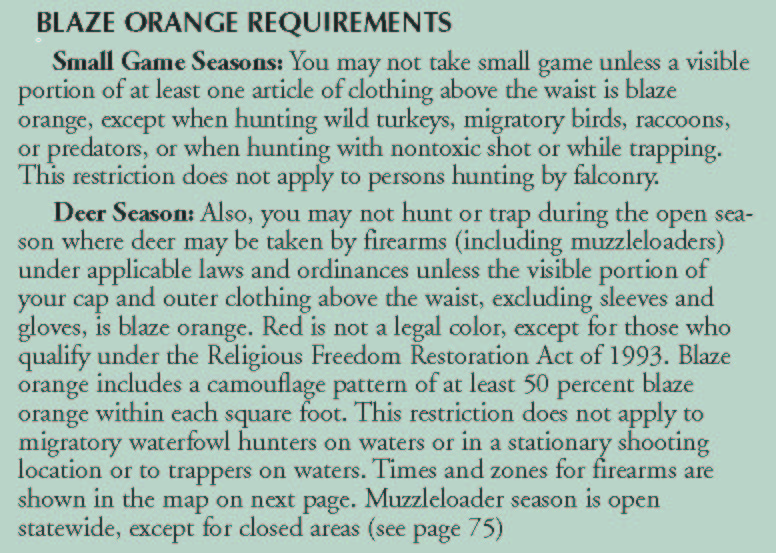
31
2002 Minnesota Hunting Regulations
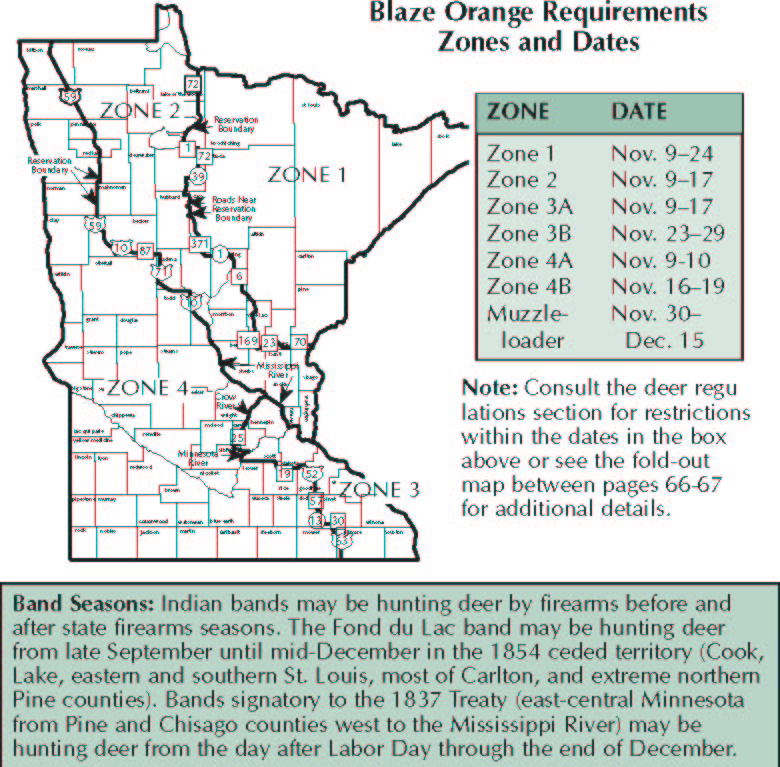
ARTIFICIAL LIGHTS
A person may not cast the rays of a spotlight, headlight, or other artificial light onto a highway or into a field, woodland, or forest to spot, locate, or take a wild animal while possessing, either individually or as one of a group, a firearm, bow, or other implement that could be used to kill big game. The exceptions to this regulation are:
a) A firearm that is unloaded, cased, and in the closed trunk* of a motor vehicle (see definitions of “unloaded” and “cased,” page 25); or
b) A bow that is completely encased or unstrung and in the trunk* of
a motor vehicle. Violation of this section is a gross misdemeanor.
• With or without a firearm or bow, no person may cast the rays of
32
General Hunting Information
a spotlight, headlight, or other artificial light into a field, wood-
land, or forest to spot, locate, or take a wild animal between the
hours of 10 p.m. and 6 a.m. from September 1 to December 31. • With or without a firearm, between one-half hour after sunset until sunrise, a person may not cast the rays of a spotlight, headlight or other artificial light to spot, locate, or take a wild animal on fenced, agricultural land containing livestock or poultry that is marked with signs prohibiting the shining of lights. The signs must: 1) display reflectorized letters that are at least two inches in height and state “no shining” or similar terms; and 2) be placed at intervals of 1,000 feet or less along the boundary of the area.
• It is not a violation of this law to shine lights while doing any agri cultural, occupational, or recreational activity, including snow mobiling, not related to spotting, locating, or taking a wild animal.
• With or without a firearm, between the hours of 6:00 p.m. and 6:00 a.m., a person may not project a spotlight or hand-held light onto residental property or building sites from a moving motor vehicle being operated on land, except for the following purposes:
1) safety; 2) emergency response; 3) normal vehicle operations; or
4) performing an occupational duty.

* If the motor vehicle does not have a trunk, the firearm or bow must be in the rear-most portion of the vehicle. Note: This regulation does not apply to taking raccoons or tending
traps according to all other regulations in this booklet.
DUTY TO RENDER AID
A person who shoots and injures another person with a firearm, or has reason to believe that another person might have been injured, and any witnesses to such a shooting, must immediately investigate the extent of the person’s injuries and give reasonable assistance, including calling law enforcement or medical personnel to the scene. Failure to do so can result in imprisonment and a fine for the shooter and witnesses.
ENFORCEMENT
• DNR conservation officers and other peace officers may arrest, with-out a warrant, any person detected in the actual violation of wildlife, fish, or water laws and may enter any lands to carry out these duties.
• No person may hinder, resist, or obstruct an enforcement officer or authorized DNR agent in the performance of official duties.
• A person must allow inspection of firearms, licenses, wild animals, motor vehicles, boats, or other conveyances used while taking or transporting wild animals.
o
33
General Hunting Information
SHIPPING BY COMMON CARRIER (COMMERCIALTRANSPORTATION)Statements and Receipts Required for Shipping
• A person who transports wild animals or raw furs by common car rier (commercial transportation), including animals carried in bag-gage, must attach a statement to each shipment. The statement must include the name, address, and license number of the person shipping the animals, the number and species of the animals and furs in the shipment, and the signature of the licensee.
• The waybill or receipt issued by a common carrier to a shipper must specify the number and species of wild animals being shipped.
Shipments by Residents to Themselves
• Residents may transport wild animals within the state by common carrier if they have the licenses required to take the animals and the shipment is made to themselves. The wild animals that may be transported by common carrier are: deer, bear, moose, “undressed” game birds (see page 42 for definition), and fish.
• Residents who ship game birds to themselves may not make more than three shipments during a license year. A shipment may not contain more than the resident’s daily limit.
Shipments by Nonresidents to Themselves
• Nonresidents may transport wild animals by common carrier without being in the vehicle if they have the license required to take the animals and the shipment is made to themselves.
• Nonresidents who ship game birds to themselves by common carrier without being in the vehicle must obtain a shipping permit (free) from a DNR conservation officer.
Shipments to Other Persons
• A person may ship game birds to another person if the shipper is licensed and obtains a permit from a DNR conservation officer.
HUNTING WITH DISABILITIES (Front Cover Photo)
Steve Scheunemann is one of many hunters who is able to hunt despite a serious physical handicap, thanks to the efforts of private indi viduals and organizations and the Minnesota DNR. Landowners like Richard Storlie of Spring Grove work with the group Capable Partners to provide hunting opportunities on their property for physically handi capped hunters. And, DNR staff such as Assistant Area Wildlife Manager Don Ramsden of Winona help develop special hunts and blinds on pub lic lands for disable hunters. When individuals and organizations join hands, more doors to opportunity can be opened.
Persons with disabilities may be granted special permits or exceptions
to some hunting regulations: Crossbows: See pages 26 and 50. Motor Vehicles: See page 28. Grouse Hunting Near Motor Vehicles: see page 37. Special Seasons: See page 60. Federal Waterfowl Hunting: see page 99. Blinds at some major WMAs: See pages 112-113. 35Deer Stands, Agassiz and Big Stone NWR: See pages 123-125.


2002 Minnesota Hunting Regulations

MIGRATORY WATERFOWL
See pages 85 to 101.
LICENSE REQUIREMENTS Small Game Hunting
• All residents age 16 and over, and all nonresidents, must have a valid Small Game License in their possession to take small game, except residents may hunt small game without a license on their own land if they occupy it as their principal residence.
• All residents age 18 or over and under age 65, and all nonresident hunters, must have a valid Minnesota Pheasant Stamp or stamp validation in their possession to take pheasants. For exceptions, see page 22.
• All licensed hunters of migratory game birds (woodcock, rails, snipe, waterfowl, or coots) must identify themselves as migratory bird hunters at the time they purchase a small game or sports license and be HIP certified (see page 89).
• A nonresident must have a nonresident Furbearer Hunting License and a nonresident Small Game License to take raccoon, bobcat, gray fox, red fox, or coyote.
Trapping
• Every resident age 16 and over must have both a Small Game and a Trapping License in possession to take small game (including furbearers) with traps, except that persons may trap without a Small Game License on their own land if they occupy it as their principal residence. That person must still have a Trapping License.
• Residents age 13 through 17 must have a Jr. Trapping License and residents age 18 or over must have a regular trapping license to trap. Residents under age 13 do not need a trapping license.
• Nonresidents may not trap in Minnesota.
• No person may be issued more than one Trapping License in a license year (except duplicate licenses).
36
Small Game Hunting


GENERAL RESTRICTIONS
Blaze Orange Blaze orange is required for most small game hunting. See pages 25,
31 for specifics.
Grouse Hunting Near Motor Vehicles
• A person in the vicinity of a motor vehicle may not shoot a firearm or an arrow from a bow at a grouse, or at a decoy of a grouse placed by an enforcement officer, unless the person is at least 20 yards (60 feet) from the vehicle and the vehicle’s engine is shut off. This provision does not apply to a person with a disability who has a permit to shoot from a stationary motor vehicle (see page 28). This restriction includes all motorized vehicles.

Party Hunting for Small Game A “party” is defined as a group of two or more persons maintaining
unaided visual and vocal contact with each other while taking small
game. “Party hunting” means that members of a party may take animals
for other members’ limits. A party may lawfully take small game in
accordance with the following regulations: • A member of the party may take more than an individual limit, but the total number of small game taken and possessed by the party may not exceed the combined limits of members of the party.
• Each party member may transport only an individual limit of small game.
• Party hunting is not allowed for migratory game birds (ducks, geese, mergansers, coots, moorhens, woodcock, rail, and snipe).
• For wild turkey party hunting restrictions, see page 103. Migratory Bird Harvest Information Program (HIP)
• Woodcock, snipe, and rail hunters: see important information on this program on page 89.
Use of Lead Shot
• No person may take ducks, geese, mergansers, coots, or moorhens with lead shot or while having lead shot in possession.
• Lead shot may be used statewide for hunting other small game in accordance with firearms restrictions in this booklet, except in federal Wildlife Refuges and Waterfowl Production Areas (see pages 121-126). 37

HUNTING
Closed Sharp-tailed Grouse Area
The area shown on the map at right is closed to sharp-tailed grouse hunt ing. Few sharptails live in the area, and the closure protects remnant popula tions of sharptails and prairie chickens (a similar-looking, protected species).
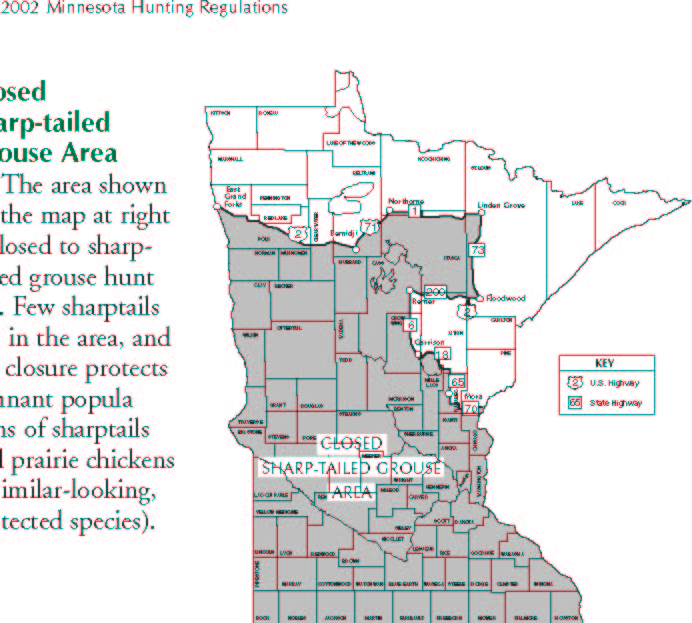
Woodcock, Rails, and Snipe
• Duck Stamps (state or federal Migratory Waterfowl Stamps) are not required to hunt woodcock, rails, or snipe.
• Compliance with the migratory bird harvest information program is required by indicating “yes” in response to the migratory bird hunting question on the license (see page 89).
• Shotguns used to hunt these birds must not be capable of holding more than three shells, unless plugged with a one-piece filler that cannot be removed without disassembling the gun, so its total capacity does not exceed three shells.
Prohibited Methods
• A person may not take a grouse while within 20 yards of a motor vehicle (see page 37).
• A person may not take protected birds by the following methods: with a trap, net, or snare; using bird lime; with a swivel or set gun; by dragging a rope, wire, or other device across a field; or by using fire.
• A person may not shoot pheasants or Hungarian partridge with a rifle or handgun other than a .22 caliber rimfire using short, long, or long rifle ammunition.
• A person may not set fire to a tree or use smoke to take squirrels or raccoons.
38
Small Game Hunting

2002 Small Game Hunting Seasons
*Rabbits, hares, and squirrels may also be taken **Crows may also be taken at any time whenever committing or about to commit damage.
| Small Game Open Season Daily Limit Possession Shooting/Hunting Hours Limit | Mammals* Cottontail Rabbit, Jack-Sept. 14–Feb. 28 10 combined 20 combined 1⁄2 hr. before sunrise to sunset rabbit and Snowshoe Hare Gray and Fox Squirrel Sept. 14–Feb. 28 7 combined 14 combined 1⁄2 hr. before sunrise to sunset | Non-Migratory Birds Ruffed and Spruce Grouse Sept. 14–Dec. 31 5 combined 10 combined 1⁄2 hr. before sunrise to sunset Sharp-tailed Grouse Sept. 14–Nov. 30 3 6 1⁄2 hr. before sunrise to sunset (in open zone) Hungarian Partridge Sept. 14–Dec. 31 5 10 1⁄2 hr. before sunrise to sunset Pheasant Oct. 12–Dec. 15 2 cocks 6 cocks 9 a.m. to sunset | Non-Migratory Small Game by Falconry Sept. 1–Feb. 28 3 combined, not 6 combined, not 1⁄2 hr. before sunrise to sunset to include more to include more except pheasants may not be than 1 hen than 2 hen taken before 9 a.m. pheasant pheasants | Migratory Birds (except waterfowl; waterfowl season regulations are distributed in September) Crow** March 1–31 and No limit No limit 1⁄2 hr. before sunrise to sunset July 15–Oct. 15 Woodcock*** Sept. 21–Nov. 4 3 6 1⁄2 hr. before sunrise to sunset Sora and Virginia Rail*** Sept. 1–Nov. 4 25 in aggregate 25 in aggregate 1⁄2 hr. before sunrise to sunset Common Snipe*** Sept. 1–Nov. 4 8 16 except same as waterfowl (Wilson’s or Jacksnipe) during waterfowl seasons |

HUNTING
***HIP certification required to hunt, see page 85.
by trapping.
39
2002 Minnesota Hunting Regulations
| Furbearers Open Season Daily, Season, and Shooting/Trapping Hours Possession Limit | Furbearers (trapping) Raccoon and Red Fox Continuous No limit Trap setting and tending hours on all Gray Fox, Badger, Opossum Sept. 14–Mar. 15 No limit wild animals are 5 a.m. to 10 p.m. Bobcat (open north of I-94 and US 10 only)* Nov. 30–Jan. 5 5 (includes hunting limit) except traps may not be set or tended for gray fox, badger, opossum, Pine Marten (open north of I-94 and US 10 only)*Nov. 30–Dec.15 5 combined mink, muskrat, beaver, or otter Fisher (open north of I-94 and US 10 only)* Nov. 30–Dec.15 before 9 a.m. on opening day within Mink and Muskrat (North Zone*) Oct. 26–Feb. 28 No limit the zone of the respective seasons. Mink and Muskrat (South Zone*) Nov. 2–Feb. 28 No limit Beaver (North Zone*) Oct. 26–May 15 No limit Beaver (South Zone*) Nov. 2–May 15 No limit Otter (North Zone*) Oct. 26–Jan. 5 4 Otter (South Zone—open North of I-94 Nov. 2–Jan. 5 4 and US10 only) }} | Furbearers (hunting) Raccoon** and Red Fox Continuous No limit Day or night. Artificial lights may not be used for red fox. Badger, Opossum Sept. 14–Mar. 15 No limit 1⁄2 hr. before sunrise to sunset except 9 a.m. to sunset opening day. Gray Fox*** Sept. 14–Mar. 15 No limit Day or night except not before 9 a.m. on opening day. Artificial lights may not be used. Bobcat (open north of I-94 and US 10 only)* Nov. 30–Jan. 5 5 (includes trapping limit) 1⁄2 hr. before sunrise to sunset. |
* Furbearer Zone maps are on page 45.
** Between sunset and sunrise raccoon hunters must be on foot and may use an artificial light to locate, attempt to locate, or shoot a raccoon only
if the raccoon has been treed or put at bay by dogs.
*** Gray foxes may be run by use of dogs during the closed season without being taken, except from March 16 to July 14.
2002 Furbearer Hunting and Trapping Seasons
40
☞
☞
Small Game Hunting

• A person may not remove a fox from a den, or trap fox within 300 feet of a fox den, from April 1 to August 31.
• A person may not disturb the burrow or den of any wild animal between November 1 and April 1 without a permit.
• A person may not take pine marten, fisher, mink, muskrat, beaver, or otter by hunting.
Raccoons
Night Hunting
A person may take raccoons between sunset and sunrise only in accordance with the following regulations:
• Hunters must be on foot.
• Artificial lights may be used to locate, attempt to locate, or shoot a raccoon only if the raccoon has been treed or put at bay by dogs.
• Rifles and handguns used must be .22 caliber rimfire loaded with short, long, or long rifle ammunition.
• Shotgun shells may not contain shot larger than No. 4 bird shot.
Other Restrictions
• A DNR permit is required to pursue and tree raccoons for raccoon dog field trials held from April 16 through July 14.
• A person may not take a raccoon in a den or hollow tree, or by cutting down a tree occupied by a raccoon.

HUNTING

41
2002 Minnesota Hunting Regulations
TRANSPORTATION OF GAME BIRDS
Game birds possessed in the field or being transported must be “undressed.” An “undressed” game bird is defined as:
• Non-migratory upland game birds (pheasants, grouse, Hungarian partridge) must have one leg and foot or the fully feathered head or a fully feathered wing intact.
• Ducks and mergansers must have a fully feathered wing and the fully feathered head attached.
• Geese must have a fully feathered wing attached.
• Other migratory game birds (woodcock, rails, snipe, coots, and moorhens) must have feet and a fully feathered head attached.
Pheasant, Grouse, Hungarian Partridge Option 1 
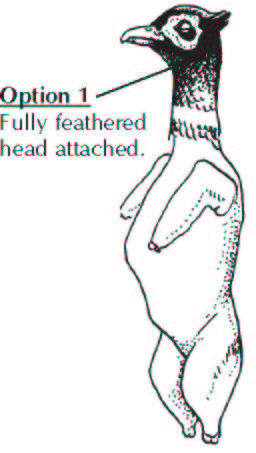
Option 2

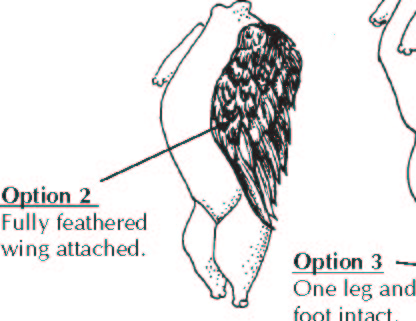

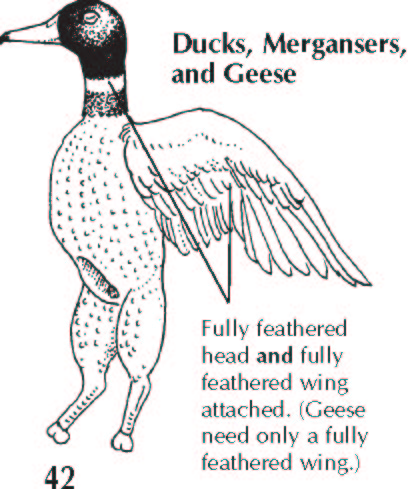
Woodcock, Rails,
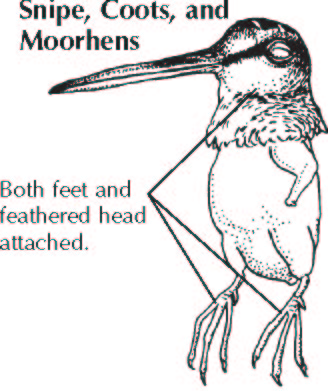
Small Game Trapping


GENERAL RESTRICTIONS License Requirements
See page 36.
Seasons
See page 40.


TRAPPING
Trap and Snare Identification
A person may not set or place a trap or snare, other than on prop erty owned or occupied by the person, unless the following information is affixed to the trap or snare in a way that ensures the information remains legible while the trap or snare is on the land or in the water:
1) The number and state of the person’s driver’s license; or
2) The person’s Minnesota identification card number; or
3) The person’s name and mailing address.
Note: From April 1 to August 31, the trap identification pro-visions listed above do not apply to traps set for the taking of unprotected wild animals.
o
Traps
A person may not set, place, or operate:
• any foot or leghold trap with a jaw opening greater than 83⁄4 inches;
• any body-gripping or conibear-type trap with a jaw opening greater than 71⁄2 inches, except as a waterset*; or
• any body-gripping or conibear-type trap with a jaw opening greater than 61⁄2 inches in or within 3 feet of a culvert, except when completely submerged in water.
* A waterset is defined as any body-gripping trap or snare set so that the trap jaws or the snare loop are at least half-submerged in water.
43
2002 Minnesota Hunting Regulations
Trap Setting and Tending
• A person may set or tend traps only from 5 a.m. to 10 p.m.
• A person on foot may use an artificial light to set or tend traps during the legal hours. However, that person may not possess or use a bow and arrow or a firearm other than a handgun of .22 caliber with short, long, or long rifle ammunition while using the light in the field.
• A person may not set a trap within 50 feet of any water other than temporary surface water within 30 days before the open season for mink and muskrat in that area, except by permit.
• Any trap capable of capturing a protected animal and not capable of drowning the animal must be tended at least once each calendar day, except for body-gripping or conibear-type traps. Any trap capa ble of drowning the captured animal and any body-gripping or conibear-type trap must be tended at least once each third calendar day, except for traps set under the ice. A trap may not be left un tended for more than three consecutive days (for example, a trap set or tended on Saturday would have to be tended again by Tuesday). When a trap is tended, any animal captured must be removed.
Trap Tampering
• No person may remove or tamper with a trap legally set to take fur-bearing or unprotected wild animals without authorization by the trapper, a DNR agent, or the owner or lessee of the land where the trap is located.
• A trapper may authorize, in writing, an agent who possesses all necessary licenses to tend traps set by the trapper, including resetting the trap at the same set. The agent may remove animals from a trap.
General Trapping Restrictions
• No trap, either set or unset, may be placed or staked, and no flag, stake, or other device may be placed to mark or pre-empt a trap-ping site before the opening of any trapping season.
• No person may leave any trap for a protected wild animal in place, either set or unset, after the close of the applicable trapping season.
• No person may disturb, injure, or destroy any muskrat house or den, except that traps may be set at natural entrances to muskrat burrows and openings may be made in muskrat houses for trapping if all material removed is wetted and used to plug the opening.
• Animals must be killed before being removed from a site.
• No person may disturb, injure, or destroy any beaver house, dam, burrow, or den.
44
Small Game Trapping

• No person may set a trap inside any beaver house or upon the out-side of any beaver house above the waterline.
• Mink may not be taken by digging or with the aid of dogs.
• Unattended electronic devices may not be used for taking wild animals.
• No person may set or maintain any leghold trap within 20 feet of bait located in such a way that it may be seen by soaring birds. “Bait” is any animal or animal parts, including live or dead fish, except that small pieces of fur and feathers may be used for flagging.
• No person may place a foot or leghold trap on a pole, post, tree stump, or other perch more than 3 feet above the ground, except by federal permit.
• No person may trap beaver or otter on a state Wildlife Manage ment Area without a permit from the wildlife manager.
Snaring Regulations
Snares may be used by licensed trappers for taking all species of protected wild mammals that may be taken by the use of traps, except bobcat. The use of snares is subject to the following regulations and all trapping regulations not inconsistent with these snaring restrictions.
o
General Restrictions for Snares
• Fox may be snared only in the Forest Furbearer Zone (see map below) with a permit issued by any DNR conservation officer. Permits are effective during the regular fox trapping season and are valid until revoked.
Continued on page 46.

TRAPPING
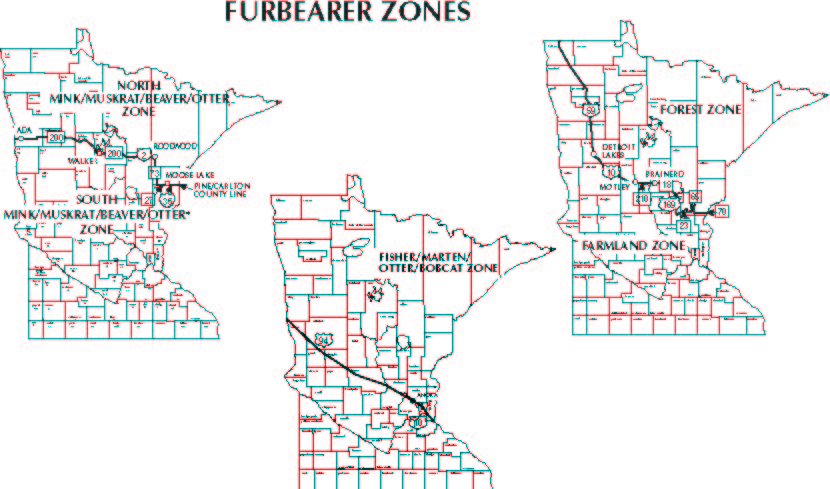
45
2002 Minnesota Hunting Regulations
• Bobcats and bears cannot be taken with snares.
• In the Farmland Furbearer Zone no person may set, place, or oper ate any snare except as a waterset. A waterset is defined as any snare set so that the snare loop is at least half-submerged under water.
Use of Snares
• The diameter of the snare loop may not exceed 10 inches.
• Snare cable or wire may not have a diameter exceeding 1⁄8 inch.
• No person may set, place, or operate a snare in a culvert, except as a completely submerged waterset.
• Snares may not be set in deer trails.
• Snares may not be used with spring poles or other devices that wholly or partly lift from the ground an animal caught in the snare.
• No snare may be set in such a way that the top of the loop is more than 16 inches above the ground or, when the ground is snow-covered, more than 16 inches above the bottom of a per-son’s footprint made in the snow beneath the snare with the full body weight on the foot.
• All snares not capable of drowning the captured animal must be tended at least once each calendar day.
• No snare set for a protected animal may be left in place after the applicable trapping season has closed.
Fur Export
All Furs
• To export any furs for sale in Canada, a completed “Declaration for Import or Export of Fish and Wildlife” (Form 3–177), signed by the exporter, must be filed with the U.S. Fish and Wildlife Service before export at the U.S. Customs Port where exported.
• The only U.S. Customs Ports in Minnesota through which furs may be exported are: Grand Portage, International Falls, and Minneapolis/St. Paul. For further information, contact: U.S. Fish and Wildlife Service, 649 Federal Building, St. Paul, MN 55101.
Otter, Bobcat, or Black Bear
• International trade in raw furs of otter, bobcat, and hides, claws, skulls, or teeth of black bear is regulated by federal law and inter-national treaty. If you plan to sell your own otter, bobcat, or bear furs or parts in Canada, you must obtain an export permit (for a fee) from the Federal Wildlife Permit Office, U.S. Fish and Wildlife Service, Washington, DC 20240.
• These products must also be shipped through one of seven designated ports (Chicago is the nearest) or through another port under special permit (for a fee) from the same office.
46
Small Game Trapping

• You don’t need export permits and declarations to sell to domestic or foreign buyers within the U.S. or to sell through brokers who possess the necessary permits.
Fisher, Otter, and Pine Marten Tagging Repealed
For this season, the requirement that fisher, otter, and pine marten must be tagged at the site where taken has been repealed. However, those species must still be registered as described below.
Furbearer Registration
• The pelt of each bobcat, fisher, pine marten, and otter, the carcass of each bobcat, and the head of each pine marten must be pre sented, by the person taking it, to a DNR registration station (see page 48) or area wildlife office (by appointment) for registration before the pelt is sold or is removed from the state, and no more than 48 hours after the season closes.
• The pelt of a bobcat, fisher, otter and pine marten must have been removed from the carcass. The entire carcass of the bobcat and head of the pine marten must be surrendered at the time of registration.
1854 Treaty Area
• All bobcat, fisher, pine marten, and otter taken by non–band mem bers or under state regulations must be registered at one of the state stations listed below, or with a DNR area wildlife office.
• Band authorities have established furbearer registration stations that can only be used by band members. All animals taken by band members under band codes must be registered at these band stations.
Releasing Protected Species
Every effort should be made to avoid catching fully protected species. If possible, a trapper should release accidentally captured protected species back into the wild. If a fully protected species is dead in the trap or other-wise cannot be released, you must notify a DNR conservation officer.

TRAPPING

47
2002 Minnesota Hunting Regulations
Furbearer Registration Stations
Furbearers may be registered between 12 noon and 7 p.m. on December 17, and between 3 p.m. and 7 p.m. on January 7 at the locations listed below or with any DNR area wildlife office by appointment only. NOTE: Ely station is now closed.
LOCATIONS
Aitkin DNR Wildlife Office
Backus DNR Forestry Office
Bemidji DNR Area Fish & Wildlife Office
Big Falls DNR Forestry Office
Brainerd DNR Area Wildlife Office (1601 Minnesota Drive)
Cambridge DNR Forestry Office
Cloquet DNR Wildlife Office
Cook DNR Forestry Office
Deer River DNR Forestry Office
Duluth DNR Forestry Office (4805 Rice Lake Road)
Effie DNR Forestry Office
Eveleth DNR Wildlife Office
Finland DNR Forestry Office
Forest Lake DNR Carlos Avery Game Farm Office
Grand Marais DNR Wildlife Office
Grand Rapids DNR Regional Headquarters
Hibbing DNR Forestry Office
Hinckley DNR Wildlife Office
International Falls DNR Wildlife Office
Middle River DNR Thief Lake Wildlife Office
Northome DNR Forestry Office
Orr DNR Forestry Office
Park Rapids DNR Wildlife Office
Roseau DNR Roseau River WMA Office
Roosevelt DNR Red Lake WMA Office
Rochester DNR Area Wildlife Office
St. Cloud DNR Office (940 Industrial Drive, Suite 103,
Sauk Rapids, MN) Tower DNR Office Two Harbors DNR Wildlife Office (Dec. 17 only)
Furbearer Pelting and Transportation
• A person who performs a service by recovering and preserving the pelt of a protected furbearer (except muskrat) that was accidentally killed or lawfully killed while doing damage, may be entitled to a pelting fee of 50% of the proceeds from the sale of the pelt. Contact a local DNR conservation officer or regional DNR Enforcement office within 24 hours for authorization to pelt the animal.
• No person may possess, transport, or pelt a fisher, otter, pine marten, fox, bobcat, lynx, or gray wolf that was accidentally killed, except when authorized beforehand.
48
Big Game

LEGAL FIREARMS FOR BIG GAME
A rifle, shotgun, muzzleloader, or handgun is legal for taking deer if:
• it is at least .23 caliber;
• it is loaded only with single projectile ammunition;
• the projectile used has a soft point or is an expanding bullet type;
• the ammunition has a case length of at least 1.285 inches, with the exception of a 10 mm cartridge that is at least .95 inches long, a
☞ .45 Winchester magnum, or a .50 A.E. (Action Express) handgun cartridge;
• the muzzleloader (long gun or handgun) used cannot be loaded at the breech (muzzleloading revolvers are not legal for taking big game);
• the smooth-bore muzzleloader used is at least .45 caliber; and
• the rifled muzzleloader used is at least .40 caliber. Other Restrictions
• A person may not take big game with a .30 caliber M-1 carbine cartridge.
• Rifled barrels on shotguns are legal statewide.
• No person may discharge a firearm or an arrow from a bow on, over, across, or within the right-of-way of an improved public highway (including but not limited to federal, state, county, and township roadways) at a big game animal or a decoy of a big game animal that has been set out by a licensed peace officer.
• A person may not use a dog or horse to take big game.
• A person may not take big game by archery while in possession of a firearm, except a person may take bear by archery while in possession of a firearm.
Handguns
• Big game may be taken statewide with handguns that meet the definition of legal firearms.
• The most common calibers of handguns legal for big game are .357, .41, .44 magnum, and .45 Winchester magnum.
Muzzleloader
• Big game may be taken with muzzleloaders that meet the defini tion of legal firearms.
• Only open and “peep” type sights (including those with fiber optic material) are legal during the Muzzleloader Deer Season. Scopes are not legal for this season.
49

2002 Minnesota Hunting Regulations
LEGAL BOWS AND ARROWS FOR BIG GAME
• Bows must have a pull no less than 40 pounds at or before full draw. Note: This is a minimum draw weight. Some short-draw-length (under 28") bows shooting light arrows may not effectively kill big game at a 40-pound draw weight.
• Arrowheads used for taking big game must be sharp, have a minimum of two metal cutting edges, be of barbless broadhead design, and have a diameter of at least 7⁄8 inch.
• “Expandable” broadheads may be used to take big game if they meet the requirements above and: 1) are at least 7⁄8 inch in width and no more than 2 inches in width at or after impact; and 2) are of a barb-less design and function in a barbless manner.
• No person may hunt with a bow drawn, held, or released by a me chanical device, except disabled hunters who have a crossbow permit.
• A hand-held mechanical release attached to the bowstring may be used if the person’s own strength draws and holds the bowstring.
• A person may not hunt big game or small game with a crossbow, except by a special permit issued to hunters unable to hunt by archery because of a temporary or permanent disability. This disability must be verified in writing by a licensed physician or chiropractor. The permit applica tion is available from any DNR regional office or by calling the infor mation numbers on page 129.
SHOOTING HOURS
Shooting hours for big game are one-half hour before sunrise to one-half hour after sunset.
TRANSPORTATION OF HEADS OR HIDES
A resident who has a license to take deer, bear, or moose may trans-port the head or hide of the animal for mounting or tanning.
POSSESSION OF BIG GAME
Any person who takes a big game animal must retain the license, site tag, permit, and possession (registration) tag for as long as any part of the meat is in possession.

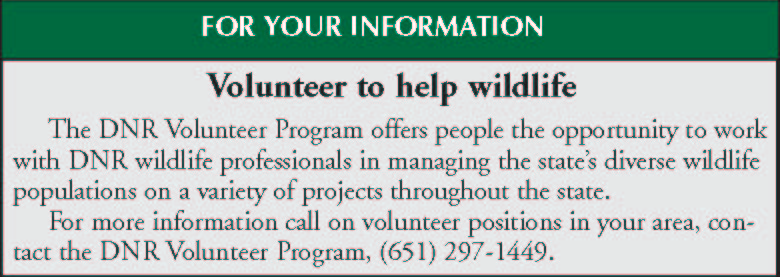
50
Deer

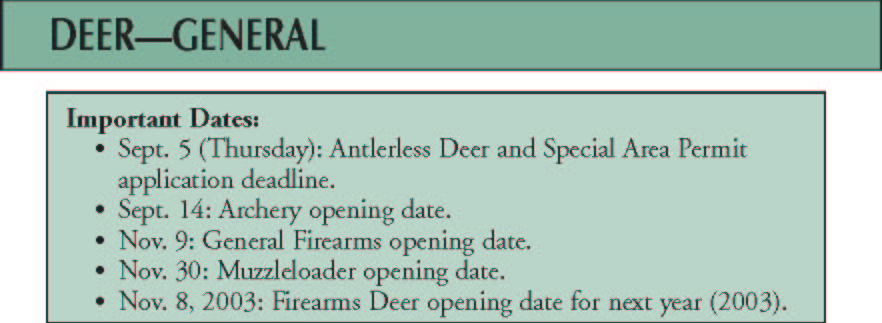
GENERAL REGULATIONS
In addition to those listed below, deer hunters must know the Big Game general hunting regulations on pages 49-50.
LICENSING

The following requirements apply to deer hunters. More information about general license requirements can be found on pages 16-24.
• A resident under the age of 16 or a disabled person who has been issued a permit to shoot from a stationary vehicle who has a valid deer license may take a deer of either sex, except in the Zone 3A Season and in permit area 116 (see chart on large map between pages 66-67). Only the authorized youth or disabled hunter may shoot and tag the antlerless deer (no party hunting). Also, this provision does not apply to special hunts.
• A person may purchase no more than one Firearms Deer License (including Muzzleloader and Multi-Zone Buck Licenses) and one Archery Deer License in a calendar year, except that additional Deer Management Permits and Intensive Harvest Permits, which allow the taking of additional antlerless deer, may be purchased.
51

DEER—GENERAL
2002 Minnesota Hunting Regulations
A person who purchases an All-Season Deer License may not pur chase any other Firearms or Archery Deer License, except inten sive harvest permits
• Multi-Zone Buck Licenses are not valid for the Muzzleloader Season or Zone 3B. Multi-Zone buck licensees may not purchase Management Permits.
• All-Season Deer Licenses are not valid for Zone 3B.
• A person may not take or tag deer without the appropriate license or permit. The term “taking” includes attempting to take deer, and driving, spotting, or otherwise assisting another person in taking deer.
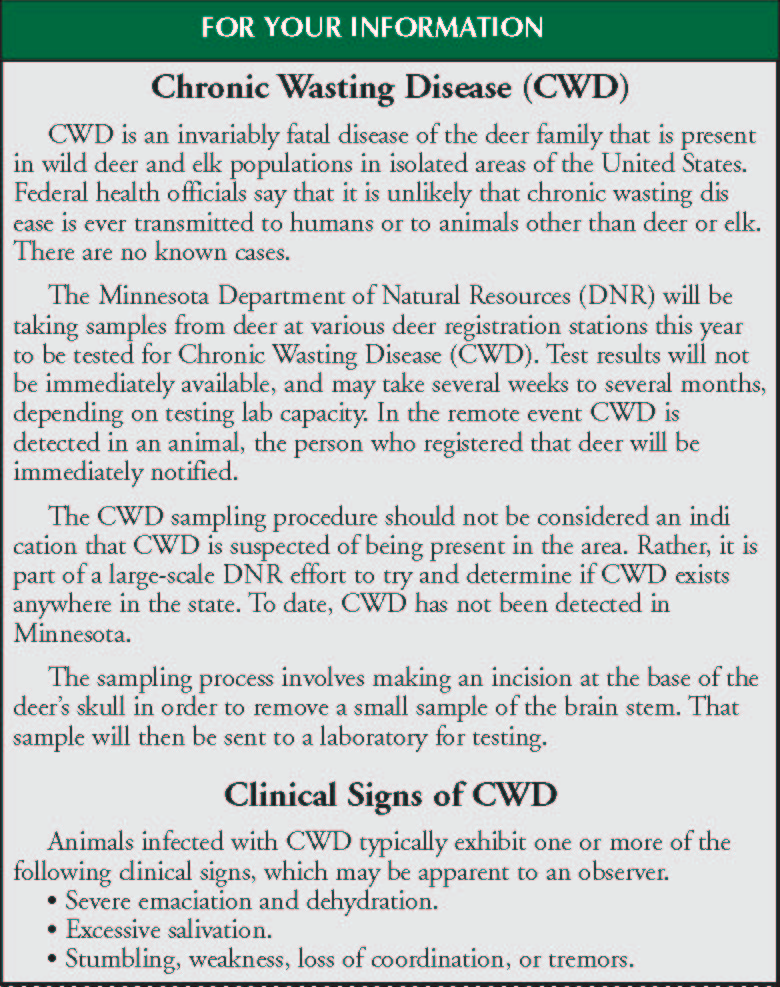
52
Deer

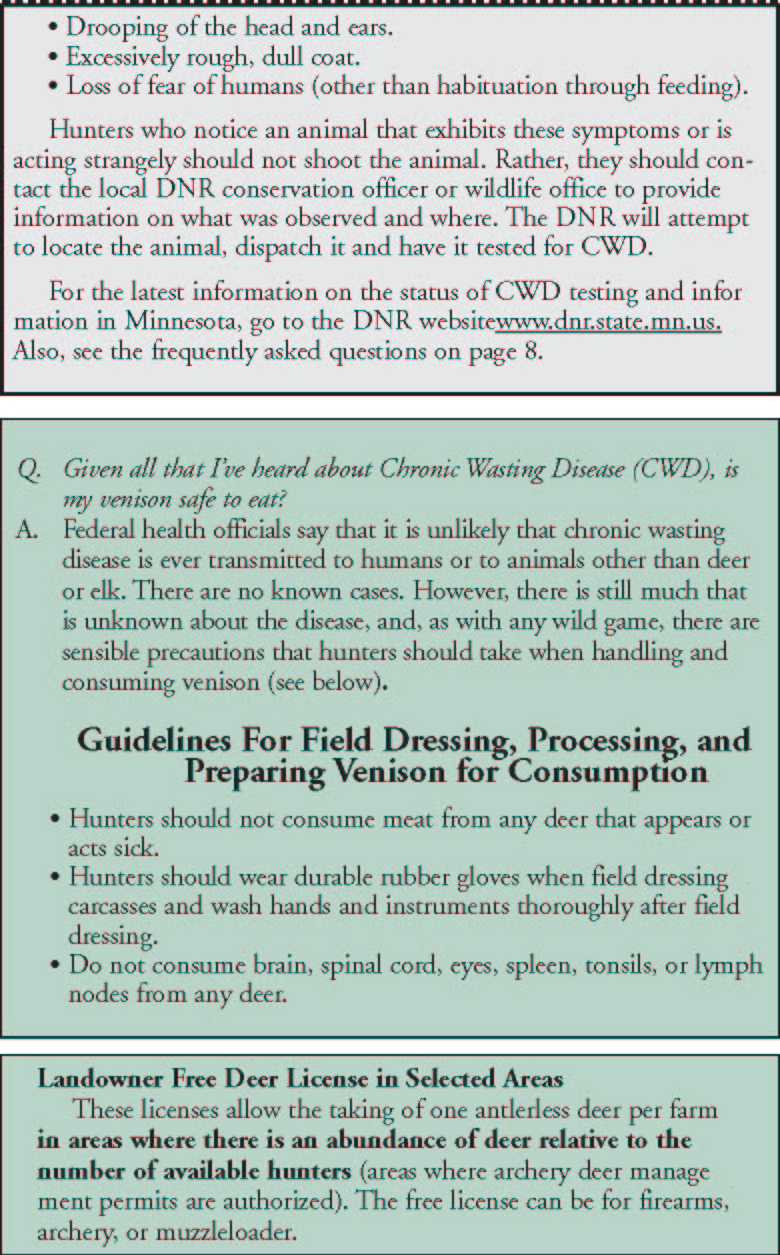

DEER—GENERAL
Continued on next page.
53
2002 Minnesota Hunting Regulations

BAG LIMIT FOR DEER
No one may tag more than one deer per calendar year, except as follows:
Northwest Two-Deer Area In Kittson, Lake of the Woods, Marshall, Pennington, and
Roseau counties (extreme northwestern Minnesota), a person may tag
one deer with a regular Archery License and another with a regular
Firearms License (including the muzzleloader option or the Multi-
Zone Buck license). Both deer must be taken and registered in these
counties.
☞ All-Season Deer License
• All-Season Deer Licenses are available from any ELS-POS license agent, the DNR License Center, by telephone, or by internet (see page 129).
• Holders of this license may hunt in any open archery, regular firearms (except Zone 3B), or muzzleloader season and area, using the legal firearm or bow and arrows for the respective season and zone.
• An All-Season Deer License holder may take and tag one buck by firearm (except Zone 3B), muzzleloader, or archery during any
54
Deer

season statewide. In addition, a resident obtaining this license may
take and tag one antlerless deer in any of the following ways:
(1) by firearms in the regular firearms season, only if the resident
first obtains an antlerless deer permit; (2) by archery in the
archery season; or (3) by muzzleloader in the muzzleloader season. • All-Season Deer License-holders may not “party hunt.” This means that they must shoot and tag their own deer, and may not shoot or tag a deer for another hunter. They may hunt with other hunters with valid deer licenses and may help drive, spot, trail, or retrieve deer, but “cross-tagging” is not allowed. Once the All-Season Deer License tags have been used, the license-holder may no longer legally shoot deer, may no longer hunt deer by themselves that year, and may not carry a firearm legal for taking big game, except when using intensive harvest permits in areas open for their use.
• All-Season Deer License-holders may not purchase any other deer license, but may purchase Intensive Harvest Permits.
Deer Management Permits
These are available for archery, muzzleloader and firearms hunters to take a second deer in designated areas. The additional deer must be antlerless. Deer Management Permits are available for one-half the cost of regular licenses. These management permits cannot be purchased by Multi-Zone Buck or All-Season Deer License holders.
Caution: You must purchase a Deer Management Permit before the additional deer is taken.
In no case may a person take more than two deer (except landowners or tenants in selected areas – see page 53) unless the ad ditional deer are taken under Intensive Harvest Permits, as described below.
Intensive Harvest Permits
Intensive Harvest Permits allow eligible hunters to take antlerless deer by archery, muzzleloader or firearms in some permit areas and special hunts. Deer taken under Intensive Harvest Permits are in addition to deer authorized to be taken under Regular Licenses and Deer Management Permits, as described above. The maximum number of deer that any individual may tag is 5 by any combination of licenses and permits.
Intensive Harvest Permits are valid for archery, muzzleloader or firearms, but hunters must have the appropriate Regular License for the area and for the weapon they are using, as follows:
Caution: You must purchase Intensive Harvest Permits before additional deer are taken.
55

DEER—GENERAL
2002 Minnesota Hunting Regulations
Up to 3 antlerless deer may be taken under Intensive Harvest Permits by:
• Archery: In Permit Areas 157, 159, 202, 205, 206, 209, 210, 222, 223, 225, 227, 228, 236, 242-245, 337, 339, 341-343, 345-349, 401-403, 405-411, 413, 429 during the Archery Season.
• Muzzleloader: 157, 159, 202, 205, 206, 209, 210, 222, 223, 225, 227, 228, 236, 242-245, 337, 339, 341-343, 345-349, 401-403, 405-411, 413, 429.
• Multizone Buck: 157, 159, 202, 205, 206, 209, 210, 222, 223, 225, 227, 228, 236, 242-245, 287, 337A, 401-403, 405-411, 413, 429.
• All-Season Deer: 157, 159, 202, 205, 206, 209, 210, 222, 223, 225, 227, 228, 236, 242-245, 287, 337A, 401-403, 405-411, 413, 429.
• Regular Firearms:
Zone Use of Intensive Harvest Permits Authorized
1A 157, 159
2A 202, 205, 206, 209, 210, 222, 223, 225, 227, 228,
236, 242-245, 287 during the 2A season 3A 337 during the 3A season 3B 337, 339, 341-343, 345-349 during the 3B season 4A 401-403, 405-411, 413, 429 in the 4A season 4B 401-403, 405-411, 413, 429 in the 4B season
• Special Hunts: One or more antlerless deer may be taken under Intensive Harvest Permits in some Firearms, Muzzleloader, and Archery special hunts (see pages 70, 76, 78-79). Selected hunters will be notified on procedures for these permits.
Intensive Harvest Permits may be purchased for one-half the cost of a regular license from ELS license agents and the DNR License Center.
HUNTING METHOD RESTRICTIONS Bait
• No person may place or use bait for the purpose of taking deer. “Bait” is defined as grain, fruit, vegetables, nuts, hay, or other food transported and placed for the purpose of attracting or enticing deer. This restriction does not apply to foods resulting from normal or accepted farming, forest management, wildlife management, orchard management, or similar land management activities.
• Liquid scents, salt, and minerals are not considered bait. Elevated Stands
• No person may take deer from a constructed platform or other structure that is higher than 16 feet above the ground. This restriction does not apply to a portable stand that is chained, belted, clamped, or tied with rope.
56
Deer

• In Wildlife Management Areas and State Parks open to hunting (see pages 70, 76, 109-111), only portable stands may be used. They must not be left overnight. Portable stand use is encouraged in State Forests.
• In Scientific and Natural Areas open to hunting, no stands (including portable stands) may be used (see pages 120-121).
• Any permanent stand on public land when not in use is considered public and not the property of the person who constructed it. Any use of threat or force against another person to gain possession of a stand is unlawful.
PARTY HUNTING
• A “party” is defined as any group of two or more licensed deer hunters who are all afield; hunting together at the same time; and all using firearms (including muzzleoaders) or all using archery.


DEER—GENERAL
A mixed group of firearms and archery hunters is considered two separate parties.
• Any member of a party meeting this definition may kill a deer for any other member of the party who has an unused tag valid for that deer,
except party members may not kill an antlerless deer for: 1) a member of the party who is a resident under age 16; or 2) a dis abled person authorized to take antlerless deer under a permit to shoot from a motor vehicle.
• Multi-Zone Buck license-holders may party hunt with Regular Firearms license-holders, except in Zone 3B and the Muzzleloader Season.
• All-Season Deer license-holders may not party hunt (see page 55).
USING SNOWMOBILES AND ALL-TERRAIN VEHICLES
To reduce disturbance during the prime hunting times, a person possessing any valid deer license is restricted to the following hours of operation for snowmobiles and all-terrain vehicles (ATVs*) during the firearms deer season, including the muzzleloader season. 57
2002 Minnesota Hunting Regulations
Such vehicles may only be operated:
a) before legal shooting time (one-half hour before sunrise),
b) from 11 a.m. until 2 p.m, and
c) after legal shooting hours (one-half hour after sunset).
• This regulation applies to all public and private lands and waters except for persons using an ATV as a part of their occupation on their own land who are not in possession of a firearm.
• A permit to operate snowmobiles or ATVs during the closed time periods may be issued by a DNR conservation officer in an emergency or other unusual condition.
• ATVs and snowmobiles are not allowed in State Parks, National Wildlife Refuges, Scientific and Natural Areas, or Wildlife Management Areas. ATV use is regulated in state and national forests. (See rules on using public lands, pages 109-128.)
* ATVs are defined for the purposes of these regulations as all vehicles not requiring Minnesota Department of Public Safety licensing, including trail bikes, 3-wheelers, 4-wheelers, 6-wheelers, tracked vehicles, and other similarly manufactured or homemade vehicles.
REGISTRATION AND TRANSPORTATION Deer Registration
Every deer taken must be registered. Registration stations display large, orange “Big Game Registration” signs. You may view a complete list of all stations at any DNR Wildlife office or on the DNR website. The person whose tag is on the deer must personally present the
deer at an official deer registration station and receive a Big Game
Possession Tag. This tag must be attached to the hind leg, ear, or antler
where the Site Tag was attached. A Possession Tag must be obtained:
a) within 24 hours after the expiration of the season under which the deer was taken (for example, a deer taken during the Zone 4A firearms season must be registered within 24 hours after the close of the 4A season, even if the deer is tagged by a Multi-Zone or All-Season Buck licensee); and
b) before the deer is processed, either privately or commercially. Deer may be transported out of the zone where taken without being registered first.
ELS Registration At registration stations in the Cloquet, Twin Cities Metro,Winona,
and Little Falls areas, Minnesota possession tags will be printed by the
ELS terminal and must be attached with a string or wire like the site tag
(see page 59). This system should improve the efficiency and accuracy of
deer harvest estimates and provide more timely information to hunters.
58 Insert from page 63.
Deer
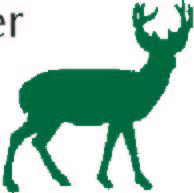
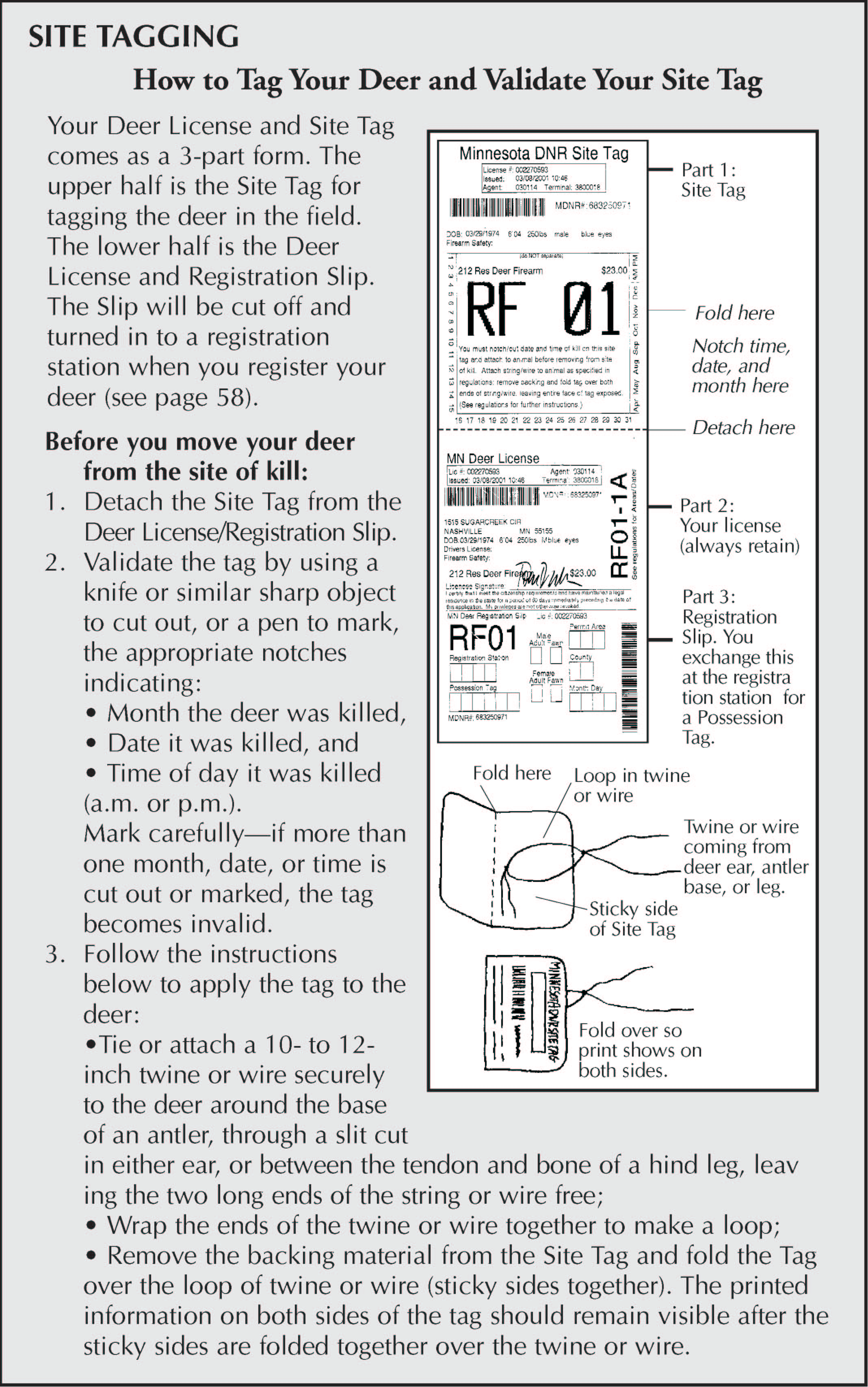
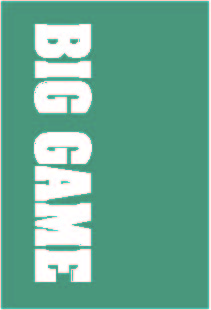
DEER—GENERAL
59
2002 Minnesota Hunting Regulations
Transportation
• A legally registered animal may be transported any time during and after the deer hunting season.
• The licensee must accompany the deer in transport except as follows: A deer that has been registered may be transported by another per-son, if the signature, address, and license number of the licensee and the origin and destination of the transport are written on the back of the possession tag. A licensee also does not have to accompany an animal transported by commercial transportation (see page 35).
• All deer in transport must be readily accessible for inspection by DNR conservation officers.
• The head of a deer must remain attached to the carcass until the deer is registered. Skin and entrails may be removed before regis tration. Deer may be quartered before being registered, but the animal’s head must remain attached to one of the quarters.
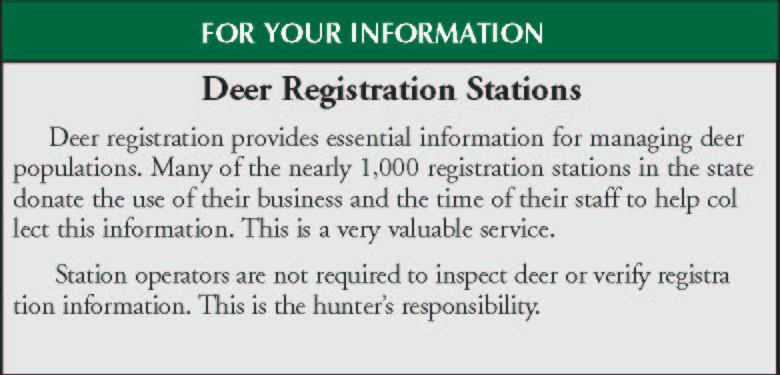

SPECIAL SEASONS FOR HUNTERS WITH PHYSICAL DISABILITIES
Special deer hunts for hunters with physical disabilities are tentatively scheduled to be offered in the Camp Ripley Military Reservation in Morrison County, the Carlos Avery Wildlife Management Area Sanctuary in Anoka County, a portion of the Lac qui Parle Game Refuge in Chippewa and Lac qui Parle counties, the Rydell National Wildlife Refuge in Polk County (see page 125), Lake Bemidji State Park in Beltrami County, and in antlerless permit areas 244 and 245. For more information, call the DNR Information Center at 1-888-MINN DNR (888-646-6367).
60
Deer


Shooting Hours
Legal shooting hours are one-half hour before sunrise to one-half hour after sunset.
Legal Buck and Antlerless Deer
• A “legal buck” is a deer having one antler at least 3 inches long. Fawn bucks, sometimes called button bucks, are not legal bucks.
• “Antlerless deer” are those without an antler at least 3 inches long. Rifle-Shotgun Boundary
• In the Shotgun Zone (see map on the back of the large, fold-out deer zone map, between pages 66-67), deer hunters may use only legal shotguns loaded with single-slug shotgun shells, legal muzzle-loading long guns, or legal handguns.
• Legal shotguns include those with rifled barrels.
LICENSE OPTIONS Regular Firearms License
• A regular firearms or muzzleloader deer hunter may select a hunt ing period and zone from the seven options listed below. The hunter’s choice will be printed on the license at the time of pur chase. Only one option is allowed, and hunting is not allowed under any choice other than the one selected and printed on the license.

BIG GAME DEER—FIREARMS
63
2002 Minnesota Hunting Regulations
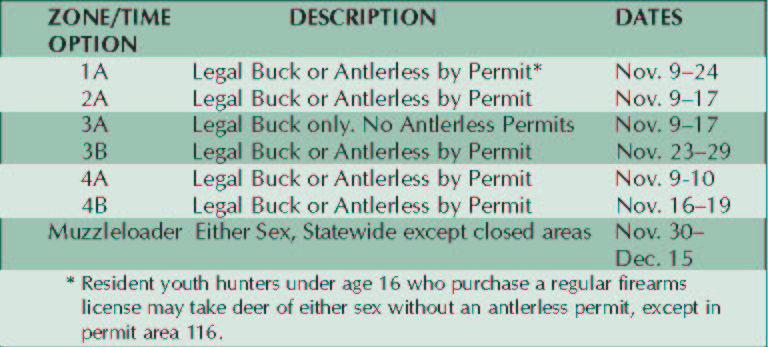
• Hunters who choose any of the zones 1A, 2A, 3A, 3B, 4A, or 4B op tions may hunt using muzzle-loading guns, but must follow regular firearms rules and cannot hunt during the Muzzleloader Season.
Deer Management and Intensive Harvest Permits
These permits allow the taking of additional deer in specified areas (see pages 73-74).
Landowner Free Deer License
These licenses allow the taking of one antlerless deer per farm in areas where there is an abundance of deer relative to the number of hunters (areas where archery deer management permits are autho rized). See page 53.
Multi-Zone Buck License
• Multi-Zone Buck Licenses are available from any ELS-POS license agent, from the DNR License Center in St. Paul, by telephone, or by internet (see page 129).
• These licenses allow hunters to hunt and to tag a legal buck in any open Regular Firearms Season, except Zone 3B and the Muzzle-loader Season.
• Those who have a Multi-Zone Buck License may hunt as a party with anyone holding a Regular Firearms License during any of the zone and time options except in Zone 3B and the Muzzleloader season. However, the license can only be used to tag a legal buck.
• You may not purchase both a Multi-Zone Buck License and a Regular Firearms License. If you have a Multi-Zone Buck License, you may not apply for Antlerless or Special Area Permits and will not be eligible for Deer Management Permits in undersubscribed permit areas. However, you may purchase Intensive Harvest Permits (see pages 55-56).
64
Deer

All-Season Deer License
This license allows the taking of one legal buck and one antlerless deer (see page 54).
Youth Licensing and Hunting Options
Residents under age 16 as of November 9 have four options for the Regular Firearms Deer Season:
1. Youth Either-Sex Option. Residents under age 16 with a Regular Firearms License may take deer of either sex without having to apply for an Antlerless Permit. Antlerless deer may be taken in any antlerless permit area in the zone indicated on the license, except in Zone 3A (bucks-only season) and in permit area 116. This provision does not allow the taking of antlerless deer by another member of the youth hunter’s party. A youth hunter who purchases a Multi-Zone Buck License may not take antlerless deer. Youth hunters cannot purchase Deer Management Permits, but may purchase Intensive Harvest permits.
2. $6.50 Youth License (no tag). Residents under age 16 as of November 9 have the option of purchasing a $6.50 Youth Firearms Deer License instead of a Regular License. NO TAG is included with this license and any deer taken by a youth with this license must be tagged by another party member. Youth with this license must be accompanied by a licensed hunter at least 18 years of age who possesses a valid tag. Youths purchasing this license must specify a zone and time period that the license is valid. Youth interested in participating in Special Permit Areas (see pages 69-70) must pur chase a Regular Firearms License and apply using the Antlerless/-Special Area Permit Application that comes with that license.
3. Multi-Zone Buck License. Residents under age 16 may purchase a Multi-Zone Buck License (see above), but may only tag a legal buck.
4. All-Season Deer License. Residents under age 16 may purchase an All-Season Deer License and may tag one legal buck and one antler-less deer (see page 54).
Hunters With Disabilities: Either-Sex Deer Hunting
A disabled person with a permit to shoot from a motor vehicle may take deer of either sex without an antlerless permit. This provi sion does not apply to Zone 3A (bucks-only season), to those antler-less permit areas where no antlerless permits are authorized, or to Multi-Zone Buck License holders.
Continued on page 69
65

DEER—FIREARMS

2002 Minnesota Hunting Regulations
THIS PAGE LEFT INTENTIONALLY BLANK
66
Deer
ANTLERLESS AND SPECIAL AREA PERMITS


• Residents under the age of 16 as of November 9 and disabled per-sons with a permit to shoot from a stationary motor vehicle may take a deer of either sex (except during the 3A Season and in those antlerless permit areas where no permits are authorized) without having to apply for or obtain an Antlerless Permit. Youth ages 12-15 who qualify under this provision may not apply for an Antlerless Permit or accrue additional preference for these areas. All hunters must apply if they wish to participate in a special hunt.
• Regular Firearms Deer hunters may apply for an Antlerless Permit or a Special Area Permit within the zone and time option printed on their license. Hunters licensed for the Muzzleloader Season may also apply for Special Area Permits during that season (see page 76).
• Multi-Zone Buck hunters may not apply for Antlerless Permits, Special Area Permits, or Firearms Management Permits. Multi-Zone Buck hunters may purchase Intensive Harvest Permits (see pages 55-56).
• All-Season Deer hunters may apply for Antlerless Permits and may purchase Intensive Harvest Permits (see page 56).
• Antlerless permit applications will not be accepted for permit areas where no permits are being offered.
Antlerless Permits
• Antlerless Permits allow a person to take a deer of either sex within the specified permit area.
• No antlerless permits are available in Permit Area 116.
• Areas and permit quotas are shown on the fold-out map (between pages 66-67) that accompanies these regulations.
• Antlerless Permit holders may take antlerless deer only in the area specified on the permit, but they may hunt bucks anywhere in the zone during the time period punched on the license.
Special Permit Areas
• Special Permits are required to hunt deer in Special Permit Areas (such as parks) where the number of hunters must be limited to control the harvest or for public safety.
• Special Permit Areas for regular firearms hunters are listed in the
table on the next page.
69

DEER—FIREARMS
2002 Minnesota Hunting Regulations
2002 Special Permit Areas for Firearm Hunters
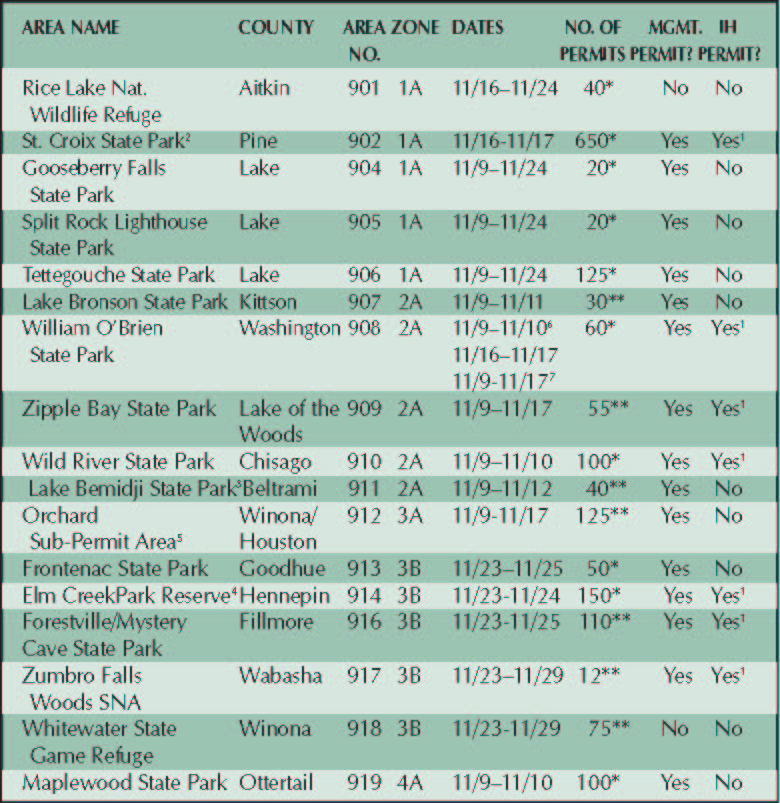
*Either sex, **Antlerless Only
Up to 3 Intensive Harvest Permits may be purchased.
No camping will be allowed in the park during the hunt.
Shotguns and muzzleloaders only.
A $5 fee will be charged to each successful applicant.
See map and instructions for Orchard Sub-Permit Area, page 74
Parkland north of Washington County Highway 4 open to permit holders the weekends of 11/9-11/10
and 11/16-11/17 only.
7 Parkland south of Washington County Highway 4 open to permit holders from 11/9-11/17.
70
Deer

• Those who receive Special Area Permits may also hunt deer outside that Special Area but only in the zone and during the time period punched on the license.
• You may apply for Special Permit Areas in parties of up to 4 hunters. See application instructions below.
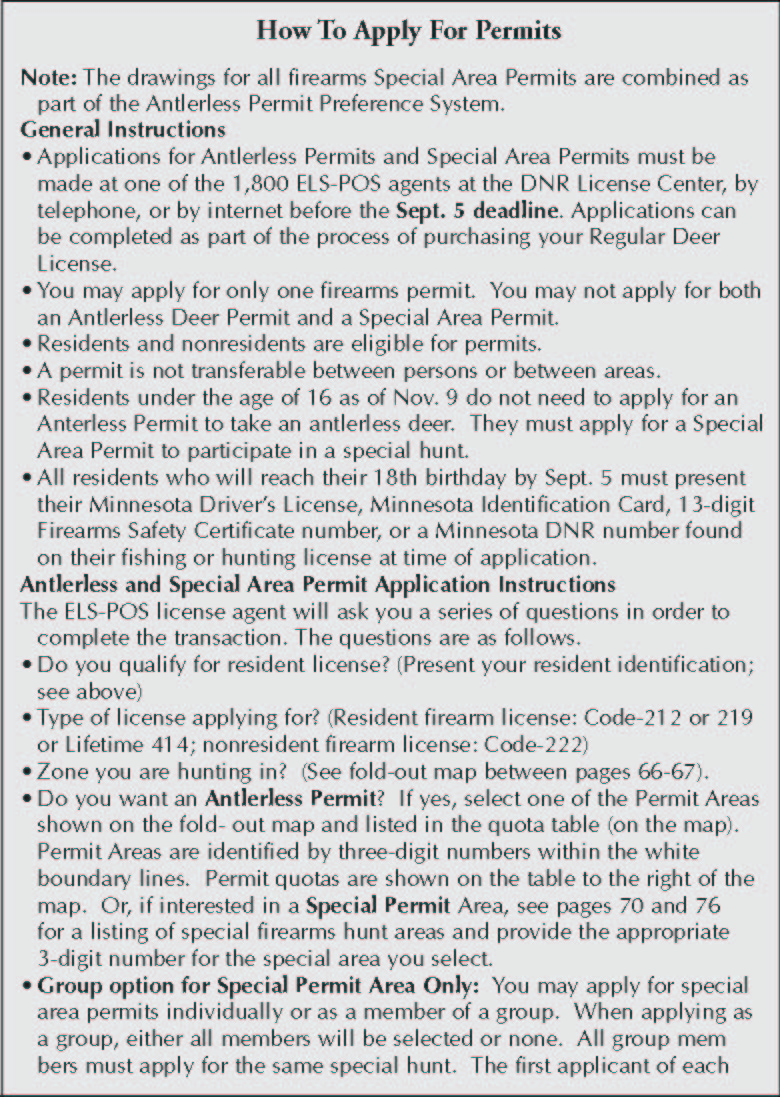

DEER—FIREARMS
Continued on page 72
71
2002 Minnesota Hunting Regulations
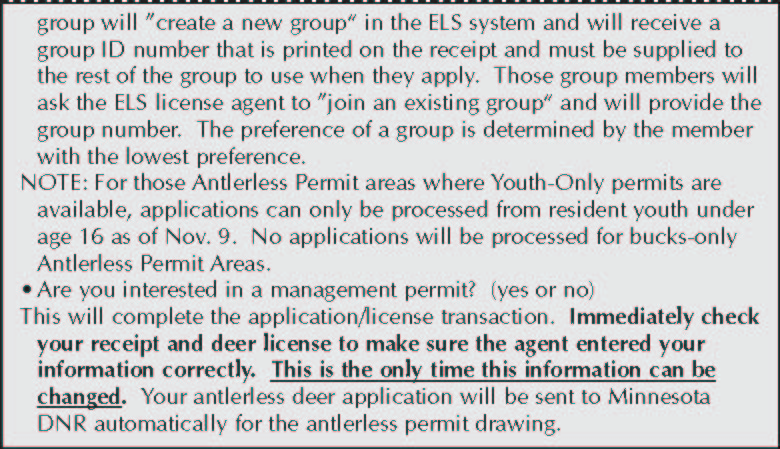
Selection and Notification of Successful Applicants
• If permit applications exceed quotas, computerized drawings will be used to determine who will be issued permits.
• Drawings for Special Area Permits are based on a preference system. Applicants for Special Area Permits accumulate preference the same as applicants for Antlerless Permits do. This system gives the highest preference to those who have applied the most times without receiving a permit. A person’s preference is the same whether applying for an Antlerless Permit or a Special Area Permit.
• Preference is not affected if a person applies for an area different from the year before or if a person does not apply for one or more years.
• The preference for Special Area applicants who apply as a group is based on the individual in the group with the lowest preference.
• Only successful applicants will be notified.
• Permits will be drawn and mailed by October 28. Information about the drawings and individual applications is not available until after this date. Applicants may check the DNR web page (www.dnr.state.mn.us) on October 28 to view antlerless permit lottery results.
• If you submitted a valid application and are not notified by Oct. 28, you can assume your application was not selected this year, and that your preference will increase if you apply in a future year.
72
Deer

INTENSIVE HARVEST PERMITS
Intensive Harvest Permits allow firearms hunters to take up to 3 additional antlerless deer in certain permit areas (see pages 55-56) and in some Special Permit Areas. See pages 69-70.
DEER MANAGEMENT PERMITS
Firearms Deer Management Permits are available in the three situations described below. Deer Management Permits allow the taking of a second, antlerless deer. Either the Regular License or the Deer Manage ment Permit may be used first. Deer Management Permits are valid only in the area for which they are issued, and are not transferable.
1. Undersubscribed Antlerless Permit Areas
Those selected for Antlerless Permits in undersubscribed Permit Areas will be included in a second drawing for the available Deer Management Permits if they indicated an interest in a deer management permit in their application. No separate application is necessary. Applicants selected for Deer Management Permits will be authorized to purchase the Deer Management Permit and tag at one-half the regular license fee from ELS license agents or the DNR License Center in St. Paul. Management Permits for undersubscribed antlerless permit areas may be purchased or obtained throughout the deer season, but you must purchase the license before you shoot the deer.
2. Special Permit Areas
Firearms Deer Management Permits are available for Special Permit Areas as denoted on the Special Permit Area tables on pages 70 and 76. Special Permit Area hunters who are offered a Deer Man agement Permit will be sent instructions on how to purchase Deer Management Permits from license vendors or the Special Permit Area headquarters.
3. Orchard Sub-Permit Area
A 57-square-mile area within Antlerless Permit Area 346 (see map next page) will be open to taking antlerless deer by management per mit during the Zone 3A (Bucks-only) Season. Hunters with a license valid for the 3A Season are eligible to apply for one of 125 Deer Man agement Permits which will be distributed by a random drawing. See the special area table and application instructions on pages 71-72. This is Special Permit Area 912. This area is private land. Hunters are encouraged to get permission from a landowner in the Sub-Permit Area before applying.
Continued on page 74
73

DEER—FIREARMS
2002 Minnesota Hunting Regulations
Orchard Sub-Permit
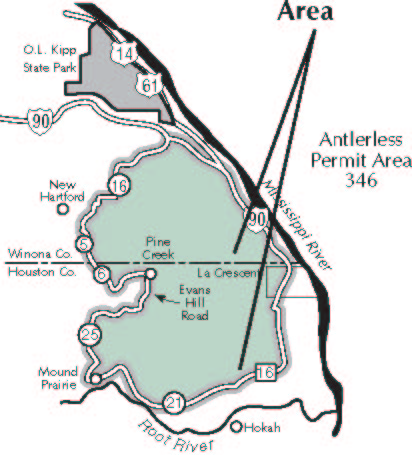
346
v
ITASCA STATE PARK
Itasca State Park (Becker, Clearwater, and Hubbard counties) is open to firearms deer hunting for legal bucks (Zone 2, Multi-Zone, or All-Season Deer License holders) and for antlerless deer (Area 287 permit holders), except where posted as closed. The park is not open during the Archery or Muzzleloader Seasons.
74
Deer


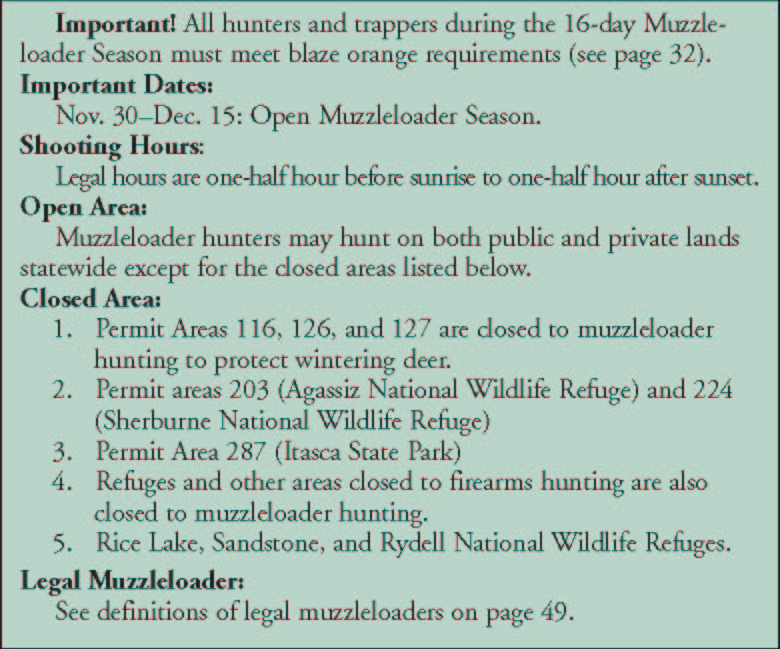

DEER—MUZZLELOADER
The Muzzleloader option allows hunters to take deer of either sex, except as explained in the box below. Muzzleloader hunters may also apply for one of the Muzzleloader Special Permit Areas listed on page 76.
DEER MANAGEMENT PERMITS
Hunters who select the Muzzleloader option on their Firearms License may purchase a Firearms Management Permit for one-half the cost of a regular license from ELS license agents or the DNR License Center in St. Paul. A Muzzleloader Management Permit allows hunters to tag a sec ond, antlerless-only deer in any of the following areas:
• Antlerless Permit Areas—Firearms Management Permits issued to
Muzzleloader hunters are valid for taking a second, antlerless-only deer
in the following Antlerless Permit Areas: 104, 107, 110, 115, 154,
156, 157, 159, 167, 168, 172, 175, 178, 181, 183, 201, 202, 204-
211, 221-225, 227, 228, 236, 242-249, 283-285, 337, 339-343, 345-
349, 401-415, 418-423, 429, 452, 462, and 467.
• Special Permit Areas—Firearms Management Permits issued to Muzzleloader hunters are also valid to take a second antlerless deer for
75
2002 Minnesota Hunting Regulations
hunters with permits for the Jay Cooke (north and south), Crow Wing, Savannah Portage, Afton, and Lake Shetek State Park Muzzleloader Special Permit Areas.
INTENSIVE HARVEST PERMITS
Intensive Harvest Permits allow Muzzleloader hunters to take up to 3 additional antlerless deer in some Permit Areas. See pages 55-56.
SPECIAL PERMIT AREAS FOR MUZZLELOADER HUNTERS
The following are Special Permit Areas open during the Muzzleloader Season. Application instructions are the same as for other Firearms Special Permit Areas and are described on pages 71-72.
Note: Applicants for Special Permit Areas may apply in parties of up to four hunters.
Special Permit Areas for Muzzleloader Hunters
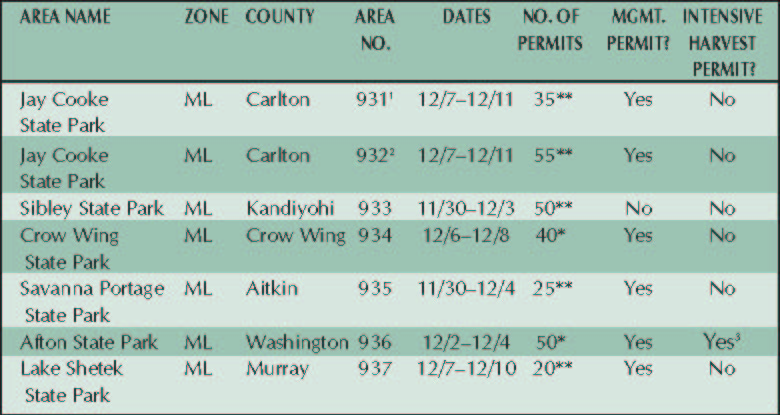
* Either Sex
** Antlerless Only 1 North of the St. Louis River. 2 South of the St. Louis River. 3 Up to three Intensive Harvest Permits may be purchased.
76
Deer


SHOOTING HOURS
Shootings hours for archery deer hunting are one-half hour before sunrise to one-half hour after sunset.
ARCHERY DEER SEASON
Northeast Border Zone (Permit Areas 116 and 127): September 14–November 24.
Remainder of State: September 14–December 31.
Permit Area 287 (Itasca State Park) is closed to Archery Hunting.
Legal Deer
Antlerless deer and legal bucks may be taken by archery, except only legal bucks may be taken in permit areas that have no antlerless permits or have Youth-Only Antlerless Permits.
Archers are restricted to bucks-only hunting in antlerless permit area 116. However, they may take deer of either sex during the Zone 3A (bucks-only) firearms season. See foldout map between pages 66-67.
General Restrictions
• A person possessing both a Regular License and a Deer Manage ment Permit or Intensive Harvest Permit may use any tag first.
• No person may take deer by archery while in possession of a firearm.
Archery Special Permit Areas

DEER—ARCHERY


77
2002 Minnesota Hunting Regulations
The following areas are open for archery hunting by Special Area Permit:
1. Camp Ripley Bow Hunt
A total of 2,250 permits will be issued for each of the hunting periods: October 17-18 (Thursday-Friday) and October 26-27 (Saturday-Sunday). This year, all Camp Ripley Archery hunters will apply for a Camp Ripley hunting permit through the DNR’s com puterized Electronic License System (ELS) at one of the 1,800 statewide Point-of-Sale (POS) agents, at the DNR’s St. Paul License Center, or by the Department’s ELS telephone system (additional $3.50 charge per customer call).There is a $6 fee per group member to apply for a Camp Ripley Archery Permit. This fee must be paid at the time of application at the ELS-POS, License Center, or ELS telephone agent, and it is non-refundable. The application must be made by Friday, August 16.Note: Archery Management Permits are not valid for Camp Ripley.
2. Crow-Hassan Park Reserve in Hennepin County is open to either-sex archery deer hunting. Hunters may apply through September 5. There will be 130 permits for November 15–17. A $5 application fee will be charged at the time of application. Archery Deer Management Permits are valid in this hunt, and up to three Intensive Harvest Permits may be used to tag deer during the hunt. For an application form, send a self-addressed, stamped, business-sized envelope to: Three Rivers Park District Bow Hunt, 3800 County Road 24, Maple Plain, MN 55359.
3. Murphy-Hanrehan Park Reserve and Cleary Lake Regional Park in Scott County are open to either-sex archery deer hunting on November 15–17. Hunters may apply through September 5. There will be 185 permits for the Murphy-Hanrehan hunt, and 55 for the Cleary Lake hunt. Hunters must specify on the application which hunt they are applying for. A $5 application fee will be charged at the time of application. Archery Deer Management Permits are valid in this hunt, and up to three Intensive Harvest Permits may be used to tag deer during the hunt. For an applica tion form, send a self-addressed, stamped, business-sized envelope to: Three Rivers Park District Bow Hunt, 3800 County Road 24, Maple Plain, MN 55359.
4. New Ulm City Deer Hunt
Portions of the city of New Ulm will be open to archery hunting by special permit. A proficiency test and $5 administrative fee will be required. A maximum of 50 individuals will be issued city per mits for this hunt, valid for October 12 through December 31.
78
Deer

Applicants must purchase a Regular Archery License and an Archery Deer Management Permit to qualify. In addition, Intensive Harvest Permits may be used to take additional deer (see pages 55-56). For an application form and description of the hunt requirements, write to: New Ulm City Deer Hunt, City Manager’s Office, 100 N. Broadway, New Ulm, Minnesota 56073, or call (507) 359-8236. Applications must be postmarked no later than September 3.
5. City of Red Wing Deer Hunt
Portions of the City of Red Wing are open to archery hunting Sept. 14–Dec. 31 by special permit from the city. A proficiency test and a $5 city back tag are required. Hunters must possess a valid Regular Archery License and an Archery Deer Management Permit to apply. Hunting is allowed on private land within these areas with written landowner permission and in certain city park areas under special hunting rules. Intensive Harvest Permits are available and strongly encouraged for participants in the City Hunt. For more information on the City Hunt and to obtain permits, write to: Red Wing Public Works, 229 Tyler Road S., Red Wing, MN 55066, or call the Administration Department at (651) 385-3674.
Other Archery Areas
Carver Rapids State Wayside, the Rice Lake Unit of the Min nesota Valley State Recreation Area, and Minnesota Valley NWR (Wilkie and Louisville Units) are open to archery deer hunting. (No other portions of the refuge are open to archery deer hunting. See page 124.)
Camp Ripley Youth Bow Hunt
No more than 100 permits will be issued to youth ages 12-17 for October 12-13, 2002 (Saturday-Sunday). Youth must be at least 12 years old before October 10, 2002 and have a hunter safety certifi cate. Group applications and party hunting will not be allowed during this special hunt. All successful applicants must be legally licensed to hunt deer by archery. The application process for this hunt has not been finalized. For additional information on hunt details and how to apply, send a self-addressed, stamped, business-sized envelope to: Camp Ripley Youth Archery Hunt, c/o Minnesota Deer Hunters Association, 460 Peterson Road, Grand Rapids, MN 55744.Note: Archery Management Permits are not valid for Camp Ripley, and supervision of youth hunters by an adult mentor is required. Successful applicants, as well as mentors may be required to pass a proficiency test and attend an orientation session before the hunt.
79

DEER—ARCHERY
☞
2002 Minnesota Hunting Regulations
Deer Management Permits
Archery Deer Management Permits may be purchased at any ELS license agent and the DNR License Center for one-half the regular license fee. If the regular archery license is purchased after the start of the archery season, management permits are not valid until the 2-day wait has expired for the regular license. Archery Deer Management Permits may be purchased anytime throughout the Archery Deer Season. An Archery Deer Management Permit allows hunters to tag a second, antlerless-only deer in any of the following areas:
• Antlerless Permit Areas—Archery Deer Management Permits are valid for taking a second, antlerless-only deer in the following Antlerless Permit Areas: 104, 107, 110, 115, 154, 156, 157, 159, 167, 168, 172, 175, 178, 181, 183, 201, 202, 204-211, 221-225, 227, 228, 236, 242-249, 283-285, 337, 339-343, 345-349, 401-415, 418-423, 429, 452, 462, and 467. • Special Permit Areas—Archery Deer Management Permits are
also valid for antlerless deer by hunters selected for the Crow-
Hassan, Murphy-Hanrehan, Cleary Lake, New Ulm, and Red
Wing Special Permit Areas noted on pages 78-79.
Note: Archery Management Permits are not valid in Camp Ripley. • Other Areas—Archery Deer Management Permits are also valid for taking a second, antlerless-only deer within the East Minnesota River State Game Refuge in Blue Earth and Le Suer counties.
Intensive Harvest Permits
Intensive Harvest Permits allow hunters to take up to 3 additional antlerless deer in some Permit Areas (see page 55-56) and for hunters selected for the Crow-Hassan, Murphy-Hanrehan, Cleary Lake, Red Wing and New Ulm Special Permit Areas. See pages 78-79 for more information.

80
Bear


REGULATIONS
Bear hunting regulations booklets have been distributed to all Permit Area hunters and are available to No-Quota hunters at license agents. ☞ • The bag limit for bears is one per season in quota areas and two per season in the no-quota area.
• White bears may not be taken.
• Cub bears may not be taken.
See bear hunting regulations booklet for additional information.


BEAR
LICENSING
Residents and nonresidents can obtain a bear license in one of two ways: They can participate in a drawing for licenses within Bear Permit Areas, or they may purchase a license over the counter for the No-Quota Area. No person may purchase more than one bear license in a calendar year. Bear licenses must be validated at the site of kill before the bear is removed from the site.
Bear Permit Area Licenses
Applications for Bear Permit Area Licenses (see map, next page) are available in mid-March. The application deadline is the first Friday in May. Applications may be made individually or as part of a group of up to four individuals.
Licenses for Bear Permit Areas are allocated through a computer ized preference drawing. Applicants receive higher preference the more times they have been unsuccessful in past drawings. For group appli cations, the individual within the group with the lowest preference rating will determine the preference rating for the group. All accumu lated preference is lost once you are issued a Bear Permit Area License. Obtaining a No-Quota Bear License has no effect upon preference.
No-Quota Licenses
A person who hunts bears outside the permit areas does not have to participate in a drawing and may purchase a No-Quota Bear Li cense from any ELS license agent or from the DNR License Center in St. Paul. A hunter with a No-Quota License may only hunt outside the Permit Areas. 81
2002 Minnesota Hunting Regulations
Quotas
The following permit
quotas were available by
area for the 2002 season:
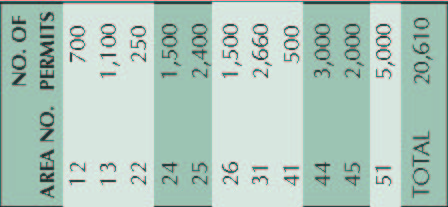
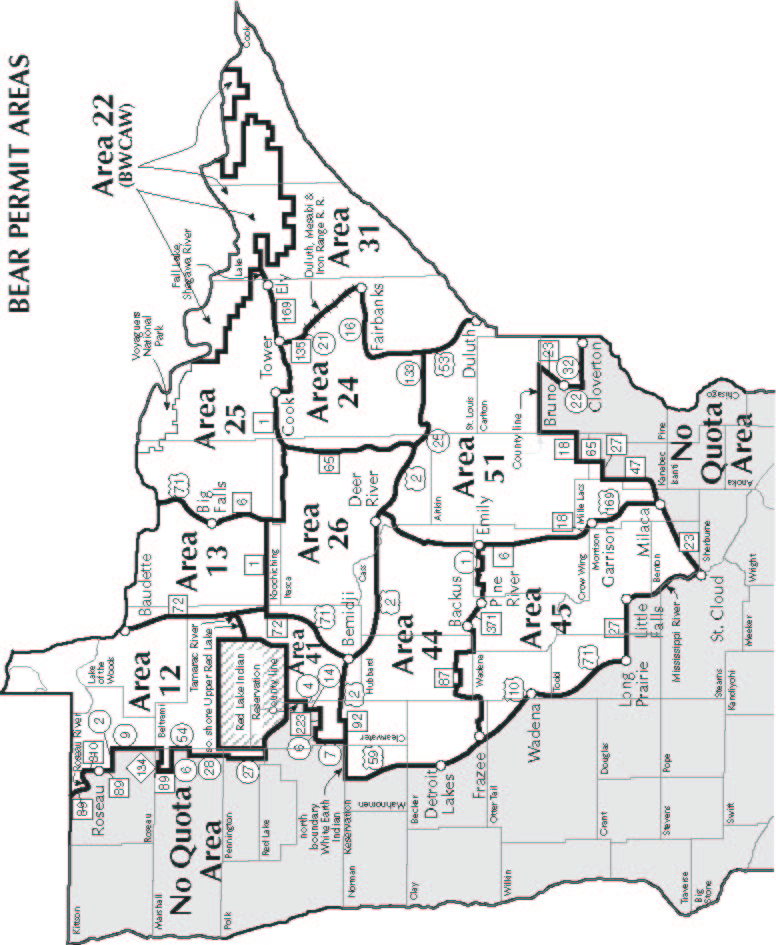
82

☞The application deadline for the 2002 moose hunt was June 14, 2002. A total of 208 permits were available in 30 zones in the northeast-ern part of the state. Northwestern Minnesota remains closed to moose hunting due to low population levels. Successful applicants will be noti fied in August and regulations and hunt information will be sent to each license holder. Season dates for the 2002 moose hunt are September 28 to October
13. Hunters and trappers should be aware that there is a big game season open during the above dates in northeastern Minnesota. The 1854 Authority and the Red Lake, Fond du Lac, and White Earth Indian Bands will also be conducting moose hunts in these areas of the state. Minnesota’s moose hunt is for residents only, and since 1991 it has
been a “once-in-a-lifetime” hunt.



No elk hunting season will be held this fall. During years when it is held, the elk season is open only to residents, and hunters must apply in parties of two. There is a $20 application fee per party, and licenses cost $250. Elk permits are issued by random drawing, and the hunt is once-in-a-lifetime. Information regarding a possible elk hunting season in 2003 will be available in June, 2003. If a hunt is scheduled for next year, the application deadline will be July 11, 2003.
83
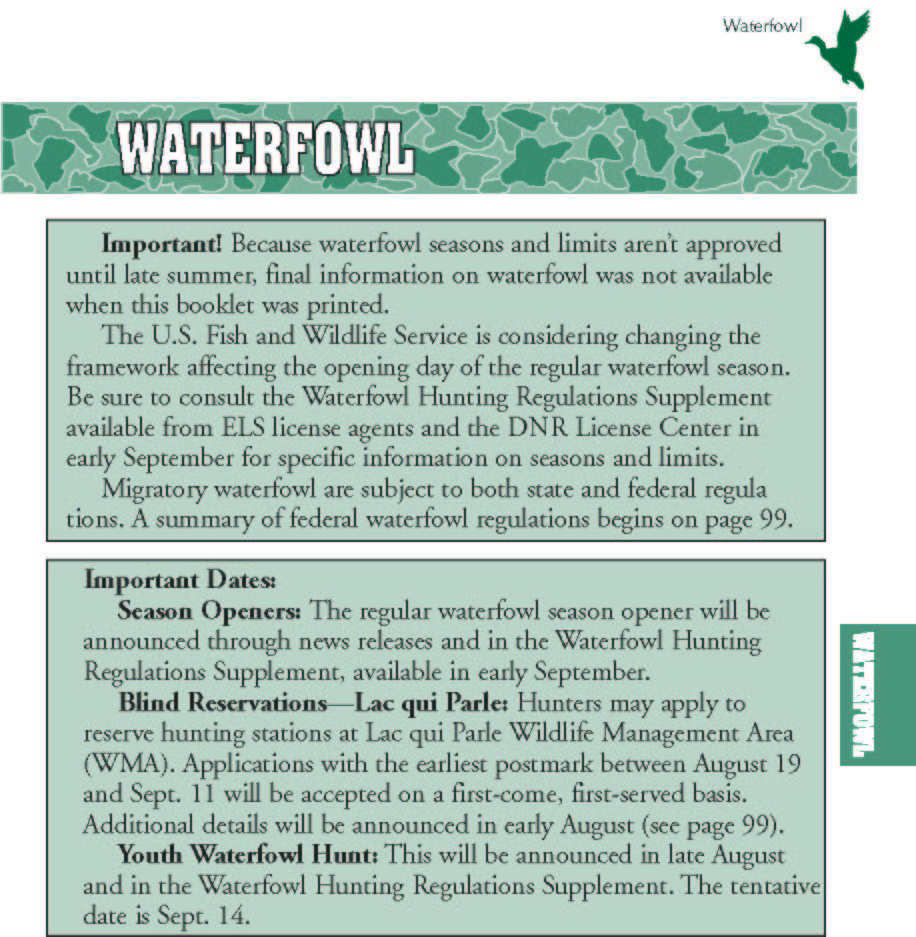
Definitions
• “Migratory game birds” means ducks, geese, mergansers, coots, moorhens (gallinules), woodcock, rails, and snipe.
• “Migratory waterfowl” means ducks, geese, and mergansers.
• “Undressed bird” means ducks and mergansers with one fully feathered wing and head attached or geese with one fully feathered wing attached (other migratory and small game birds must be transported as described on page 42).
HARVEST INFORMATION PROGRAM COMPLIANCE
All migratory bird hunters, including waterfowl hunters, must be in compliance with the harvest information program by indicating that they intend to hunt migratory birds when answering the migratory bird hunting survey questions on the ELS terminal (see page 89).
85
2002 Minnesota Hunting Regulations
MOTORIZED DECOYS
From the opening day of the duck season through Oct. 5, motorized decoys with visible, moving parts that are above the surface of the water may not be used on public waters to take migratory waterfowl, except geese (see waterfowl regulations supplement available in early Spetember for details).
LICENSE REQUIREMENTS
Waterfowl hunters must have a Minnesota Small Game License in their possession while hunting unless they are exempt from a license requirement. See page 36 for small game licensing details.
STAMP REQUIREMENTS Minnesota Migratory Waterfowl Stamp
• State Migratory Waterfowl Stamps (State Duck Stamp) cost $5 and are available from ELS license agents and the DNR License Center. There is no issuing fee for stamps. An electronically issued stamp validation is valid for 30 days. Actual pictorial stamps will be mailed to hunters. A pictorial stamp is not valid unless the licensee signs it across the face.
• All resident hunters except those under age 18 or age 65 and over, and all nonresident hunters, are required to have a valid State Duck Stamp or valid stamp validation in their possession while hunting or taking migratory waterfowl. The exceptions are as follows:
a) Residents who are hunting on their own property don’t need a State Duck Stamp, but must possess a Federal Duck Stamp.
b) Residents who are in the U.S. Armed Forces and are sta tioned out of state may hunt waterfowl without a small game license and without a State Duck Stamp, if they have official military leave papers on their person. However, they must possess a Federal Duck Stamp.
Federal Migratory Waterfowl Stamp
• Waterfowl hunters aged 16 and older must carry on their person a valid Federal Migratory Bird Hunting and Conservation Stamp (Federal Duck Stamp) signed in ink across the face.
• Federal Duck Stamps cost $15 and are available at post offices and some license agents.
Stamp Requirements For Shooting Preserves
Persons hunting waterfowl on commercial shooting preserves are required to have both a Federal and a State Duck Stamp in addition to a Small Game License. The only exception is when taking only marked, pen-reared mallards.
86
Waterfowl

SPECIAL GOOSE HUNTS
• A special $4 permit is required to hunt Canada geese during the special September and late December seasons. One permit is good for both seasons. All persons must have the permit to par ticipate in these hunts, except residents under age 18 or age 65 and over, and persons hunting on their own property. The permit is available from ELS license agents and the DNR License Center or by telephone. There is no deadline for purchasing the permit.
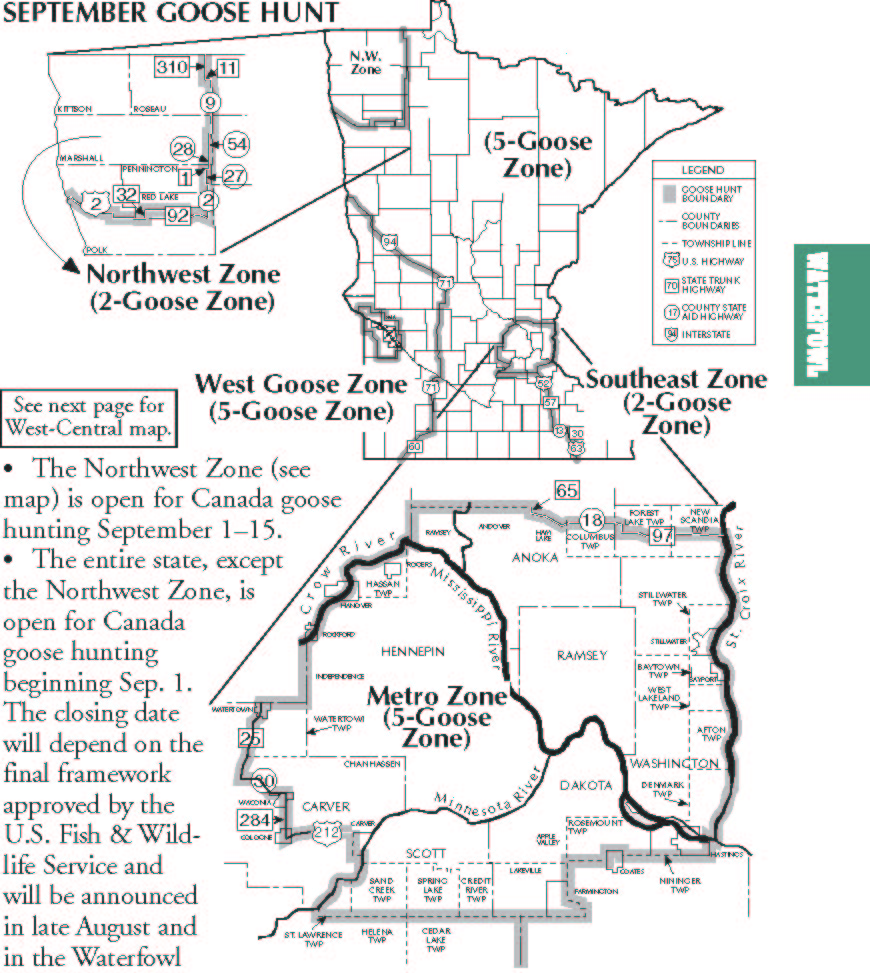
Hunting Regulations
Continued on next page.
Supplement.
87
2002 Minnesota Hunting Regulations

• Shooting hours are one-half hour before sunrise to sunset each day.
• Daily bag limits are shown on the maps
by zone. Possession limits are double the daily bag limits.
• A person may not shoot at geese while the person is within 100
yards of any surface water. “Surface water” includes, but is not
limited to wetlands, lakes, rivers, and streams, except temporarily
flooded cropland, hayland, pasture, or other temporarily flooded
areas (unless they are contiguous with lakes, wetlands, rivers, or
streams). This restriction does not apply:
1. for youth hunters participating in the Youth Waterfowl Hunt;
2. in the West Goose Zone; and
3. in other areas as specifically authorized.
• In the West Goose Zone (including the West-Central and Lac qui Parle Zones) geese may be taken within 100 yards of surface water for the entire September Goose Hunt.
• All other goose hunting regulations in this handbook apply during the September season.
• The controlled hunting zone at Lac qui Parle WMA is closed to hunting during the September season.
• The controlled hunting zones at Talcot Lake WMA and Thief Lake WMA are open to hunting during the early September goose sea-son, subject to the controlled hunting zone regulations on pages 94-97. The Talcot Lake CHZ is also open for the special December goose hunt.
• These goose and waterfowl refuges are open to hunting during the Sept. season: Goose Refuges: Douglas County; Southwest Otter
88
Waterfowl

Tail County (Fergus Falls); Ashby in Grant County and Sauk Rapids–Rice in Benton County; Waterfowl Refuges: Harstad Slough in Stevens County.
NOTE: The Evansville State Game Refuge in Douglas County and the Bemidji State Game Refuge in Beltrami County are open for taking of Canada geese only during the early September season (see pages 114-116 for a list of all state game refuges open to goose hunting).
• Taking Canada geese on public roads and rights-of-way is pro hibited during the early season in the Metro Zone and in Goose Refuges open to goose hunting.
YOUTH WATERFOWL HUNT
A youth waterfowl hunting day will be announced in late August and in the Waterfowl Hunting Regulations Supplement. The tentative date for 2002 is Sept. 14.
GENERAL RESTRICTIONS Non-toxic Shot Required
It is unlawful to take geese, ducks, mergansers, coots, or moorhens with lead shot or while having any lead shot in possession. This restric tion includes muzzle-loading shotguns and taking pen-reared mallards on commercial shooting preserves. Only steel shot, copper-, nickel-, or zinc-plated steel shot, bismuth tin shot, tungsten-iron shot, tungsten-nickel-iron shot, tungsten-polymer shot, tungsten-matrix shot, or other shot approved by the U.S. Fish and Wildlife Service may be used.
Shooting Hours
See separate Waterfowl Hunting Regulations Supplement, available in early September.
o
Opening Day Possession Limit
On the opening day of the season, no person may possess more freshly killed migratory game birds than is allowed by the daily bag limit.


Continued on next page.
89
2002 Minnesota Hunting Regulations
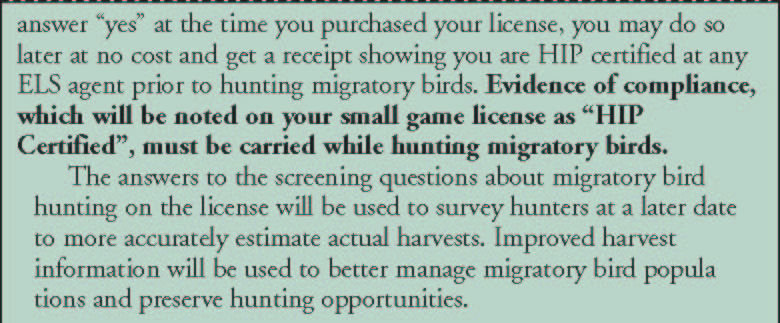
Retrieval
A person may not kill or cripple any migratory game bird without making a reasonable effort to retrieve the bird and include it in the daily bag limit.
o
Taking in Open Water
A person may not take migratory waterfowl, coots, or rails in open water unless that person is:
a) within a natural growth of vegetation sufficient to partially conceal the person or boat, or
b) pursuing or shooting wounded birds (while in compliance with the watercraft restrictions listed below).
Watercraft
• A person using watercraft to take migratory waterfowl must comply with the provisions for “Taking in Open Water” specified above.
• Migratory waterfowl may be taken from a floating watercraft if the craft is drifting, beached, moored, resting at anchor, or is being propelled by paddle, oars, or pole.
• Migratory waterfowl may be taken from a watercraft propelled by motor or sails only if the motor is shut off and the sails are furled and the watercraft has stopped.
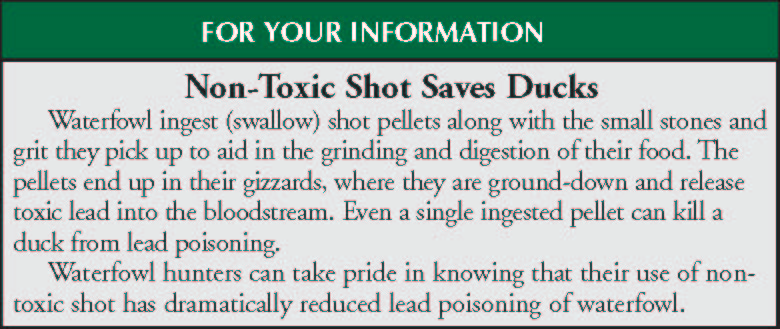
90
Waterfowl

• A person may not transport any firearm in a boat or other watercraft being propelled by motor or sail unless the firearm is unloaded and contained in a case. (See pages 25-27 for complete arms restrictions.)
• All watercraft (including boats used for duck hunting during the duck season) are required to carry and have readily accessible, one U.S. Coast Guard (USCG) approved wearable (Type I, II, or III) personal flotation device (PFD or life preserver) for each person on board. In addition, boats 16 feet or longer (except canoes and kayaks) must carry at least one USCG approved Type IV throw-able device (boat cushion or ring buoy) for the boat. Due to change in federal requirements, boat cushions are no longer acceptable as primary life saving devices.
• During open waterfowl seasons, a person may not leave an unattended boat used for hunting waterfowl in public waters between sunset and one hour before sunrise unless the boat is adjacent to private land under control of the person and the water does not contain a natural growth of vegetation sufficient to partially conceal a hunter or a boat.
• A duck boat does not have to be licensed during the Waterfowl Hunting Season for waterfowl hunting only.
Blinds and Sink Boxes
• No person may erect a blind in public waters or on public land more than one hour before the open season for waterfowl.
• No person may take migratory waterfowl, coots, or rails using a sink box* or in public waters from a permanent artificial blind.
• Any blind on public land or in public waters when not in use is considered public and not the property of the person who con structed it. Any use of threat or force against another person to gain possession of a blind is unlawful.

* A sink box is a structure that allows a hunter to partially hide beneath the water surface.
Decoys
• No person may place decoys on public lands or in public waters more than one hour before legal shooting hours for waterfowl.
• No person may leave decoys on public waters between sunset and one hour before legal shooting hours, except decoys may be left in waters:
a) adjacent to private land under control of the hunter; and
b) where there is not sufficient natural vegetation growing in the water to partially conceal a hunter. A person may not leave
91
2002 Minnesota Hunting Regulations
decoys in public waters between sunset and one hour before shooting hours if the decoys constitute a navigational hazard.
Airboats Prohibited on Lakes Designated for Wildlife Use
The use of airboats is prohibited at all times on the following lakes, which have been designated for wildlife management purposes, except as
specifically authorized:
Lake County Lake County
White Elk Aitkin Heron Jackson
Cottonwood Blue Earth Sanborn LeSueur
Perch Blue Earth Pierce Martin
Eagle Blue Earth Onamia Mille Lacs
Rice Blue Earth Maria Murray
Hanska Brown South Badger Murray
Patterson Carver North Badger Murray
Tiger Carver Swan Nicollet
Big Rice Cass Little Rice St. Louis
Augusta Cottonwood Big Rice St. Louis
Dog Crow Wing Sand Sibley
Christina Douglas/Grant Rice Steele/Dodge
Rice Faribault Hassel Swift
Minnesota Faribault Buffalo Waseca
Bear Freeborn Goose Waseca
Lower Twin Freeborn Willis Waseca
Geneva Freeborn Pelican Wright
Upper Twin Freeborn Spellman (N. and S.) Yellow Medicine
Ash Grant
Whitefish Netting Season Open
The whitefish netting season on Leech Lake and other lakes is open during duck season. Be careful when venturing near buoys.
o
Possessing and Transporting Migratory Waterfowl
• A person may not possess or transport unlawfully taken migra tory game birds.
• Migratory waterfowl must be transported in an undressed condi tion (ducks and mergansers with head and wing attached; geese with wing attached) at all times until delivery to either the taker’s residence or a commercial processing facility.
92
Waterfowl

MIGRATORY WATERFOWL FEEDING AND RESTING AREAS
The following areas have been designated Migratory Waterfowl Feeding and Resting Areas, and are posted as such during the open waterfowl season.
No person may use any motor-propelled watercraft or aircraft in posted migratory waterfowl feeding and resting areas during the open waterfowl season, except electric trolling motors of less than 30 pounds thrust may be used on lakes as indicated by the asterisk (*) in the table below:
COUNTY LAKES
Beltrami Puposky Lake* and Little Puposky Lake*
Big Stone, Part of Marsh Lake Lac qui Parle and Swift
Blue Earth Cottonwood Lake
Carver Tiger Lake*
Cass Big Rice Lake
Clearwater Upper Rice Lake
Faribault Part of Minnesota Lake*
Freeborn Bear Lake*
Grant and Douglas Part of Lake Christina
Itasca Rice Lake (near Max) and Nature‘s (Squaw) Lake
Jackson Part of South Heron Lake* and all of North
Heron Lake* except Winzer Bay and North Marsh Kandiyohi Wagonga Lake* and Lake Lillian* LeSueur Dora, Diamond, Sanborn and Scotch lakes McLeod Bakers Lake* and the unnamed lake* in
Sec. 28, Twp. 114N., R. 29 W. (Penn Twp.) Nicollet Oakleaf Lake Otter Tail That part of Lake Lizzie, also known as
Rush Lake, located in Sec. 3–9, Twp. 136 N., R.
42 (Lida Twp.); and Mud Lake in Aastad Twp. Polk Turtle Lake* Pope Lake Nelson* and Lake Johanna Scott Pleasant Lake Sibley Washington Lake and Mud Lake in Washington Lake
Twp. Traverse Part of Mud Lake*
STATE DUCK REFUGES
In those portions of state Wildlife Management Areas and federal Waterfowl Production Areas posted as duck refuges, trespass is prohibited from September 1 through the final day of the open duck season, or as otherwise posted.
93

2002 Minnesota Hunting Regulations
CONTROLLED HUNTING ZONES
Waterfowl or small game hunting, as specified, is restricted to designated hunting sta tions in the portions posted as controlled hunt ing zones on or adjacent to the Lac qui Parle, Roseau River, Thief Lake, Talcot Lake, and Orwell Wildlife Management Areas, and the Rochester Game Refuge.
For additional information on wildlife man agement areas, waterfowl production areas and refuges see pages 109–126.
o
General Restrictions
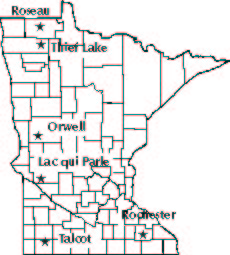
The following regulations apply to persons within all the con-trolled hunting zones during the open Canada goose seasons or as otherwise specified:
• No more than one hunting party, consisting of no more than three hunters, may occupy any hunting station at one time.
• Waterfowl hunters must have their guns unloaded and cased except within 10 feet of a hunting station.
• The hunting and taking of migratory waterfowl is limited to a distance of within 10 feet of each designated hunting station, except hunters may retrieve downed birds away from a posted sta tion if they comply with all other refuge and trespass regulations.
• On public lands, dogs must be on a leash except within 10 feet of stations or while retrieving, and must be under control at all times.
• All persons occupying a hunting station must meet all license requirements to hunt waterfowl in Minnesota.
• No person may leave any refuse, offal, or feathers on public lands in the controlled hunting zone or in any parking lot or desig nated overnight use area on the management area.
• No alcoholic beverages may be consumed or possessed at any of the hunting stations on public lands.
• No person may loiter between the designated hunting stations on public lands.
• On public lands, after each party member has bagged a limit of Canada geese or expended their limit of shells (if applicable), the party must promptly leave the station.
• No trailers of any kind are allowed in designated parking lots. Lac qui Parle
The following regulations apply to all persons in the Lac qui Parle Controlled Hunting Zone during the regular Canada Goose Season for that zone:
94
Waterfowl

Reservations and Permits
• Waterfowl and small game hunters may reserve hunting stations in accordance with rules available at the Lac qui Parle Wildlife Management Area headquarters (see page 85). Reserved dates will not be changed. For information, contact: Lac qui Parle WMA, 14040 20th St. NW, Watson, MN 56295.
• On public lands, no person may hunt migratory waterfowl or small game in the controlled hunting zone without first register ing at the check station and obtaining a back tag permit. There is a daily fee of $3 per hunter 18 years and older.
• The transfer of back tag permits to other hunters is prohibited.
Hunting Restrictions
• Waterfowl and small game hunters are limited to six shells per day in possession.
• Not more than six hunting groups per day may occupy a designated hunting station.
• Within one hour of hunt completion, each party member must submit any geese taken for inspection at the Lac qui Parle WMA headquarters and, if hunting on public lands, personally return their entry permit to the check station.
• Waterfowl and small game hunters are limited to three trips to the stations during the Canada goose season, either as a guest or a successful applicant, except when vacant stations exist.
• Waterfowl and small game hunters must have guns unloaded and cased except within 10 feet of assigned hunting stations.
• Hunters are limited to one trip per day to the hunting stations.
Thief Lake
The following regulations apply to waterfowl and small game hunters in the Thief Lake Controlled Hunting Zone (CHZ) during all open waterfowl seasons (including Early September and Late December Canada Goose and Youth Waterfowl Seasons). The restriction on small game hunting in the CHZ applies from the opening of the regular waterfowl season through October 21.
•Hunters must use designated hunting stations on a first-come, first-served basis. •Hunters are limited to one trip to the blinds before noon, and one trip after noon, per day.
•Hunters are limited to six shells per trip in possession.
•Hunters must have guns unloaded and cased except within 10 feet of the hunting stations.
95

2002 Minnesota Hunting Regulations
•Selected blinds will be posted closed during the early September Canada Goose Season because of their proximity to open water.
•No person may park in or otherwise occupy any designated CHZ parking lot or occupy any hunting station from 10 p.m. to 5 a.m.
Orwell The following regulations apply to all persons in the Orwell Controlled Hunting Zone during the Regular Goose Season:
• Hunting, other than waterfowl, is prohibited.
• No person may enter the controlled hunting zone except when their vehicle is occupying a numbered parking stall in the designated parking lot in the controlled hunting zone.
• No persons other than those hunting at a station in the con-trolled hunting zone may occupy a numbered stall in a desig nated parking lot.
• Hunters must hunt only at the hunting stations having a number corresponding to their parking stall number.
• No person may park in or otherwise occupy any parking stall in the designated parking lot or occupy any hunting station during any two consecutive days or from one hour after the close of daily waterfowl shooting hours to 8 p.m.
• All guns must be unloaded and cased except within 10 feet of
a hunting station .
Rochester and Roseau River
The following regulations apply to all persons in the Rochester and Roseau River Controlled Hunting Zones during the open Goose Season:
• The wildlife manager may limit all persons to one day of hunting in every three. If hunting is limited, the manager will stamp the date on the Small Game Hunting License or Firearms Safety Certificate of every person at each restricted hunting station. Persons may hunt at any restricted station on the day stamped, but may not occupy a restricted station for the next two days. Restricted stations will be posted.
• No one may be in a hunting station or designated parking lot from one hour after the close of the daily waterfowl shooting hours to 8 p.m.
96
Waterfowl

Talcot Lake
Closed Area All waterfowl hunting is prohibited upon or from the 1.5 mile
segment of State Trunk Highway 62 and its right-of-way along the
south boundary of the Talcot Lake Waterfowl Refuge (between the
Cottonwood County line on the west and County Highway 7 on
the east). The following regulations apply to all persons in the Talcot Lake controlled hunting zones during Canada Goose Seasons:
General Restrictions
• Hunting, other than waterfowl, is prohibited on public land in the East and West Side Controlled Hunting Zones.
• The wildlife manager may limit persons to one day of hunting in every three. The manager will stamp the date on the Small Game Hunting License or Firearms Safety Certificate of each person at a restricted hunting station. Persons may hunt at any restricted station on the day stamped, but may not occupy a restricted station for the next two days. Restricted stations will be posted.
• No persons may occupy a hunting station within a controlled hunting zone except when their vehicle is occupying a numbered parking stall in a designated parking lot in the controlled hunting zone. No persons other than those hunting at a hunting station may occupy a numbered stall or park in a designated parking lot.
• Waterfowl hunters must hunt only at the hunting stations having numbers corresponding to their parking stall number.
• No person may park in or otherwise occupy any parking stall in the designated parking lot or occupy any hunting station from 10 p.m. to 5 a.m.

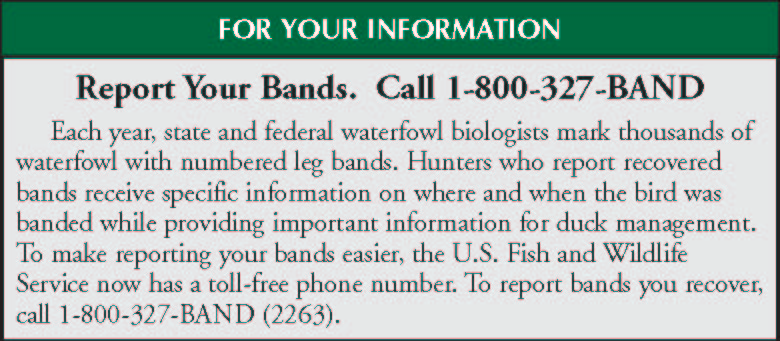
97
2002 Minnesota Hunting Regulations
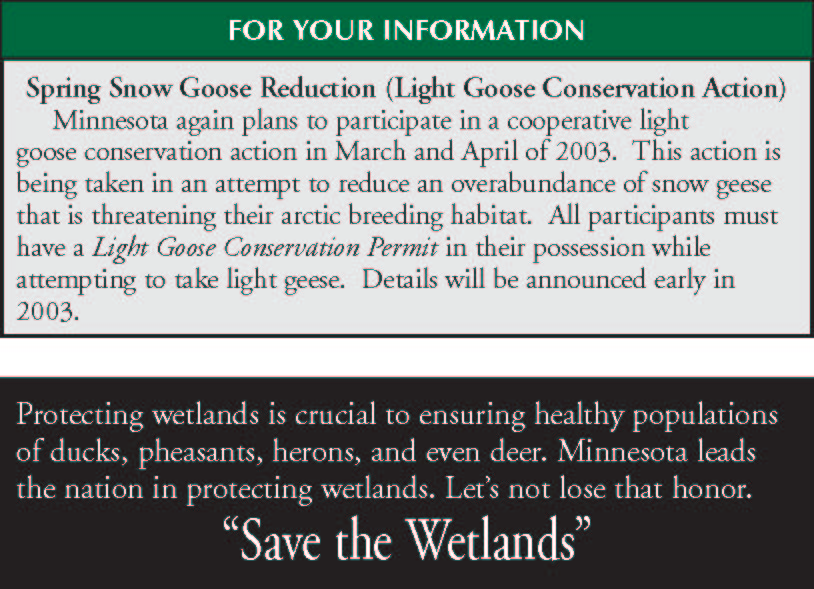
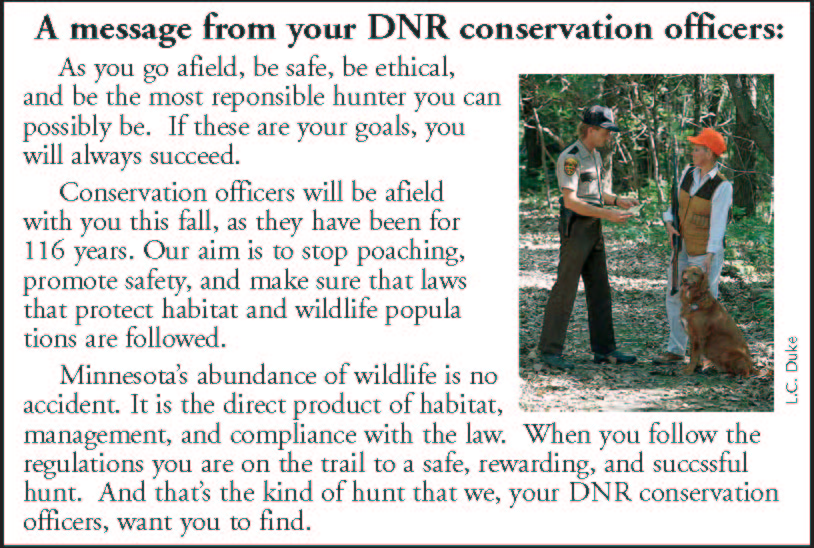
98

2002 Minnesota Hunting Regulations
on, or over areas where hunters are attempting to take them. Agricultural areas must be prepared in accordance with official recommendations to be legally hunted. It is a separate offense to place or direct placement of bait on or adjacent to an area that causes, induces, or allows another to hunt by the aid of bait or over a baited area. Hunters are responsible for ensuring that an area has not been baited and should verify its legality prior to hunting. The maximum federal penalties are: for hunting over bait: $15,000/ 6 months jail, and placing bait $100,000/1 year jail.
Closed Season
No person shall take migratory game birds during the closed season.
Shooting or Hawking Hours
No person shall take migratory game birds except during the hours open to shooting and hawking as prescribed.
Daily Bag Limit
No person shall take in any one day more than one daily bag limit.
Field Possession Limit
No person shall possess more than one daily bag limit while in the field or while returning from the field to one’s car, hunting camp, home, etc.
Wanton Waste
All migratory game birds shall be retrieved, if possible, and retained in the custody of the hunter in the field.
Tagging
No person shall give, put or leave any migratory game birds at any place or in the custody of another person unless the birds are tagged by the hunter with the following information: a) hunter’s signature;
b) hunter’s address; c) total number of birds involved, by species; and d) dates such birds were killed.
Tagging is required if the birds are being transported by another person for the hunter, or if the birds have been left for cleaning, stor age (including temporary storage), shipment, or taxidermy services.
Possession of Live Birds
Wounded birds reduced to possession shall be immediately killed and included in the daily bag limit.
Dressing
No person shall completely field dress any migratory game bird (except doves and band-tailed pigeons) and then transport the birds from the field. The head or one fully feathered wing must remain
100
2002 Minnesota Hunting Regulations
on, or over areas where hunters are attempting to take them. Agricultural areas must be prepared in accordance with official recommendations to be legally hunted. It is a separate offense to place or direct placement of bait on or adjacent to an area that causes, induces, or allows another to hunt by the aid of bait or over a baited area. Hunters are responsible for ensuring that an area has not been baited and should verify its legality prior to hunting. The maximum federal penalties are: for hunting over bait: $15,000/ 6 months jail, and placing bait $100,000/1 year jail.
Closed Season
No person shall take migratory game birds during the closed season.
Shooting or Hawking Hours
No person shall take migratory game birds except during the hours open to shooting and hawking as prescribed.
Daily Bag Limit
No person shall take in any one day more than one daily bag limit.
Field Possession Limit
No person shall possess more than one daily bag limit while in the field or while returning from the field to one’s car, hunting camp, home, etc.
Wanton Waste
All migratory game birds shall be retrieved, if possible, and retained in the custody of the hunter in the field.
Tagging
No person shall give, put or leave any migratory game birds at any place or in the custody of another person unless the birds are tagged by the hunter with the following information: a) hunter’s signature;
b) hunter’s address; c) total number of birds involved, by species; and d) dates such birds were killed.
Tagging is required if the birds are being transported by another person for the hunter, or if the birds have been left for cleaning, stor age (including temporary storage), shipment, or taxidermy services.
Possession of Live Birds
Wounded birds reduced to possession shall be immediately killed and included in the daily bag limit.
Dressing
No person shall completely field dress any migratory game bird (except doves and band-tailed pigeons) and then transport the birds from the field. The head or one fully feathered wing must remain
100

2002 Minnesota Hunting Regulations
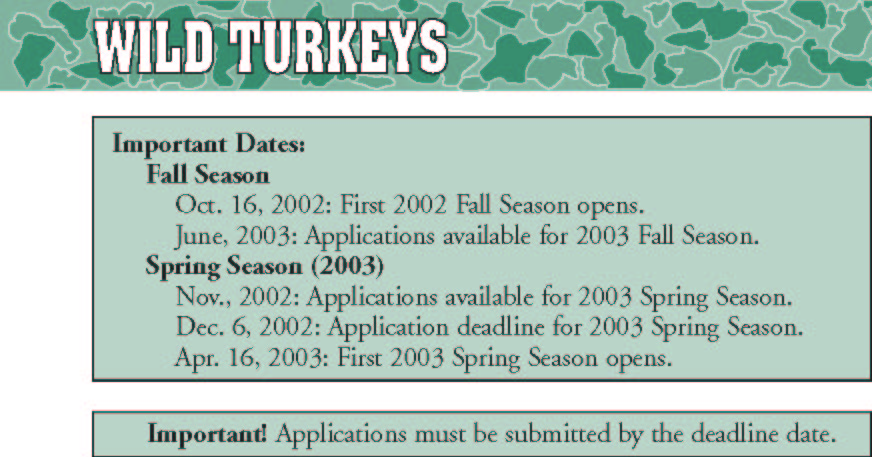
The following general regulations apply to the taking of wild turkeys during Fall and Spring Hunts in Minnesota:
LICENSE REQUIREMENTS
Licenses for the Fall and Spring Wild Turkey Hunts are awarded in separate computerized preference drawings. A small game license is not required to hunt wild turkeys.

LEGAL FIREARMS AND BOWS AND ARROWS Firearms
• A person may only use shotguns 20 gauge or larger, or muzzle-loading shotguns 12 gauge or larger.
• Only fine shot size No. 4 and smaller diameter may be used. Bows and Arrows
• Bows must have a pull of no less than 40 pounds at or before full draw.
• Bows may not be drawn, held, or released by mechanical means, except by permit. A person may use a mechanical device attached to the bowstring if the person’s own strength draws and holds the bowstring.
• Arrowheads must be broadheads that are sharp, have at least two
102
Wild Turkeys

metal cutting edges, are of barbless design, and are at least 7⁄8 inch
in diameter; or must be of a blunthead design. • “Retractable” broadheads that meet all other requirements of law are legal for wild turkeys if they: 1) are at least 7⁄8 inch in width at or after impact; and 2) are of a barbless design and function in a barbless manner.
• No person may use any arrow that is poisoned or has an explo sive tip.
How to Apply for Wild Turkey Licenses
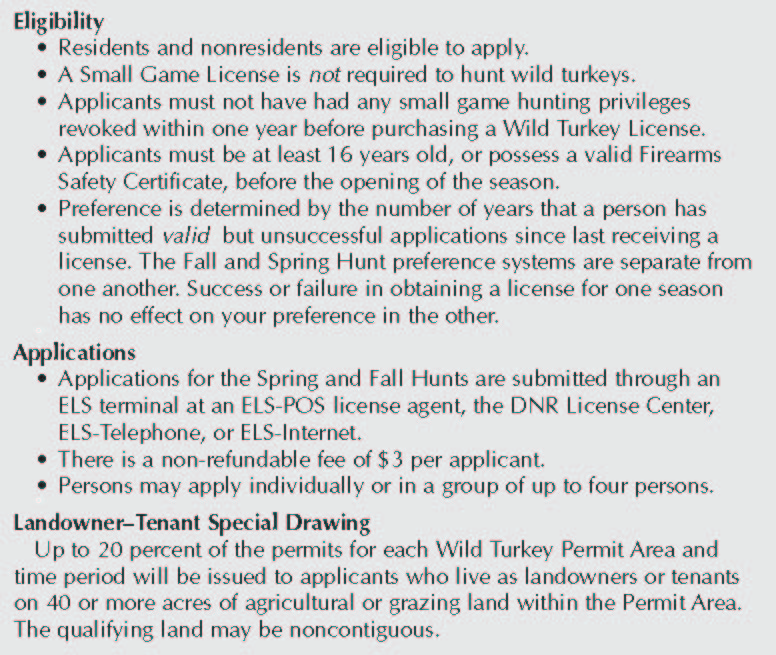

PARTY HUNTING
• A licensed wild turkey hunter may only assist another turkey hunter licensed for the same permit area and time period, and may not shoot or tag a turkey for another hunter.
GENERAL RESTRICTIONS
• Wild turkeys may not be taken with the aid of dogs. No person may be accompanied by a dog or dogs while hunting or assisting in hunt ing wild turkeys.
103
2002 Minnesota Hunting Regulations
• Wild turkeys may not be taken with the aid of any electronic device, except that a hearing aid or other device designated to enhance hearing may be used.
• The use of live turkey decoys is prohibited.
• No persons who are afield hunting wild turkeys may have in their possession or in their control any firearm or bow and arrow except those defined as legal for taking wild turkeys.
TAGGING
• The tag provided with the license must be punched with the date of the kill, signed, and attached to the wild turkey immediately after taking the bird.
• The tag must remain attached to the bird during transit.

Dates, Wild Turkey Permit Areas and Quotas
2002 Fall Wild Turkey Hunting Permits have already been allo cated by a computerized drawing for five-day hunting periods run ning October 16–20 and October 23–27. Applications for 2003 Fall Wild Turkey Hunting Permits will be available June, 2003:
Legal Shooting Hours
The legal shooting hours for the Fall Wild Turkey Hunt are one-half hour before sunrise until sunset.
Bag Limit
The bag limit for the Fall Hunt is one wild turkey of either sex.
Registration
• Every person who takes a wild turkey must register the bird at a designated registration station no later than 24 hours after the time when taken.
• The feathers, head and feet must remain on the wild turkey until it is registered.
• No person may possess an unregistered wild turkey outside the permit area where the bird was taken unless it is being trans-ported in a direct route to a registration station.
104

The following general regulations apply to Minnesota’s Spring Wild Turkey Hunt. Complete information on 2003 spring wild turkey season dates, permit areas, and quotas was not available when this booklet was printed. This information will be provided with application materials available in November, 2002. Resident wild turkey applications will be made through ELS license agents.
Bag Limit
The spring bag limit is one wild turkey with a visible beard. The beard is a feathered appendage protruding from the breast that is generally found only on males.
o
Registration
• Every person who takes a wild turkey must personally present the bird for registration.
• The feathers, head, and feet must remain on the wild turkey until it is registered.
• No person may possess an unregistered wild turkey outside the permit area where it was taken unless it is being transported in a direct route to a registration station.

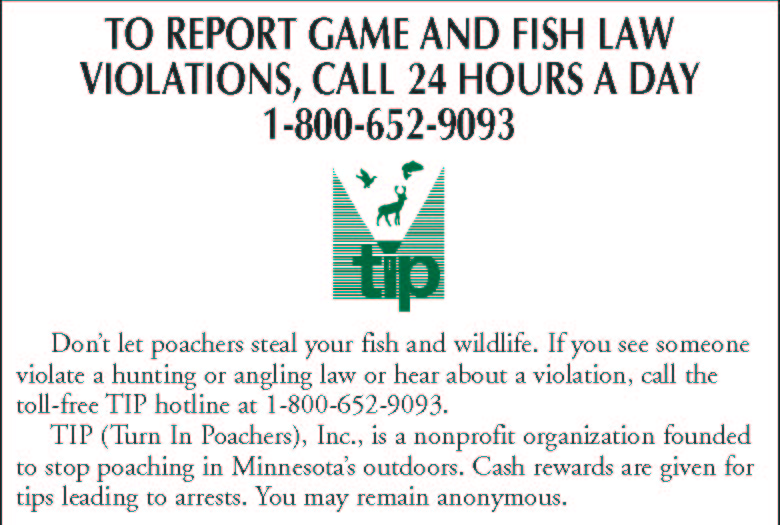
105
2002 Minnesota Hunting Regulations

LICENSE REQUIREMENTS
Harvesting wild rice is open to Minnesota residents only. All har vesters are required to be licensed unless they are under 16 years of age and accompanied by a licensed harvester. Wild rice licenses are available from ELS license agents. Fees from wild rice harvest and buyer licenses are deposited in a special account for wild rice management.
SEASON DATES AND HOURS
July 15 to September 30, from 9 a.m.-3 p.m. daily.
The harvest of green (unripe) wild rice is unlawful.
RESTRICTED AREAS
Conservation officers and other authorized agents of the Commis sioner of Natural Resources may close the harvest on any public water by posting the known access points.
National Parks and National Wildlife Refuges are closed to wild rice harvesting, except when authorized by special permits. Harvest is allowed on state wildlife management areas, except where specifically closed by posting or rule.
VEGETATION
Destruction of wild rice plants by cutting, pulling, or removing is unlawful. All aquatic vegetation must be removed from watercraft before leaving any body of water to prevent the spread of exotic vegetation such as purple loosestrife and Eurasian water milfoil.
WATERCRAFT
Watercraft used in harvesting wild rice may not exceed 18 feet in length or 36 inches in maximum width. Any extension that increases normal capacity is prohibited.
PUSH POLES
Push poles used to propel watercraft for harvesting wild rice must be forked at the end. The forks must be less than 12 inches in length.
FLAILS
Flails used to harvest wild rice must be made of round, smooth wood no longer than 30 inches and weigh no more than one pound. Flails must be hand held and operated.
106
Wild Rice
MECHANICAL DEVICES
The use of any machine or mechanical device to harvest wild rice is prohibited unless the operator holds fee title to all the property that sur rounds the public water where the harvest is taking place and the public water is less than 125 acres in size, within the original boundaries of any Indian reservation, and there is no public access directly or through a channel or watercourse.
PENALTIES
Any person violating any of the laws or rules pertaining to wild rice is subject to a fine up to $1000 and/or 90 days in jail.
INDIAN RESERVATION RESTRICTIONS (GENERAL)
All native wild rice within the existing boundaries of the White Earth, Leech Lake, Bois Forte, Grand Portage, Fond du Lac, and Mille Lacs Indian Reservations is managed by the respective reservation wild rice committees. These committees establish the opening date, days, and hours of harvest no less than 24 hours prior to the opening. These regu lations may be altered by the wild rice committees after the season has been announced by posting the major entrances to affected waters no less than 12 hours prior to the changes taking effect.
Only the Commissioner of Natural Resources, authorized agents, tribal members, and persons who are residents of the reservation within which they are harvesting may harvest or gather wild rice within the boundaries of reservations.
SPECIAL LEECH LAKE INDIAN RESERVATION RESTRICTIONS
In addition to the above regulations, all non-tribal members must have Leech Lake Reservation permits to harvest or buy wild rice within the boundaries of the Leech Lake Reservation.

107
2002 Minnesota Hunting Regulations
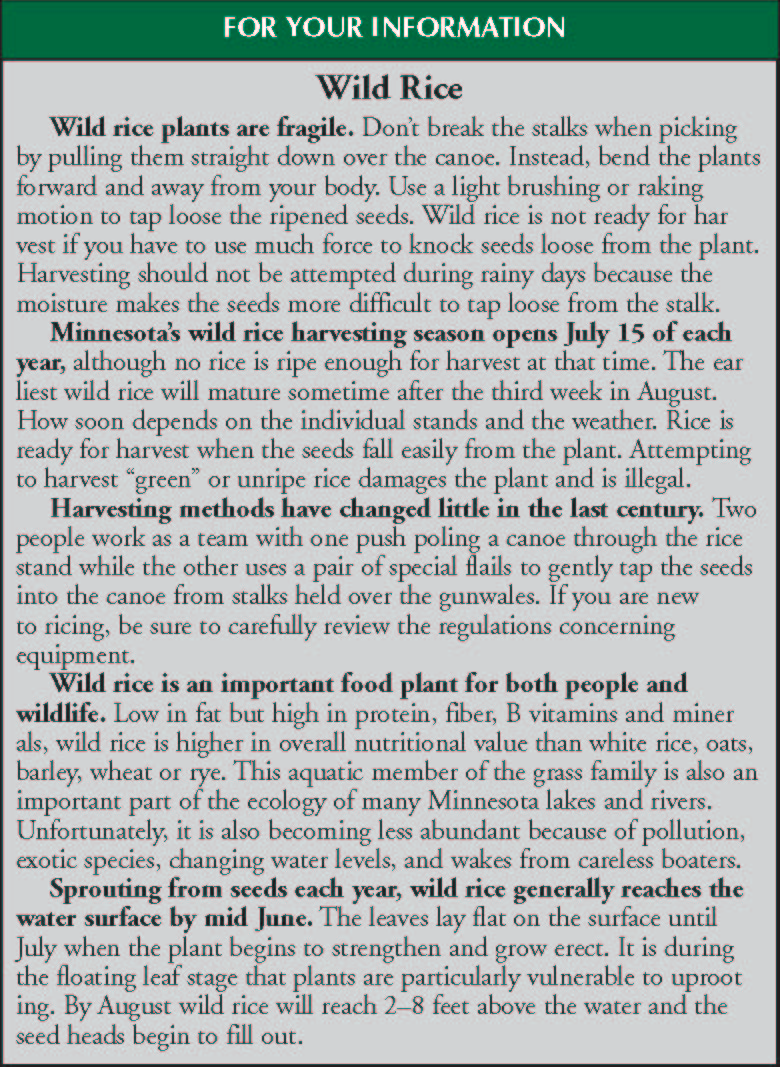
108
Public Lands & Wildlife Refuges

All public land in state-owned Wildlife Management Areas (WMAs) is open to the hunting of all species of protected wild animals and trapping of mammals during the established seasons found in this booklet, except as follows:
General Restrictions
• Trespass: Portions of WMAs posted closed to trespassing may not be entered without DNR authorization.
• Closed Hours: WMAs may not be entered or used during closed hours if posted with these restrictions at major access points, except by permit.
• Camping: Camping is prohibited except in designated overnight-use areas or with a permit from the wildlife manager.
• Alcohol: Alcoholic beverages may not be consumed, except by persons lawfully occupying an overnight-use area.
• Firearms and Target Shooting: Target, skeet, trap, or indiscrimi nate shooting is prohibited. A person may not possess an uncased or loaded firearm or an uncased or strung bow, except when law-fully taking a wild animal or by permit.
• Destruction or Removal of Property: Signs, posts, fences, gates, buildings, trees, shrubs, vines, plants, or other property may not be destroyed or removed (including use of metal detectors to remove property), except as follows: Wetland vegetation may be used to build blinds on the area, and edible fruits and seeds, or decorative portions of plants may be removed for personal use.
• Garbage Disposal and Animal Abandonment: Disposing of or abandoning live animals, carcasses, garbage, trash, spoil, sludge, rocks, vehicles, or other debris or personal property on any WMA is prohibited.
• Hunting, Fishing, and Trapping Equipment: Boats, decoys, and other equipment must not be left unattended overnight, with the exception of traps in areas open to trapping and fish houses or dark houses in certain designated WMAs.
• Blinds and Structures: A person may not construct or maintain any building, dock, fence, billboard, sign, or other structure on any WMA, except that temporary waterfowl blinds may be erected, but may not become private property or be used to
109

2002 Minnesota Hunting Regulations
preempt hunting rights. Any materials brought into a WMA for the construction of a blind must be removed each day at the close of hunting hours.
• Elevated Stands: A person may not construct, occupy, or use any elevated scaffold or other elevated device for the purpose of hunt ing, watching, or killing wild animals, except that portable stands may be used if they are removed each day at the close of hunting hours and do no permanent damage.
• Dogs: Dogs are permitted on WMAs only when accompanied by or under the control of the owner. From April 16 through July 14, dogs must be on a leash. A person training a dog on a WMA may not use live ammunition or blank cartridges, including the use of blanks in dummy launchers or similar devices.
• Other Domestic Animals: Livestock, horses, and other domestic animals, are not permitted on WMAs except under cooperative agreement or permit approved by the wildlife manager.
• Unprotected Animals: Unprotected wild animals may be taken from September 1 through the last day of February, or by any person legally hunting a protected species, unless the area is specifically closed.
• Beaver and Otter: Beavers and otters may only be taken by per mit issued by the wildlife manager.
• Crows: Crows may be taken during established seasons, except from March 1 through August 31, unless the area is specifically closed.
WMAs with Special Restrictions
• Bayport WMA (Washington County) and Raguet WMA (Scott and Carver counties): These areas are closed to the trapping of un protected mammals except when there is an open trapping season for any protected species. Firearms must be unloaded and contained in a case, except in designated hunting areas during the season for the taking of small game when shotgun with fine shot only is per mitted. The possession and use of bows and arrows are limited to the designated hunting areas during established hunting seasons.
• Boerner WMA (Sibley County), Buelow WMA (Steele County), Bryson WMA (Freeborn County), Sand Prairie WMA (Stearns County), Chapa Kay-Say-Za WMA (Steele County), and Hutchinson WMA (McCleod County): These areas are closed to the hunting and trapping of all species.
• Gold Portage WMA (Koochiching and St. Louis counties): This area is open only to waterfowl hunting.
• Hearding Island WMA (St. Louis County): This area is closed to the hunting of all species.
• Uppgaard WMA (Crow Wing County): This area is open to
110
Public Lands & Wildlife Refuges
hunting beginning on the opening day of waterfowl hunting or
on the second Saturday in October, whichever comes first. • Four Brooks WMA (Mille Lacs County): This area is closed to woodcock hunting.
• Gordon F. Yeager (Rochester) WMA (in the Rochester Refuge, Olmsted County) Eastside WMA (Olmsted County), and Carl Schmidt WMA (Morrison County): These areas are closed to waterfowl hunting. Firearms are restricted to shotgun with fine shot only for small game hunting on Gordon F. Yeager WMA.
• Lac qui Parle, Thief Lake, Talcot Lake, and Orwell WMAs: Small game hunting is restricted in the Controlled Goose Hunting Zones (see pages 94-97).
• Lake Blanche WMA (Ottertail County): This area is closed to firearms deer hunting.
• Timber Lake WMA (Jackson County): A portion of this area is closed to firearms deer hunting (as posted).
• Pike Bay WMA (St. Louis County): This area is closed to trapping of all species.
• Schrafel WMA (Mower County): This area is closed to trapping and firearms hunting. Open to archery deer hunting.
• Hvoslef WMA (Fillmore County): This area is open to archery hunting only from September 1 through October 31 and during the spring turkey season. Firearms hunting (no centerfire rifles) is allowed from November 1 through December 15.
Note: Trappers must obtain a permit from the area manager on the following WMAs: Carlos Avery (Anoka and Chisago counties), Hubbel Pond (Becker County), Red Lake (Beltrami and Lake of the Woods counties), Lac qui Parle (Big Stone, Lac qui Parle, Swift, and Chippewa counties), Mille Lacs (Mille Lacs and Kanabec counties), Roseau River (Roseau County), Talcot Lake (Cottonwood and Murray counties), Thief Lake (Marshall County), and Whitewater (Olmsted, Wabasha, and Winona counties).
Wild Rice
A person may harvest wild rice in a WMA, except where specifically closed.
Ginseng
A person may not harvest wild ginseng in a WMA, except by permit.
Motor Vehicles
The following regulations apply to motor vehicle use on WMAs other than on federal, state, county, or township roads:
111

2002 Minnesota Hunting Regulations
• Motor vehicles licensed for use on a public highway may be oper ated on established roads on the following WMAs, but not at speeds over 20 m.p.h. unless posted otherwise. No vehicles may be driven beyond a sign prohibiting vehicular use, beyond any con structed vehicle barrier, or in a reckless or careless manner. The areas are: Carlos Avery (Anoka and Chisago counties), Hubbel Pond (Becker County), Mille Lacs (Kanabec and Mille Lacs counties), Red Lake (Beltrami and Lake of the Woods counties), Roseau River (Roseau County), and Thief Lake (Marshall County).
• Vehicles are prohibited on all other WMAs. The exception is that vehicles may be operated at speeds of 20 mph or less, on travel routes designated with signs for travel purposes.
• No vehicle may be parked in front of any gate or where it obstructs travel.
• No person may operate an all-terrain vehicle (ATV), all-terrain cycle (ATC), hang glider, air boat, personal watercraft (jet-ski), or hovercraft in a WMA, except an ATV may be used by a licensed firearms deer hunter who does not possess a firearm (cased or uncased) to retrieve and transport a deer that is known to be dead from the close of shooting hours to two hours after the close of shooting hours during the regular firearms deer season and for one day after the season on Wildlife Management Areas north and west of a line described as follows: State Highway 1 from the west boundary of the state to State Highway 89, then north along State Highway 89 to Fourtown, then north on County State Aid Highway 44 to County Road 704, Beltrami County, then north on County Road 704 to Dick’s Parkway State Forest Road, then north on Dick’s Parkway to County State Aid Highway 5, then north on County State Aid Highway 5 to Warroad, then north on State Highway 11 to State Highway 313, then north on State Highway 313 to the north boundary of the state.
• Without written permission from the DNR, no person may operate a snowmobile in a WMA south of a line described as follows: U.S. Highway 2 from Grand Forks east to Bemidji, then south along U.S. Highway 71 to Wadena, then east along U.S. Highway 10 to Staples and U.S. Highway 210 to the eastern boundary of the state.
• No person may use aircraft over a WMA in a manner that chases, herds, scares, or otherwise disturbs wildlife, except in emergencies or by authorization of the wildlife manager.
Both the Lac qui Parle and the Talcot Lake Wildlife Management Areas have a limited number of goose hunting blinds for hunters

112
Public Lands & Wildlife Refuges
with disabilities. Talcot Lake WMA and Roseau River WMA each have a wheelchair accessible deer blind for firearms hunting. For more information, write to: Lac qui Parle WMA, 14040 20th St. NW, Watson, MN 56295; Talcot Lake WMA, Box 40, Rt. 1, Dundee, MN 56126; or Roseau River WMA, HCR#5 Box 103, Roseau, MN 56751.
Motorized Watercraft
The use of outboard motors (including electric trolling motors) or motorized water vehicles (including amphibious vehicles) is prohibited on waters within the boundaries of most state WMAs, except as follows:
Motorized Watercraft Permitted
AREA
Gold Portage WMA
Gores (Mississippi River Pool 3) WMA
Lac qui Parle WMA
(except where posted)
Mud-Goose WMA* (except on any day the waterfowl season is open)
Orwell Reservoir*
Roseau River WMA**
South Walnut Lake WMA*
Swamp River WMA
Talcot Lake WMA***
Thief Lake WMA*
COUNTY
Koochiching and St. Louis
Goodhue and Dakota
Big Stone, Lac qui Parle,
Chippewa, and Swift
Cass
Otter Tail
Roseau
Faribault
Cook
Cottonwood and Murray
Marshall

* Motor size is restricted to 10 horsepower or less on these units.
** There are no motor limits on the main channel and oxbows of the Roseau River. Elsewhere on the Roseau River, only motors of 10 horsepower or less may be used and only on days that the waterfowl season is open.
*** On the Talcot Lake WMA, motors are permitted on the lake (except on any day that the waterfowl season is open) but are prohibited on the river and marshes at any time of year.

GAME REFUGES A state game refuge is closed to the hunting and trapping of wild
animals unless listed below or in the table (pages 114-116). Even though
a refuge may be open, it could contain privately owned land on which the
landowner may prohibit hunting.
Continued on page 114.
113
2002 Minnesota Hunting Regulations

Continued on next page.
Hunting and Trapping on State Game Refuges
†† By written permission of landowners only.
††† Except turkey hunting by archery only
* Also open to wild turkey hunting. † Except during muzzleloader season.
Except open to Canada Goose Hunting during early September season.
Except goose hunting.
**
***
114
Public Lands & Wildlife Refuges

* Also open to wild turkey hunting.
** Except for Canada geese as announced separately.

115
2002 Minnesota Hunting Regulations
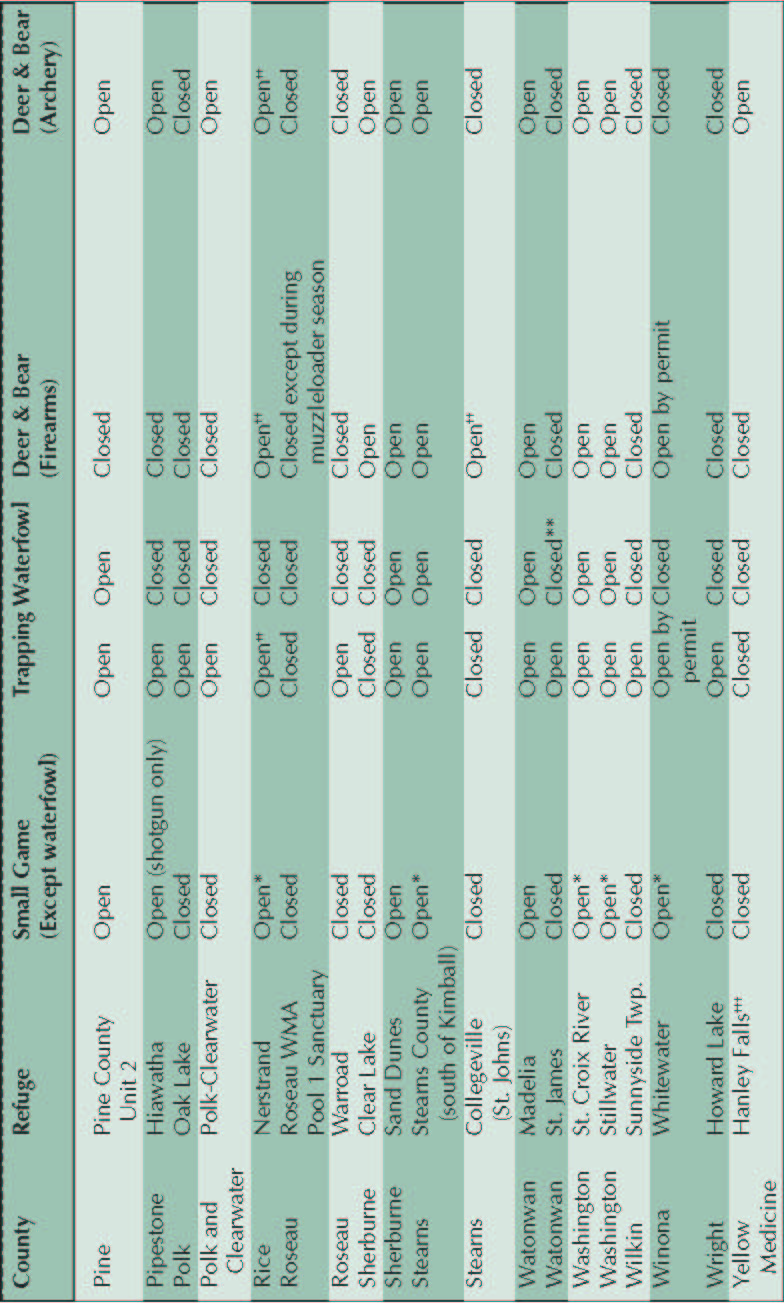
☞
*Also open to wild turkey hunting.
††By written permission of landowners only.
**Except for Canada geese as announced separately. †††Boundary changed, as posted.
116
Public Lands & Wildlife Refuges
General Restrictions
• A person may not trap beaver or otter within any state-owned game refuge without first obtaining a permit from the appropri ate wildlife manager.
• Unprotected wild animals may be taken when there is an open season for any protected species, but only during the hours and by methods allowed for the protected species.
Lac qui Parle Game Refuge (Chippewa and Lac qui Parle
counties) is open under the following restrictions: The portions of the refuge within the Lac qui Parle Recreation Reserve, Lac qui Parle Mission Site, or portions that are posted with “No Trespassing” signs are closed to hunting or the carrying or possession of firearms or bows unless the firearm is unloaded and cased or unloaded and contained in the closed trunk of a vehi cle, and the bow is unstrung and cased or contained in the closed trunk of a vehicle. The remainder of the refuge is open to: 1) waterfowl hunting only during the open Canada goose season in the Lac qui Parle Zone, only at designated hunting stations; 2) deer hunting; and 3) small game hunting other than waterfowl, except from the first day of the open Canada goose season through the last day of the open Canada goose season each year in the Lac qui Parle Goose Zone when small game hunting is allowed only at designated hunting stations. Small game hunting is not allowed on closed Canada goose hunting days during a split goose season. No unauthorized person may trespass during the dates posted on any part of the refuge posted with “No Trespassing” signs. The excep tions are as follows: 1) Fishing is permitted in the posted closed area within the Lac qui Parle Goose Zone on any day when goose hunting in the zone is closed; and 2) no person may trespass on Rosemoen Island at any time of the year, except for permitted par ticipants in disability hunts or those with specific authorization.
Rochester Refuge (Olmsted County) Unprotected animals may be taken at any time and by any
legal method.
Talcot Lake Game Refuge (Cottonwood County) The Talcot Lake Game Refuge is open to waterfowl hunting only at designated hunting stations only during the Canada goose season. The Talcot Lake Waterfowl Refuge is closed to waterfowl hunting, except for persons with disabilities hunting geese at designated hunting stations.
117

2002 Minnesota Hunting Regulations
DUCK REFUGES
From September 1 through the final day of the duck season, or as otherwise posted, a person may not hunt, trap, fish, or trespass on por tions of state wildlife management areas or federal waterfowl production areas that are posted to prohibit trespass.
GOOSE OR WATERFOWL REFUGES
State goose refuges are closed to goose or waterfowl hunting (as posted) except when specifically opened during special seasons (see page 86 and the Waterfowl Hunting Regulations Supplement available in mid-September). Other forms of hunting and trapping are permitted during the established seasons.
STATE FORESTS
State forest lands are generally open for hunting and other types of outdoor recreation. State game refuges within state forests are closed to hunting unless listed as open in this booklet. Hunting on private land within a state forest is subject to state trespass laws. A partial summary of state forest use regulations is included below. A complete listing is avail-able from the DNR.
Elevated Scaffolds
• The use of portable tree stands is recommended, especially those which can be secured without driving nails into trees. Nails are a safety hazard for woodcutters and harm the forest. Personal prop erty must be removed from Sate Forest lands. It is illegal to destroy state property, including the cutting of trees for shooting lanes. Littering and erecting permanent buildings are prohibited.
Firewood
• Wood that is dead and lying on the ground may be gathered for campfire use on site.
Campfires
• No permit is required for recreational campfires of less than 3 feet in diameter, in an area cleared of combustible materials for 5 feet around the fire.
Firearms
• Firearms may be discharged in compliance with the law on forest lands that are not posted closed to firearm discharge.
• Firearms must be unloaded and cased while in or within 200 feet of a forest recreation area (campground, day use area, parking area), except that during open hunting seasons a person may carry an unloaded, uncased firearm or a strung, uncased bow to hunt outside the recreation area.
118
Public Lands & Wildlife Refuges
Camping
• Camping on forest lands outside of developed campgrounds is permitted, with some conditions.
Personal Property
• Personal property may not be left or positioned so as to obstruct use of a road or trail. Personal property left unattended for 14 days shall be deemed abandoned.
Motor Vehicle and Off-Road Rules
• State forest lands are classified by the commissioner for purposes of motor vehicle use. Motor vehicle use is regulated as follows:
State Forest Lands Classified as “Managed”:
• Motor vehicles may operate only on forest roads and forest trails
unless they are posted and designated closed. State Forest Lands Classified as “Limited”:
• Motor vehicles may operate on forest roads, unless they are posted and designated closed.
• Motor vehicles may operate only on forest trails or areas that are posted and designated open.
State Forest Lands Classified as “Closed”:
• Motor vehicles and snowmobiles are not allowed except:
• Vehicles licensed for highway use may use forest roads that are not posted or gated closed.
• Vehicles may operate on frozen public waters where it is not otherwise prohibited.
• Snowmobiles may operate on designated trails. Closed and Limited State Forests
The following state forests are classified as LIMITED: Chengwatana State Forest; D.A.R. State Forest; General C.C. Andrews State Forest; R.J. Dorer Memorial Hardwood State Forest; Rum River State Forest; St. Croix State Forest; Snake River State Forest
The following state forests are classified as CLOSED: Birch Lakes State Forest; Insula State Forest; Lake Isabella State Forest; San Dunes State Forest
General Motor Vehicle Operating Restrictions (Anywhere on
state forest lands that motor vehicles are allowed) • No motor vehicle operation is allowed on designated nonmotor ized trails, unless also posted open for a motorized use.
• No motor vehicle operation is allowed on or over the beds of lakes, rivers or streams, except when the water body is ice cov ered, or on a bridge, culvert or designated low water crossing.
119

2002 Minnesota Hunting Regulations
• Motor vehicles or snowmobiles may not operate on forest lands in a manner that causes erosion or rutting, or that damages or destroys trees or growing crops. The no-rutting provision does not apply on designated motorized trails.
• Motor vehicles or snowmobiles may not operate within the boundaries of an area that is posted and designated as closed to such use.
• Motor vehicles on state forest roads must: travel at a reasonable and prudent speed; obey posted speed limits, parking and traffic regulation signs; observe road closures; and may not operate in a manner that causes damage to the road, land or other natural resources.
☞ • Cross country travel is prohibited. Cross country travel is travel off roads and trails. Exceptions to the cross-country travel ban (for both limited and managed forests) are:
• ATV use for big game hunting or constructing stands during October through December is allowed;
• ATV use for retrieving harvested big game is allowed during September through December; and
• ATV use for trapping is allowed during open seasons. Note: These exceptions apply only to All Terrain Vehicles (ATVs) less than 800 cc engine displacement and 800 pounds total weight — motorcycles and trucks are not allowed to cross-country travel.
• No person may construct an unauthorized permanent trail on forest lands.
• In the Richard J. Dorer Memorial Hardwood Forest, motor vehicles and snowmobiles may operate only on forest roads that are not posted closed and on forest trails that are designated for motorized use. No motorized travel is allowed off of designated trails under any circumstances. Motorized trails are open to ATVs and OHMs from May 1 to November 1.
Nonmotorized Trails
• Nonmotorized trails are generally open to nonmotorized uses, but may be limited by postings, which must be observed. In the Richard J. Dorer Forest, horses and bicycles may travel only on designated trails.
STATE SCIENTIFIC AND NATURAL AREAS
State Scientific and Natural Areas (SNAs) are closed by law to hunt ing unless listed below. No person may damage vegetation on SNAs and no elevated stands (including portable stands) or motor vehicles may be used.
120
Public Lands & Wildlife Refuges
In 2002 the following SNAs are open to hunting:
COUNTY
Aitkin
Beltrami
Brown
Clay
Clearwater
Clearwater
Cook
Cook
Fillmore
Goodhue
Houston
Itasca
Itasca
Koochiching
Lake of the Woods
Lake of the Woods
Mahnomen
Pine
Polk
Rice
Roseau
Sherburne
St. Louis
Wabasha
AREA
McGregor Marsh SNA
Maurice O’Link SNA
Joseph A. Tauer Prairie SNA
Bicentennial Prairie SNA
Iron Springs Bog SNA
Itasca Wilderness SNA
Hovland Woods SNA
Lutsen SNA
Rushford Sand Barrens SNA
Cannon River Turtle
Preserve SNA
Mound Prairie SNA (Only
OPEN FOR:
All hunting
All hunting
All hunting and trapping
Deer only
Deer only
Deer only
All hunting
All hunting
All hunting
All hunting
All hunting
the portion north of Highway 16.)
Ladies Tresses Swamp SNA
Lost 40 SNA
Caldwell Brook SNA
Gustafson’s Camp SNA
Pine/Curry Island SNA
Santee Prairie SNA
Black Lake Bog SNA
Gully Fen SNA
Prairie Creek Woods SNA
Two Rivers Aspen Parkland
Prairie SNA
Uncas Dunes SNA
All hunting
All hunting
All hunting
All hunting and trapping
Waterfowl only
All hunting
All hunting and trapping
Deer only by archery
Deer, by permit only
All hunting
All hunting

(only the portion in Sections
28-29, 34, 35, and that portion
of 21 South of the DNR fire
lane, Orrock Twp.)
Big Island SNA Waterfowl only
Zumbro Falls Woods SNA Deer only, by permit
Peatland SNAs Open to All Trapping and Hunting
COUNTY
Beltrami
Cass
Koochiching
Koochiching
Koochiching
Koochiching
Koochiching
Koochiching
Koochiching
Lake
Lake of the Woods/Beltrami
PEATLAND SNA
Red Lake Peatland
Hole-in-the-Bog Peatland (Except Hole-in-the-
Bog Lake, which is a waterfowl refuge.)
East Rat Root River Peatland
Lost River Peatland
Myrtle Lake Peatland
Nett Lake Peatland
North Black River Peatland
South Black River Peatland
West Rat Root River Peatland
Sand Lake Peatland
Mulligan Lake Peatland
121
2002 Minnesota Hunting Regulations
Lake of the Woods Norris Camp Peatland
Lake of the Woods Winter Road Lake Peatland
Roseau Luxemborg Peatland
Roseau Pine Creek Peatland
Roseau Sprague Creek Peatland
St. Louis Lost Lake Peatland
St. Louis Wawina Peatland
STATE PARKS All state parks are refuges by law, but some are opened to hunting by
permit. State park vehicle permits are required on all vehicles taken into
Minnesota State Parks. Forestville State Park (Fillmore County) is open
to taking raccoons, by permit. Itasca State Park is open to firearms deer
hunting during the Zone 2A season but is closed during the
Muzzleloader and Archery Seasons (see page 74). Other information
about State Parks open to hunting is found on pages 70 and 76.

WATERFOWL PRODUCTION AREAS Federal Waterfowl Production Areas (WPAs) are open to public hunt
ing except where posted otherwise. Migratory birds, upland game birds,
small game, big game, and furbearers may be hunted and trapped in
accordance with state and federal seasons and regulations. Consult federal
Wetland District Managers for other specific public use regulations.
General Restrictions
• Small game hunters using shotguns are required to use and pos sess only nontoxic shot.
• Motorized vehicles and motorized watercraft are prohibited on all waterfowl production areas, except on designated parking areas, access roads, and public roads. Permits to operate vehicles on other roads may be available for hunters with disabilities— consult the Wetland District Manager.

• Camping, campfires, and overnight parking are prohibited on all waterfowl production areas, including designated parking areas.
• The use of nails, wire, screws or bolts to attach a stand to a tree, or hunting from a tree into which a metal object has been driven to support a hunter, is prohibited. Portable or temporary hunting blinds or stands must be removed at the end of each day’s hunt.
• The use or possession of alcoholic beverages while hunting is prohibited.
• The destruction, defacement, disturbance, or unauthorized
122
Public Lands & Wildlife Refuges
removal of any natural object or government property is
prohibited. • Plants and animals cannot be introduced, liberated, or placed on WPAs.
• Disposing of animal carcasses, trash, refuse, rocks, wood, or other debris is prohibited.
• Cutting, mowing, sawing, digging, collecting, injuring, or remov ing vegetation is prohibited.
• Distribution of feed or bait, or hunting over bait is prohibited.
Artificial Lights
A person may not use or direct the rays of a spotlight, headlight, or other artificial light for the purpose of spotting, locating, or taking any wild animal within the boundaries of a WPA.
NATIONAL WILDLIFE REFUGES
Portions of National Wildlife Refuges are open to hunting and trapping in accordance with state and federal regulations. For hunting maps and regulations, write either to the specific refuge office or to: Regional Director, U.S. Fish and Wildlife Service, Bishop Henry Whipple Federal Building, 1 Federal Drive, Fort Snelling, MN 55111-4056.
o
General Restrictions
• Hunting with the use of any type of bait, including salt or mineral blocks, is prohibited on all National Wildlife Refuges.
• It is illegal to possess alcoholic beverages while hunting on all National Wildlife Refuges.
Motorized Use
• Motorized vehicles and motorized watercraft are prohibited on National Wildlife Refuges except on designated access roads and parking areas, on public roads, or when authorized with a permit from the U.S. Fish and Wildlife Service.
• Motorized watercraft are allowed without a permit on desig nated waters of the Tamarac and Upper Mississippi National Wildlife Refuges.
Trapping
A person may not trap in a National Wildlife Refuge without first obtaining a permit issued by the refuge manager.
o
Artificial Lights
A person may not use or direct the rays of a spotlight, headlight, or other artificial light for the purpose of spotting, locating, or taking any animal within the boundaries of any national wildlife refuge or
123



2002 Minnesota Hunting Regulations
along rights-of-way for public or private roads within a national wildlife refuge.
Agassiz National Wildlife Refuge (Marshall County) Big Game: This refuge is open only to firearms deer hunting in
accordance with the Zone 2A season, except in areas posted with
“Area Closed” signs or as shown on a maps available at parking areas
and in deer hunting brochures available at kiosks along Marshall
County Road 7 and at Refuge Headquarters. It is closed during the
muzzle loader season. A wheelchair-accessible hunting platform is
available for reservation at Refuge Headquarters, 22996 290th Street
NE, Middle River, MN 56737-9754, phone 218/449-4115. The
refuge is in Antlerless Permit Area No. 203, which includes Elm Lake,
Eckvoll, and Mud Lac state wildlife management areas.
Big Stone National Wildlife Refuge
(Big Stone and Lac qui Parle Counties) Small Game: Portions of the refuge are open to cottontail rabbit,
jack rabbit, gray squirrel, fox squirrel, red and gray fox, Hungarian
partridge, and pheasant firearms hunting. Only non-toxic shot may
be used or possessed while hunting partridge or pheasants. Open areas
are posted with “Public Hunting Area” signs or shown on maps avail-
able at parking areas and Refuge Headquarters, RR1 Box 25, Odessa,
MN 56276. Deer: Portions of the refuge are open to firearms, muzzleloader, and archery deer hunting. Open areas are posted with “Public Hunting Area” signs or shown on maps available at refuge head-quarters. This is part of Antlerless Permit Area 433. Portions of the refuge are open for the Muzzleloader Season. A wheelchair-accessible hunting platform is available for reservation—call (320) 273-2191. Wild Turkey: Portions of the refuge are open to wild turkey
hunting subject to state regulations and permit. Open areas are posted
with “Public Hunting Area” signs or shown on maps available at
refuge headquarters.
Minnesota Valley National Wildlife Refuge
(Hennepin, Scott, Carver and Dakota Counties) Small Game: The Minnesota State seasons and limits apply on the
Rapids Lake Unit. The Louisville Swamp Unit, south of the Middle
Road is open to small game hunting except for furbearers and crows
consistent with state regulations. Only non-toxic shot may be used
or possessed in both units. The use or possession of center-fire rifles
and handguns is prohibited on the refuge. Single projectiles may not
be used or possessed in the Louisville Swamp Unit.
124
Public Lands & Wildlife Refuges
Wild Turkey: The Rapids Lake Unit and the Louisville Swamp Unit south of the Middle Road are open to spring turkey hunting. Hunters may use bow and arrow or modern shotguns (20 gauge or larger) in both units. Muzzleloading shotguns may also be used in the Rapids Lake Unit. Only non-toxic shot may be used or possessed.
Waterfowl: Rice Lake, within the Wilkie Unit, east of old Highway 18 and west of Eagle Creek, is open to public waterfowl hunting. Waterfowl hunting is also permitted south of the Middle Road in the Louisville Swamp Unit and also in the Rapids Lake Unit. Other areas may be open to waterfowl hunting by special permit for hunters with disabilities or through the Young Waterfowlers Program. The use of gas or electric motors is prohibited on all refuge waters.
Deer: The Wilkie and Louisville Units and the Carver Rapids State Wayside are open to archery deer hunting in accordance with state regulations. The Rapids Lake Unit is open to archery, shotgun and muzzleloader deer hunting in accordance with state regulations. Only portable stands may be used and must not be left overnight. For additional information, contact the Refuge Visitor Center, 3815 E. 80th Street, Bloomington, MN 55425. Phone: (952) 854-5900.
Rice Lake and Sandstone National Wildlife Refuges
(Aitkin and Pine Counties)
Small Game: Portions of these refuges are open to cottontail rabbit, snowshoe hare, gray squirrel, fox squirrel, ruffed grouse, spruce grouse, woodcock, and snipe firearms hunting. Only non-toxic shot may be used or possessed while hunting with shotguns for upland game or any migratory game birds. Open areas are posted with “Public Hunting Area” signs or shown on maps available at Refuge Headquarters, 36289 State Hwy. 65, McGregor, MN 55760.
Deer: Archery hunting is allowed on the Rice Lake and Sandstone Refuges in designated areas. Rice Lake refuge is also open to firearms either-sex deer hunting November 16–24 as Special Permit Area 901 (see page 70). Maps showing open areas are available from refuge head-quarters or by calling (218) 768-2402.
The refuges are closed to muzzleloader hunting during the Muzzleloader Season.
Rydell National Wildlife Refuge (Polk County)
Deer: The Refuge will be open for a special, either-sex firearms deer hunt for persons with disabilities on October 18–19, 2002. Contact the Refuge headquarters for permit and hunt area informa tion, Rydell NWR, Route 3, Box 105, Erskine, MN 56535. Phone (800) 841-0172, or (218) 687-2229.
o
125

2002 Minnesota Hunting Regulations
Sherburne National Wildlife Refuge (Sherburne County)
Small Game and Waterfowl: Portions of the refuge are open to cottontail rabbit, jack rabbit, snowshoe hare, gray squirrel, fox squirrel, ruffed grouse, pheasant, woodcock, snipe, rail, and waterfowl firearms hunting. The refuge is not open for bear, coyote, fox, rac coon, crow, or wild turkey hunting. The refuge is closed to goose hunting during the early September goose season. Only non-toxic shot may be used or possessed while hunting with shotguns for upland game or any migratory game birds. Target shooting is prohib ited. No person may hunt or possess firearms (including bows and arrows) in closed areas. Maps of hunting areas are available at Refuge Headquarters, 17076 293rd Avenue, Zimmerman, MN 55398. Phone (763) 389-3323.
Deer: Parts of the refuge are open to archery and firearms deer hunting, as shown on maps available from refuge headquarters. This is Antlerless Permit Area 224. The refuge is closed to muzzle-loader hunting during the Muzzleloader Season.
o
Tamarac National Wildlife Refuge (Becker County)
Small Game and Waterfowl: Portions of the refuge are open to firearms hunting of cottontail rabbit, jack rabbit, snowshoe hare, gray squirrel, fox squirrel, ruffed grouse, snipe, woodcock, ducks, rails, coots, geese, red fox, striped skunk, and raccoon. Only non-toxic shot may be used or possessed while hunting with shotguns for small game or any migratory birds. Dogs may not be used for fox or raccoon hunting. The refuge is not open for bear, moose, or wild turkey hunting. Open areas are marked on maps available at Refuge Headquarters, 35704 County Road 26, Rochert, MN 56578.
Deer: Portions of the refuge are open to archery, muzzleloader, and firearms deer hunting. This is Antlerless Permit Area 251. Maps showing open areas are available at refuge headquarters.
Upper Mississippi River National Wildlife and Fish Refuge
(Wabasha, Winona, and Houston Counties)
Portions of the refuge are open to hunting, with the following exceptions: Hunting is prohibited between March 15 and the opening of the Fall Hunting seasons, except that wild turkey hunting is allowed during the spring turkey season. In posted closed areas, hunt ing for all legal species except migratory birds is permitted beginning after the close of the state duck hunting season. Only non-toxic shot may be used or possessed while hunting with shotguns for any per mitted birds or other small game, except wild turkeys. Lead shot may be used for turkey hunting. All decoys must be removed from the refuge at the end of each day’s hunt. For more information,
126
Public Lands & Wildlife Refuges
contact: Refuge Headquarters, 51 East 4th Street, Room 101, Winona, MN 55987.
NATIONAL FORESTS LANDS IN MINNESOTA
The public land within National Forests is open to hunting and trapping. For information about Forest Service maps, regulations, or to report a violation, contact: Chippewa National Forest, 200 Ash Avenue NW, Cass Lake, MN 56633 (218) 335-8600; or Superior National Forest, 8901 Grand Avenue Place, Duluth, MN 55808-1102 (218) 626-4300.
General Regulations on National Forest Lands:
Minnesota State hunting, trapping, fishing, Recreational Motor Vehicle (RMV), and snowmobile regulations apply on National Forest lands, except as otherwise stated below or in National Forest regulations 36 CFR Part 261.
• Only portable tree stands that do not damage live trees and that
☞
are removed at the end of the hunt are permitted on National Forest lands. Portable stand anchor devices, screw in steps and minimal limbing of lateral branches up to 4 inches in diameter (for positioning of a portable stand only), is allowed.
The following are prohibited:
• Cutting or damaging of trees (shooting lanes).
• Constructing or maintaining any kind of road, trail, or structure (for example: ATV trail or permanent tree stand).
• Occupying or using a permanent stand
• Abandoning or storing any personal property (for example: boats, gear, etc.).
• Discharging a firearm or any other implement capable of taking human life, causing injury, or damaging property: 1) within 150 yards of a building, campground, developed recreation site or occupied area or 2) across or on a forest development road or any manner or place where a person or property is exposed to injury or damage as a result of such discharge.
• Dumping of any refuse, debris, trash or litter.
• Damaging or removing any natural feature or other property of the United States.
Chippewa National Forest (Beltrami, Cass, and Itasca Counties)
• RMVs may operate on forest roads or trails unless posted closed, gated or bermed to restrict motorized use.
• Snowmobiles may operate on unplowed forest roads.
127

2002 Minnesota Hunting Regulations
The following are prohibited:
• RMV cross-country travel off forest roads or trails.
• Launching or retrieving a boat with a trailer, except at a designated launching ramp
Superior National Forest (Cook, Lake, and St. Louis Counties)
• RMVs are allowed on “minor woods roads” (roads not maintained for passenger cars) and trails except those designated as closed.
• Snowmobiles may be used on unplowed roads except those posted as closed.
NATIONAL PARK SERVICE LANDS Voyageurs National Park
Hunting and trapping wild animals on public land within the boundaries of Voyageurs National Park is prohibited. Maps show ing the boundaries of the park are available from Voyageurs National Park, Box 50, International Falls, MN, 56649.
St. Croix National Scenic Riverway
Trapping of wild animals on certain lands within the boundaries of the St. Croix National Scenic Riverway is prohibited by federal law. Maps showing the closed areas are available from: National Park Service, P.O. Box 708, St. Croix Falls, WI 54024.

LANDS OF THE RED LAKE CHIPPEWA BAND Lands belonging to the Red Lake Band of Chippewa Indians in
Beltrami, Koochiching, Lake of the Woods, and Roseau counties are
closed to non-band members except by special authorization of the
tribal council. Persons taking, tagging, and transporting deer from reservation lands on the Northwest Angle in accordance with the Red Lake Band Code do not need a state license.
OTHER TRIBAL LANDS
• Nett Lake in Koochiching and St. Louis counties is closed to hunting by non-band members, except for duck hunting when accompanied by a band-member guide.
• Other reservation lands may be open for hunting or trapping to non-band members by authorization of the reservations. All non-band members who are hunting or trapping on reservation lands must comply with all state regulations, including licensing.
128


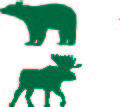 Moose . . . . . . . . . . . . . . . . . . . . . . . . . . . . . . . . . . . . . . . . . 83
Moose . . . . . . . . . . . . . . . . . . . . . . . . . . . . . . . . . . . . . . . . . 83